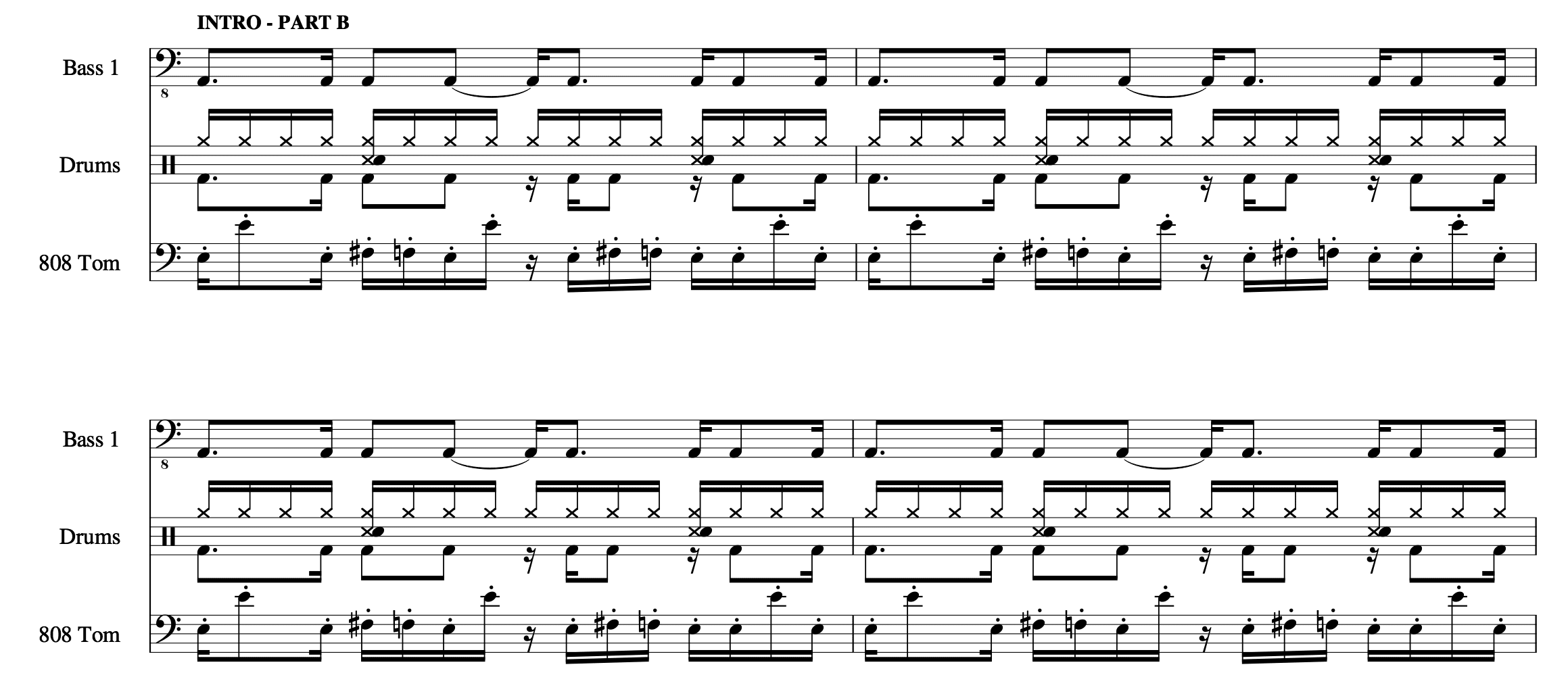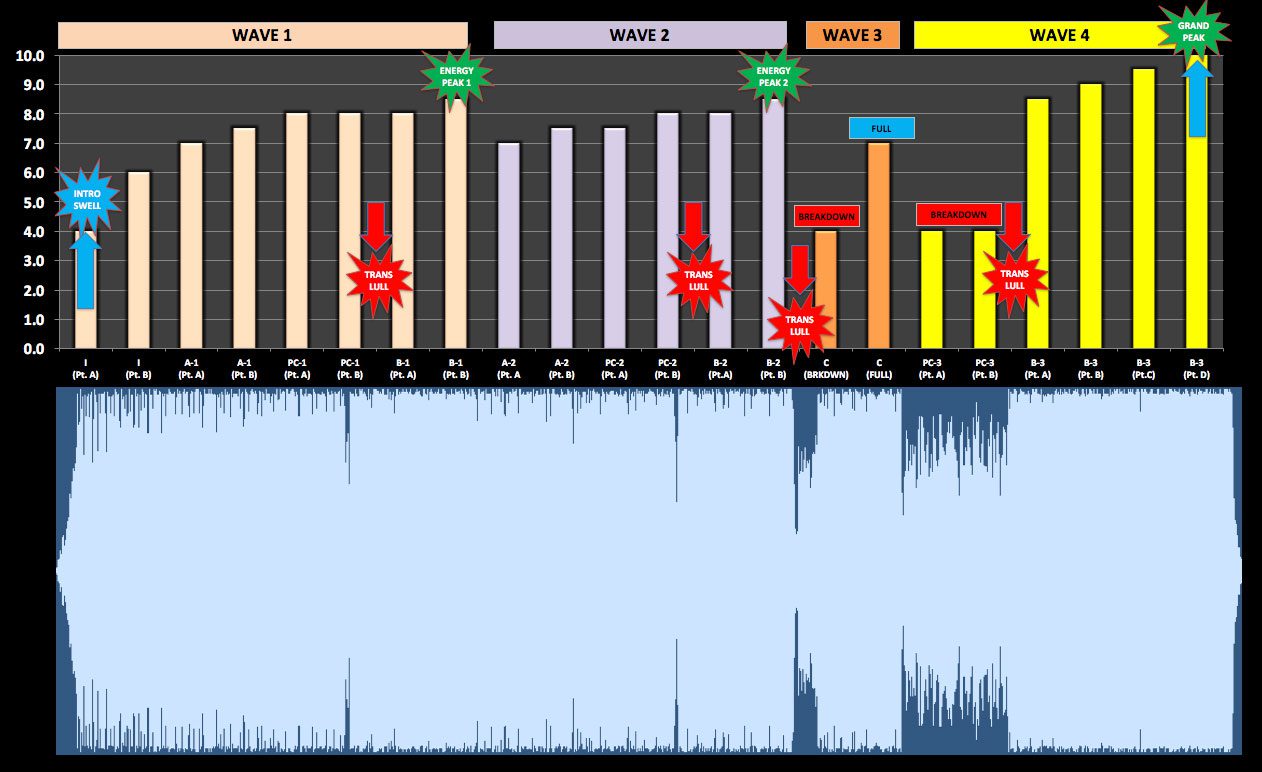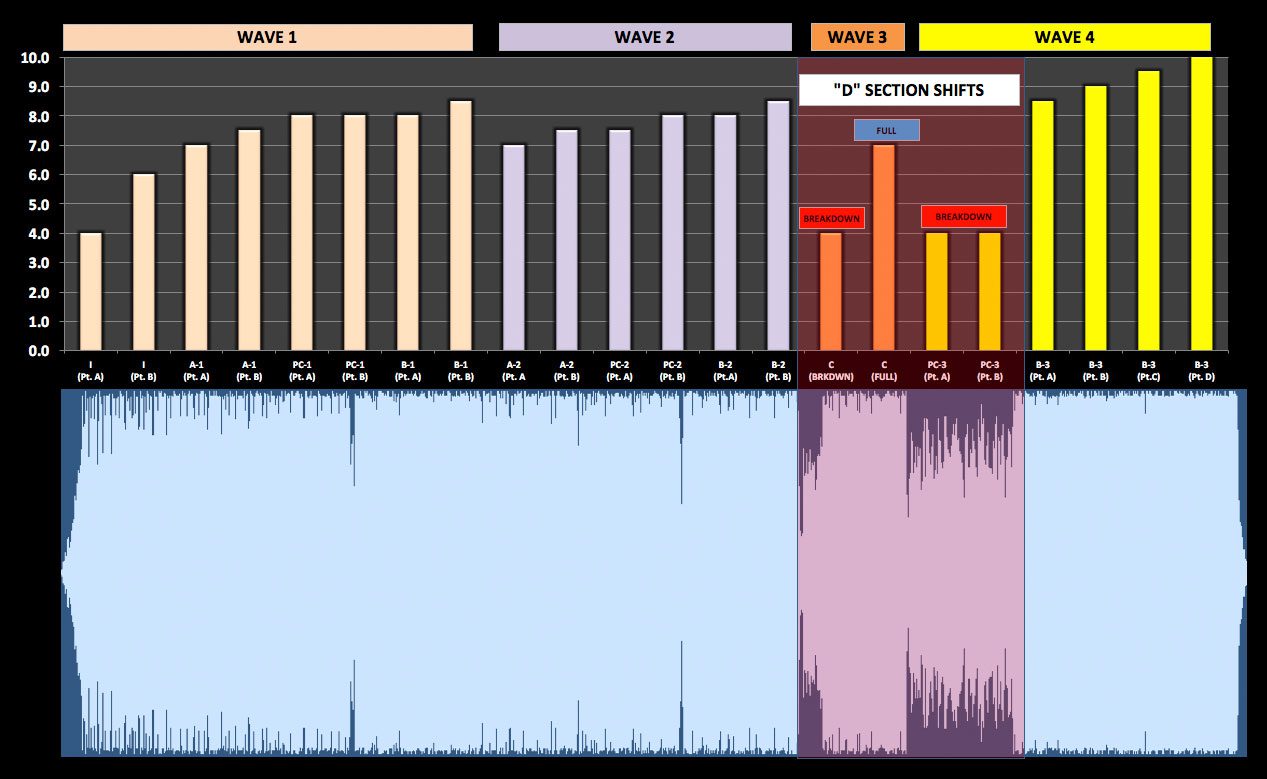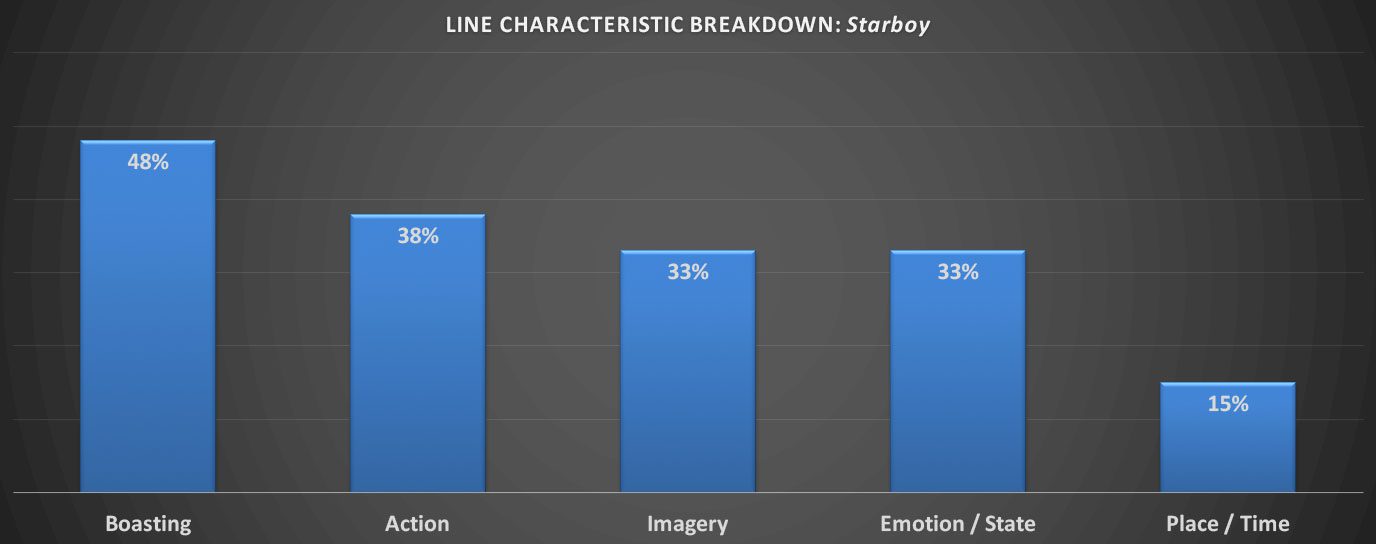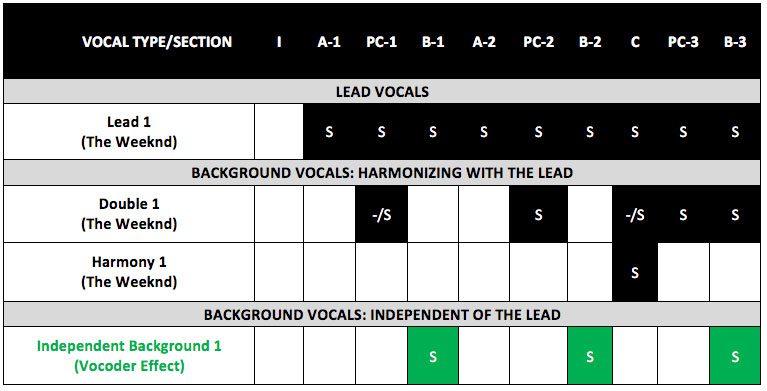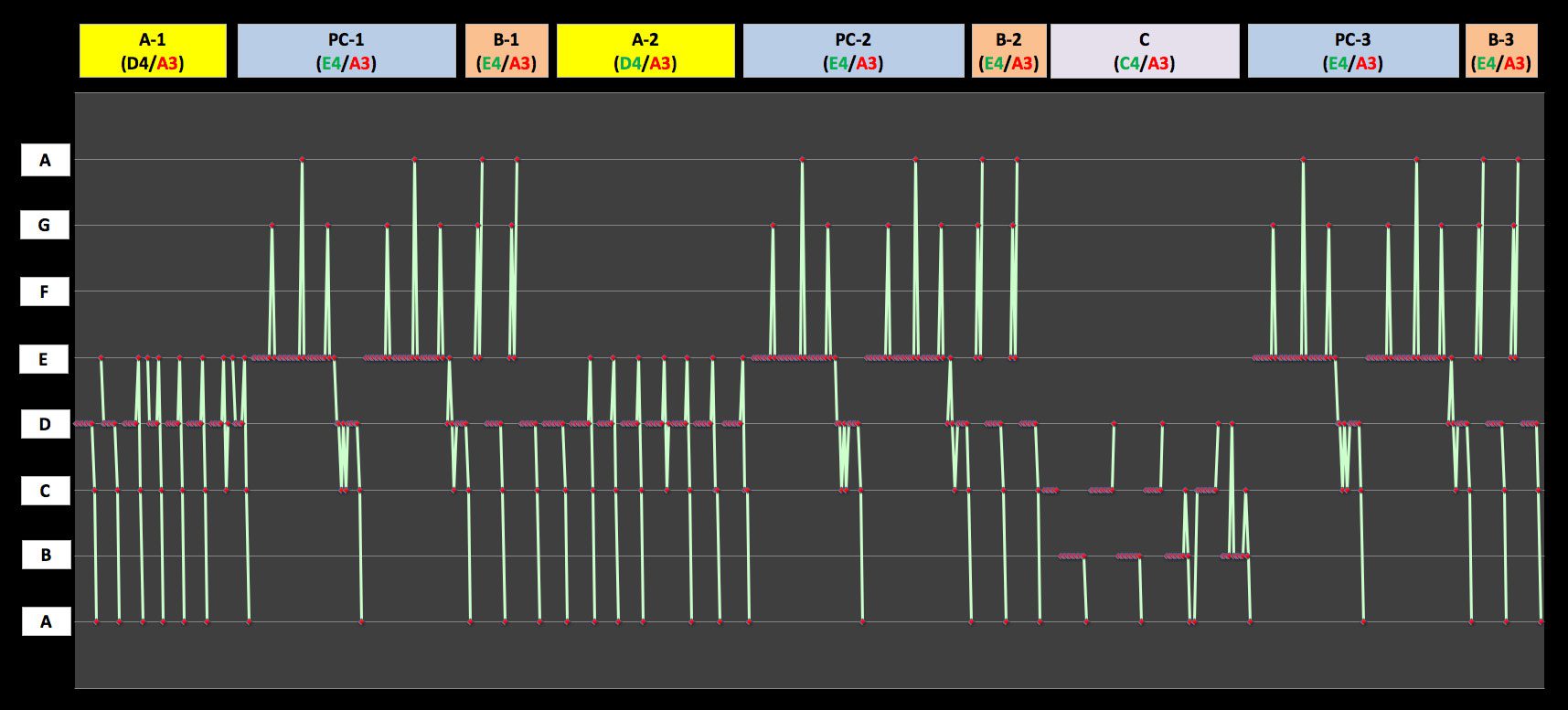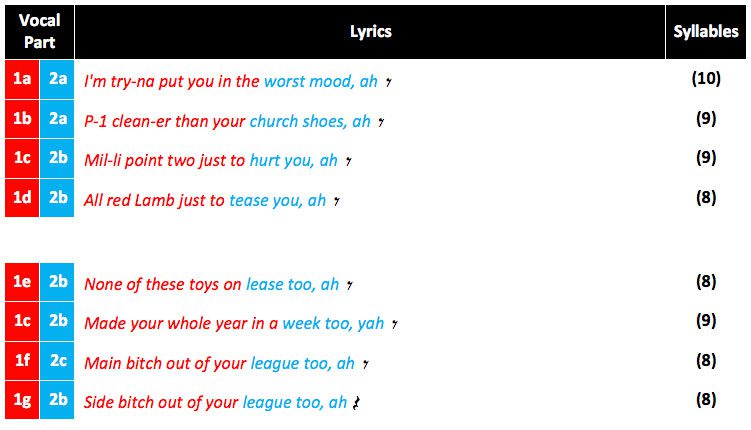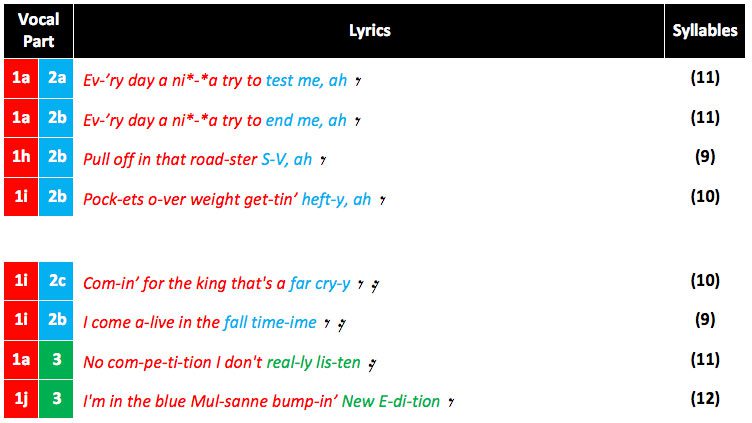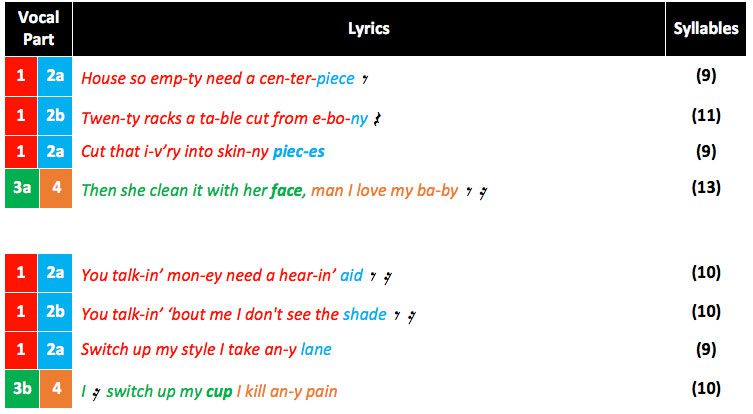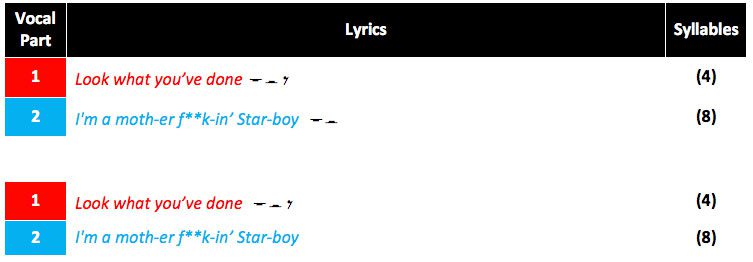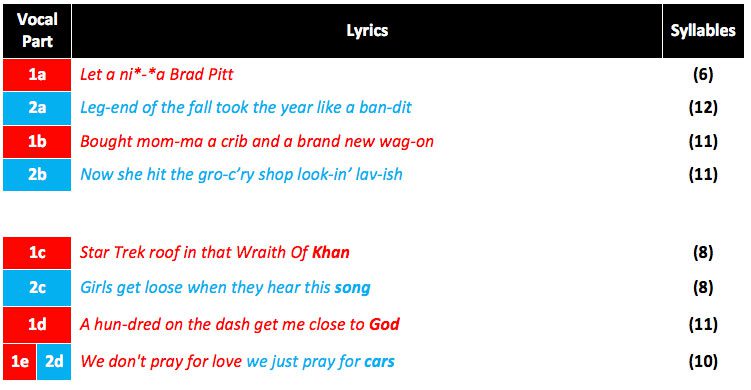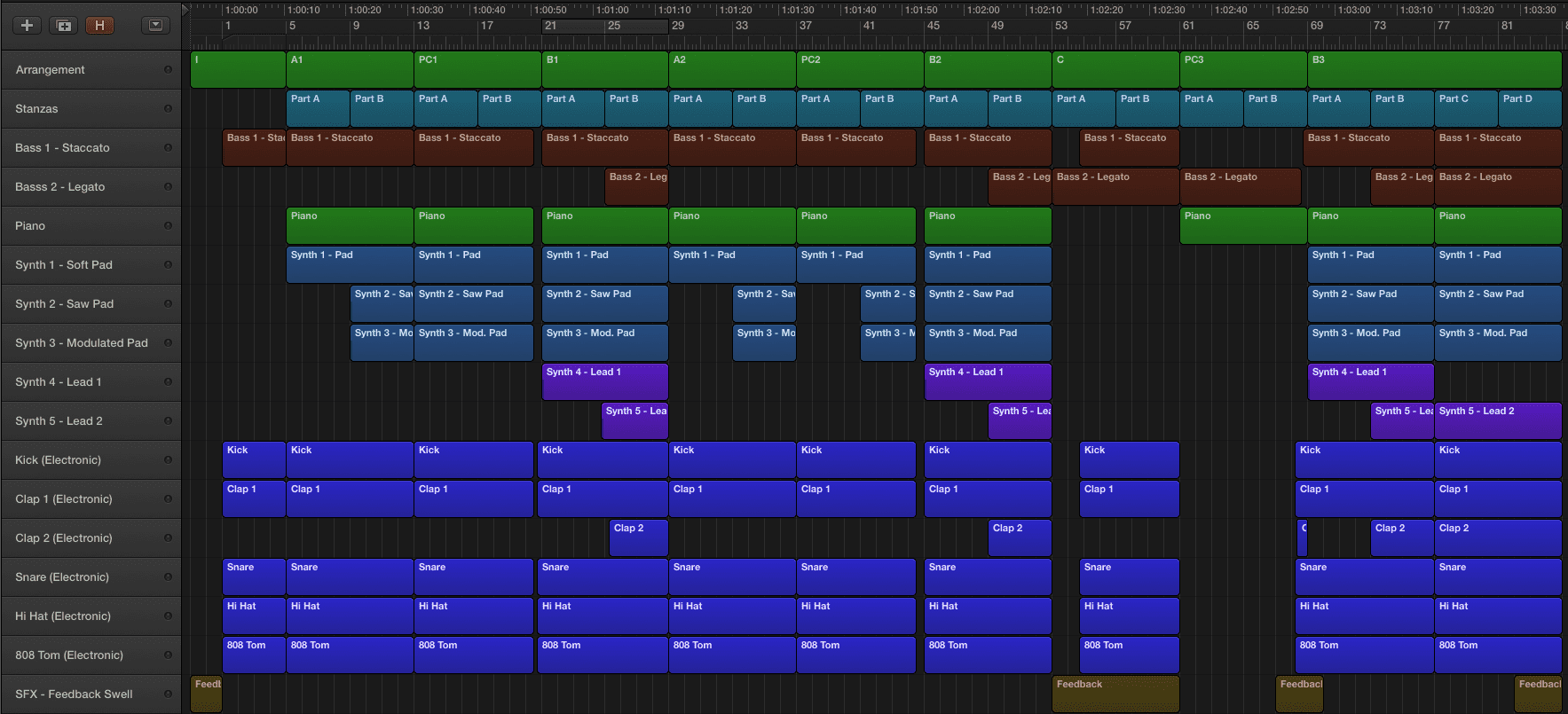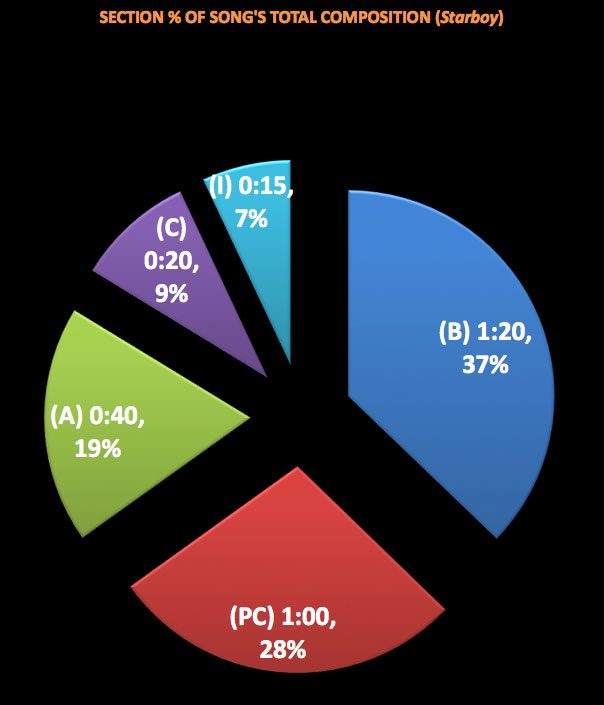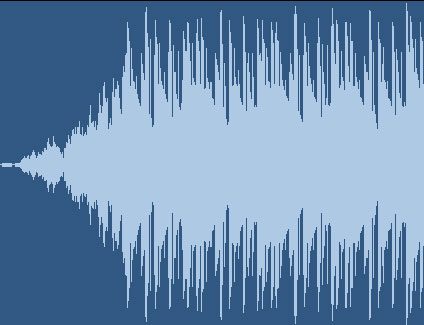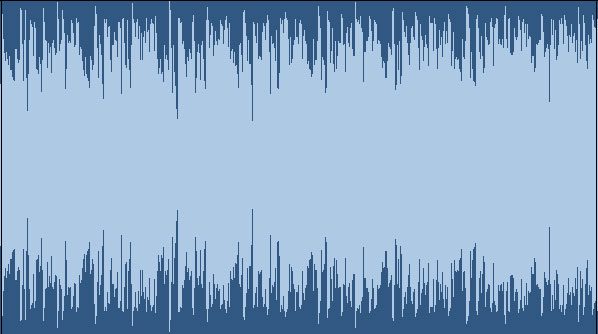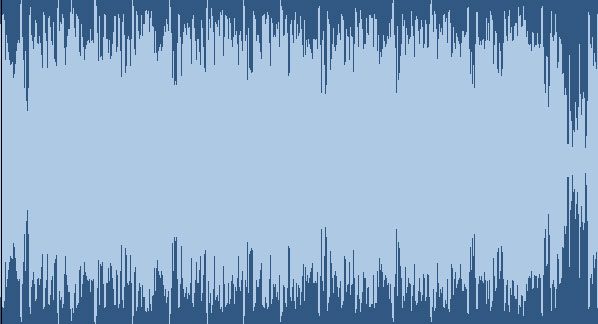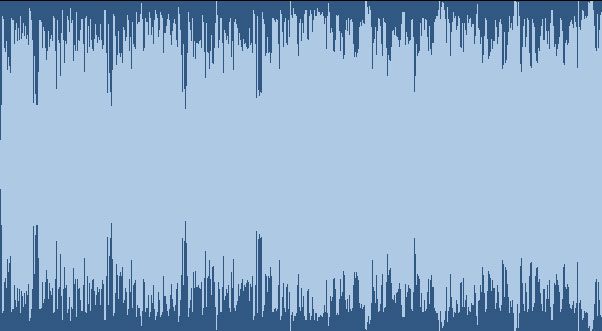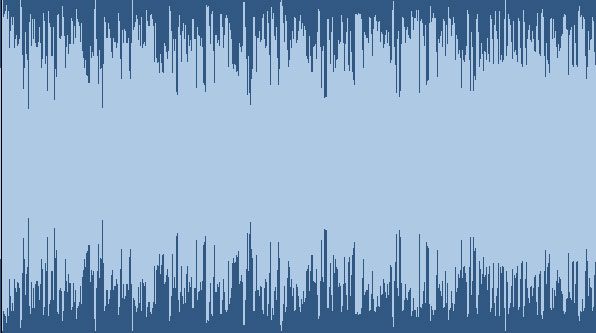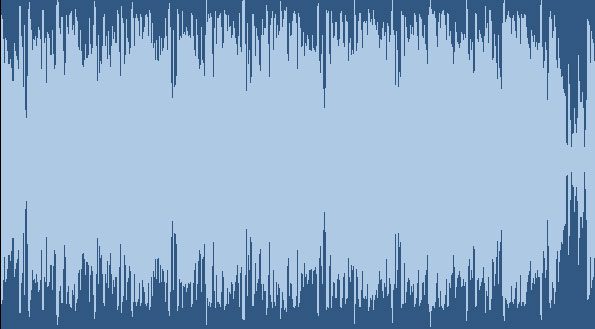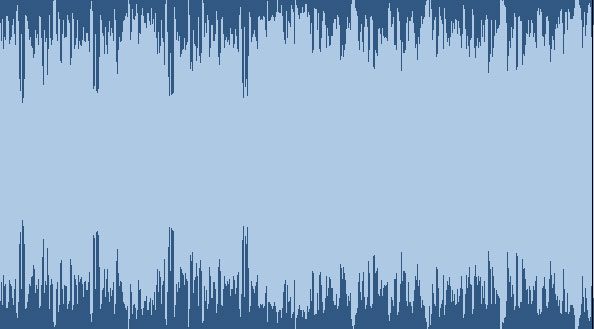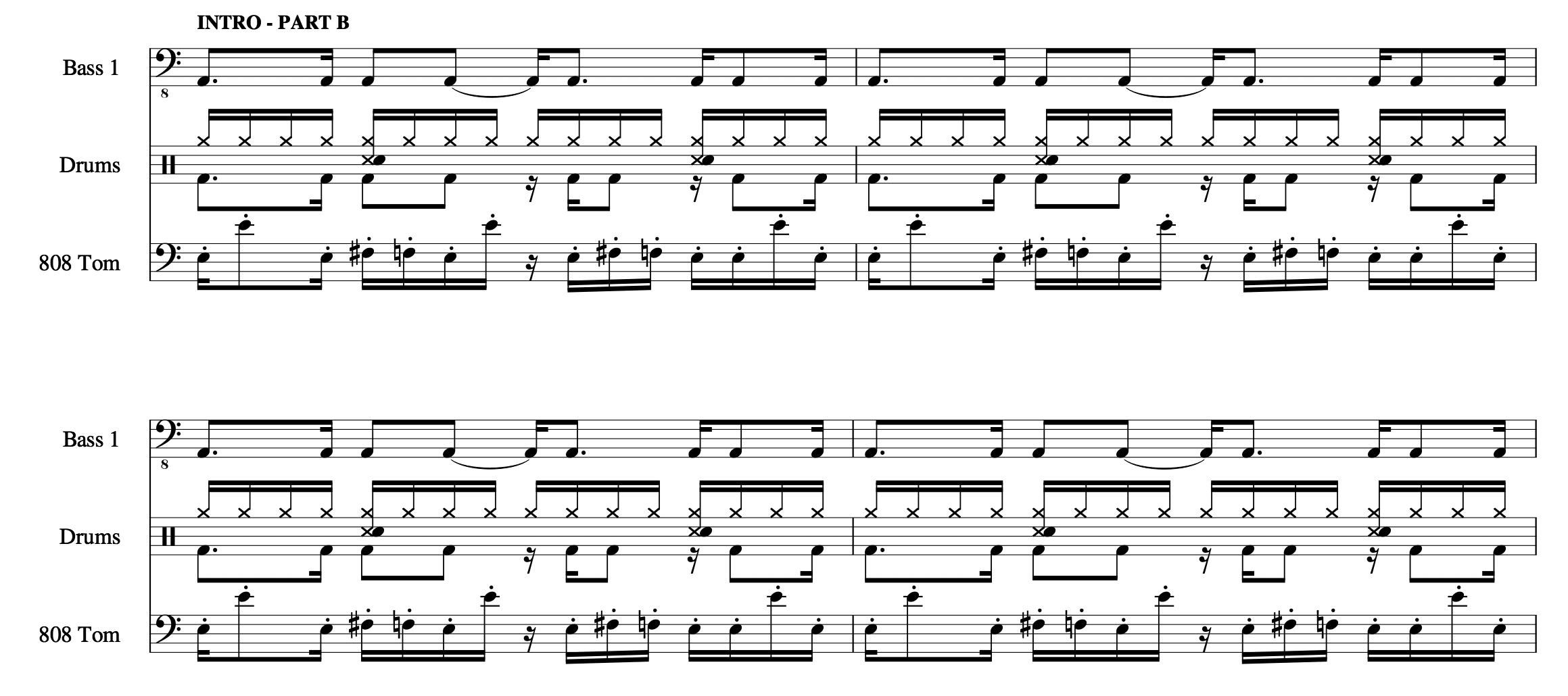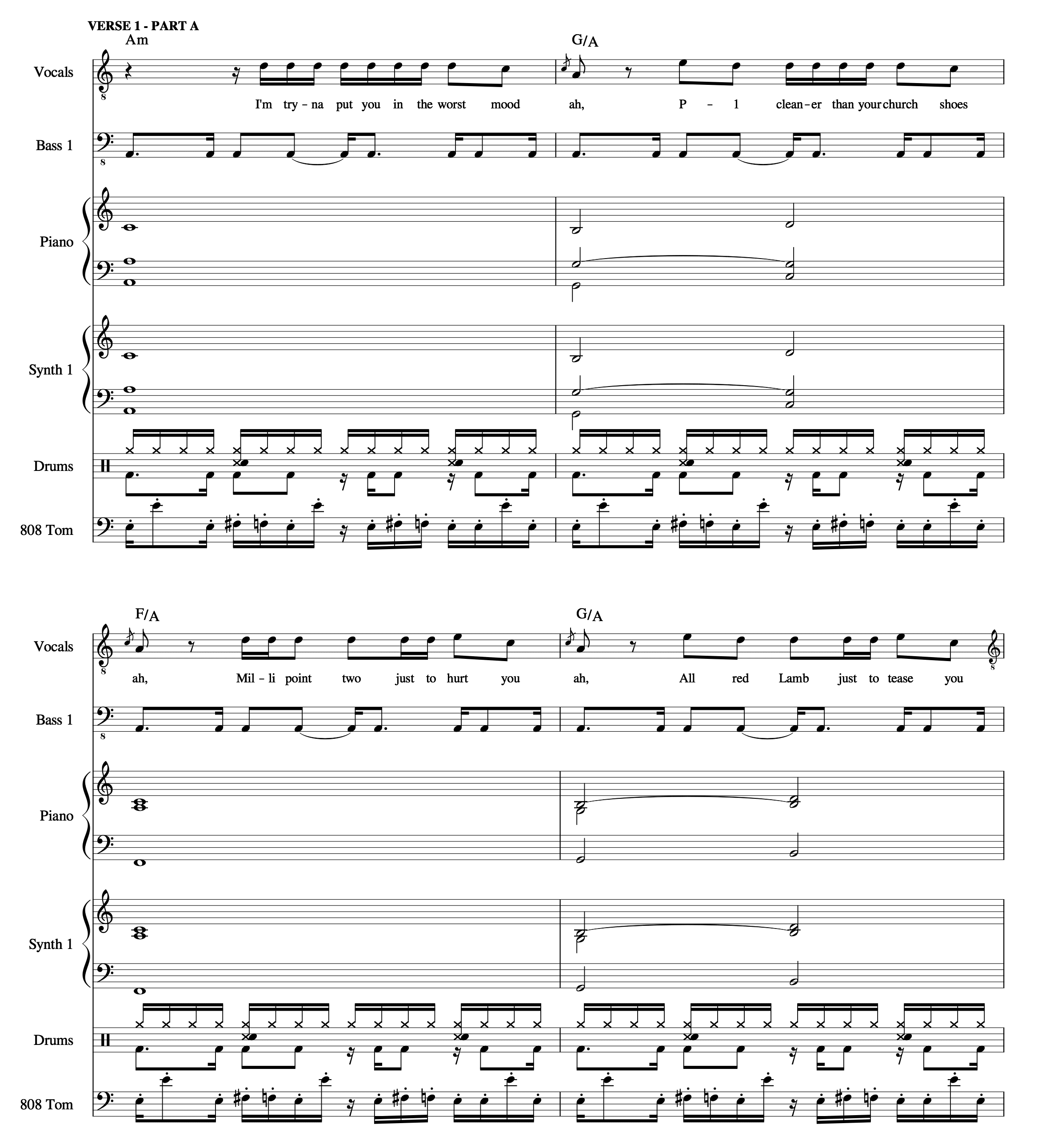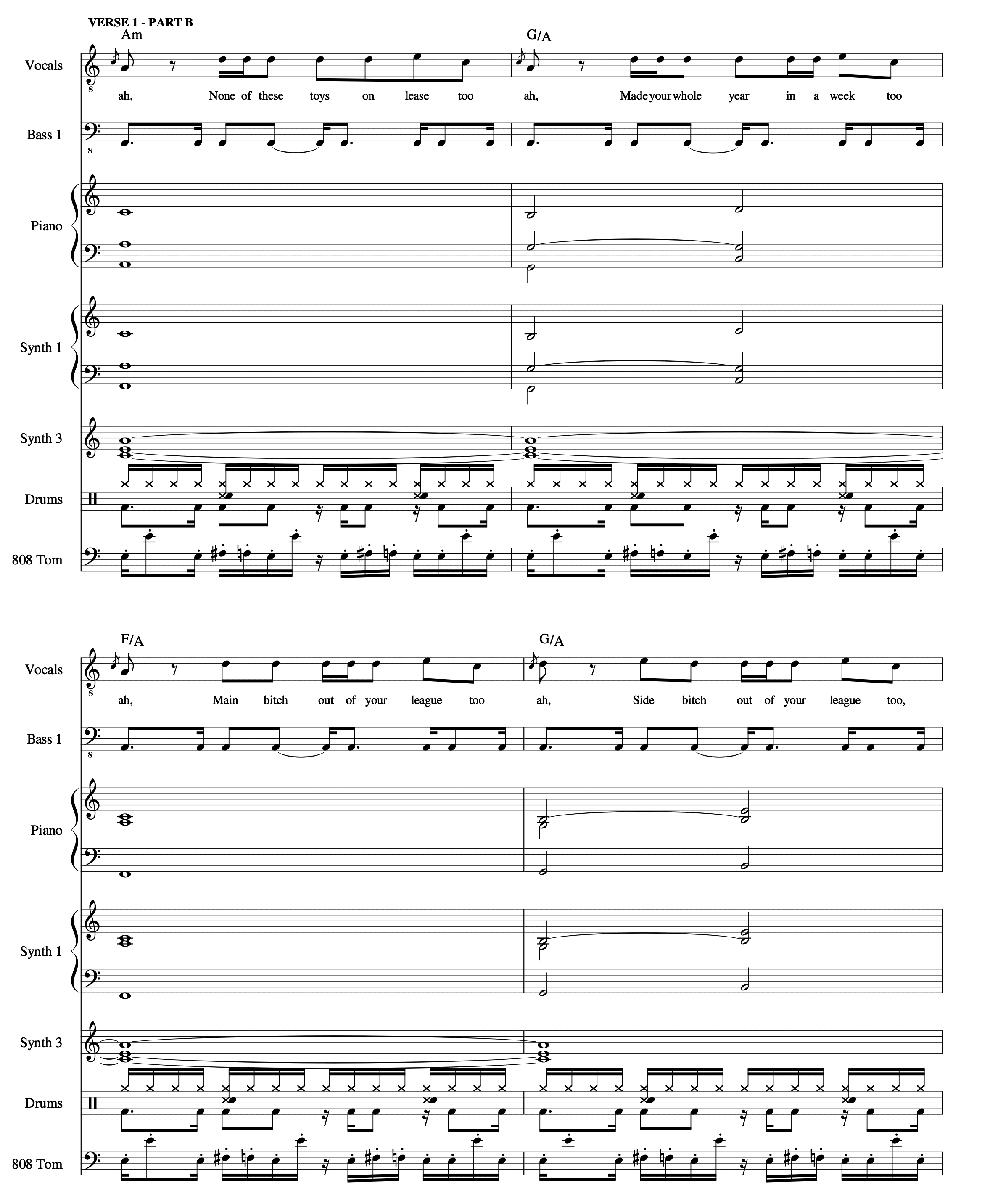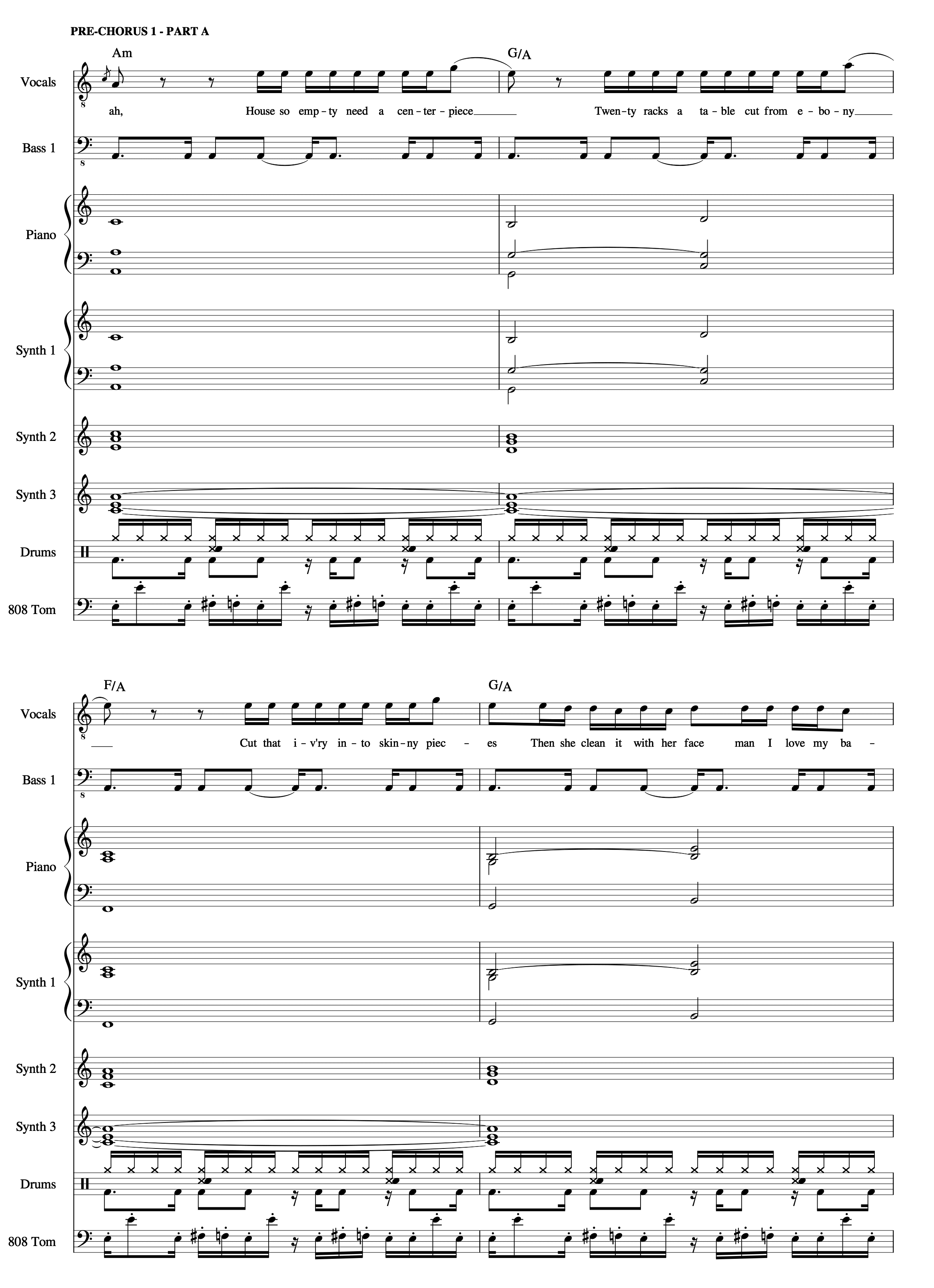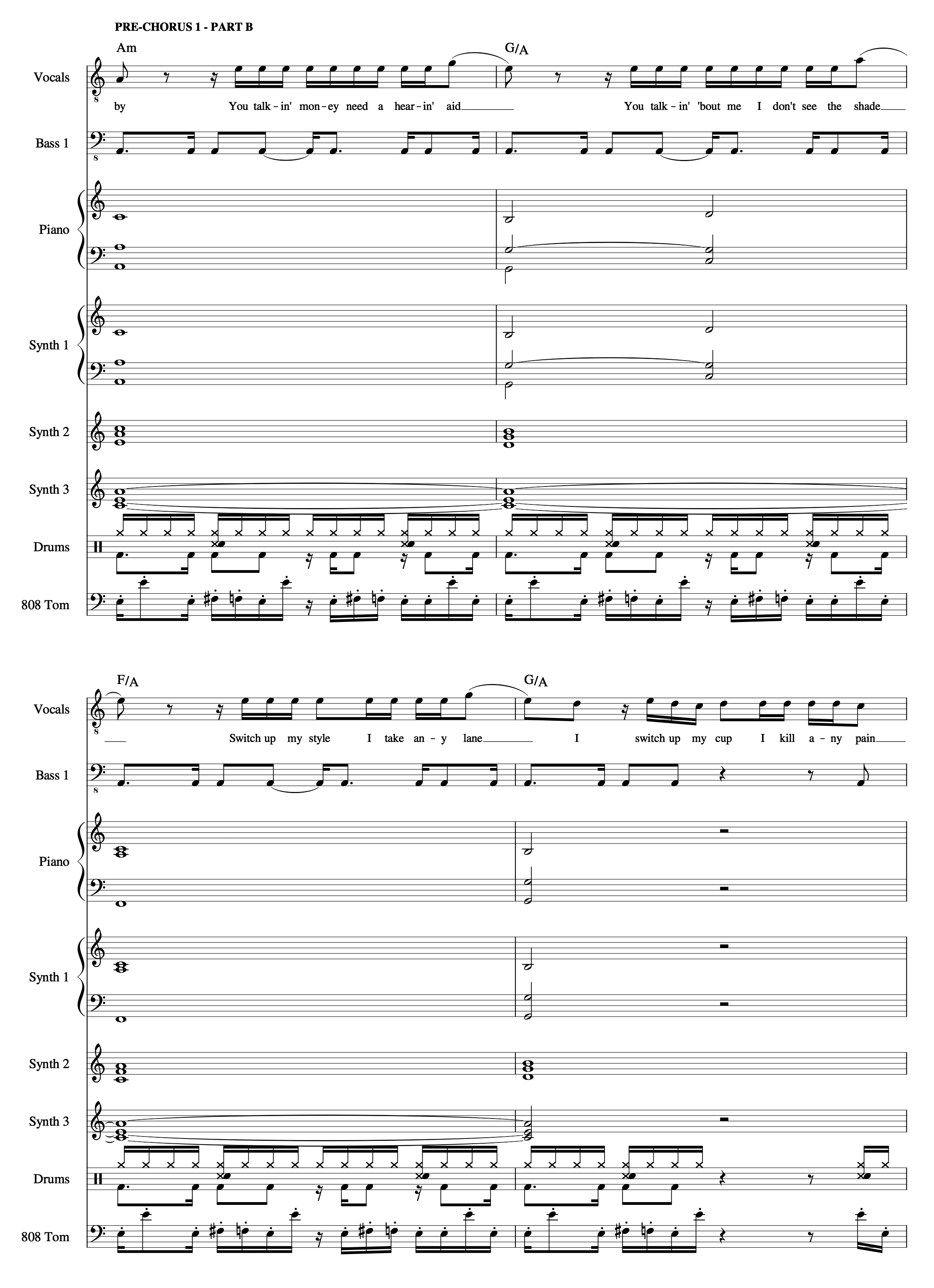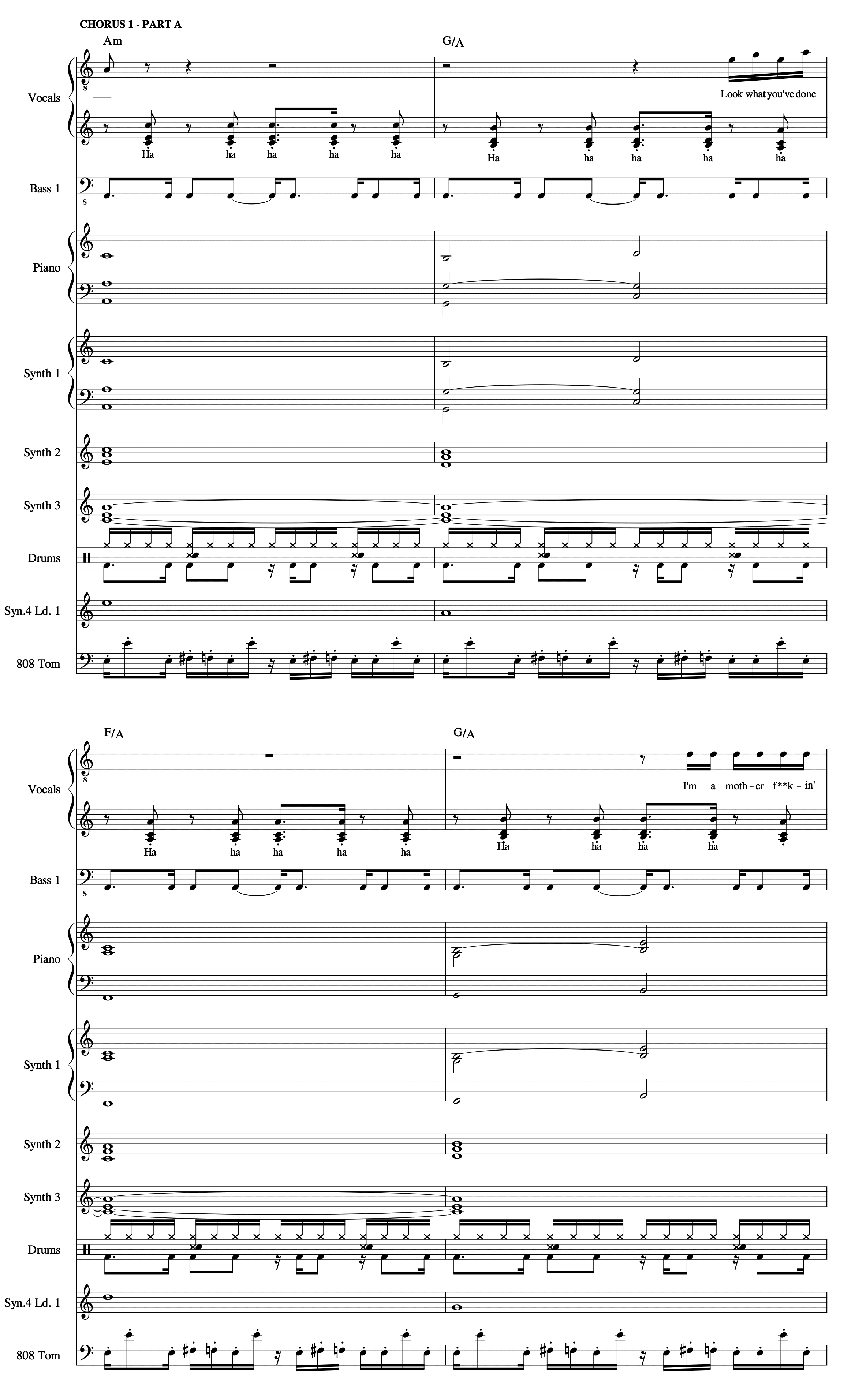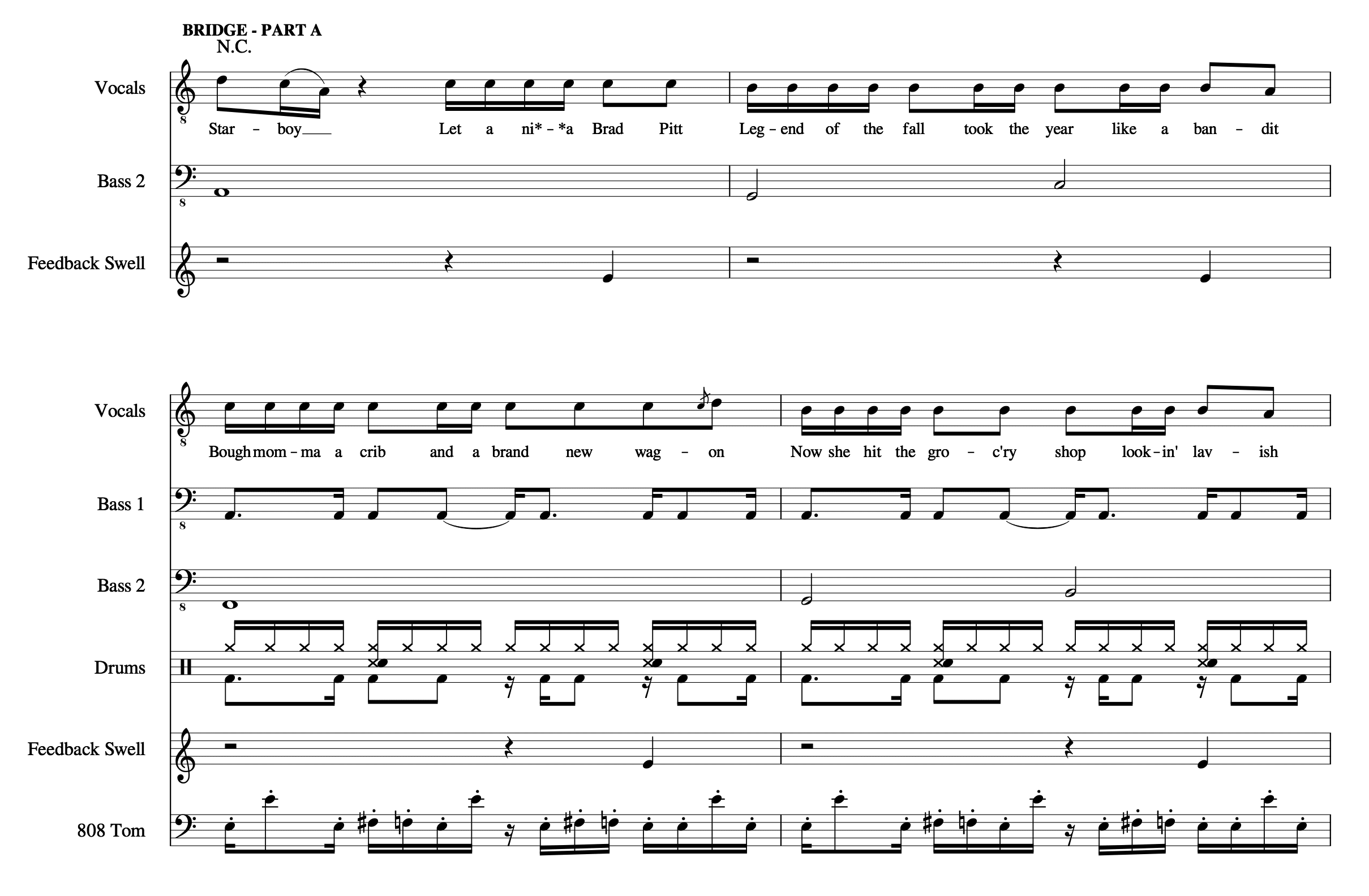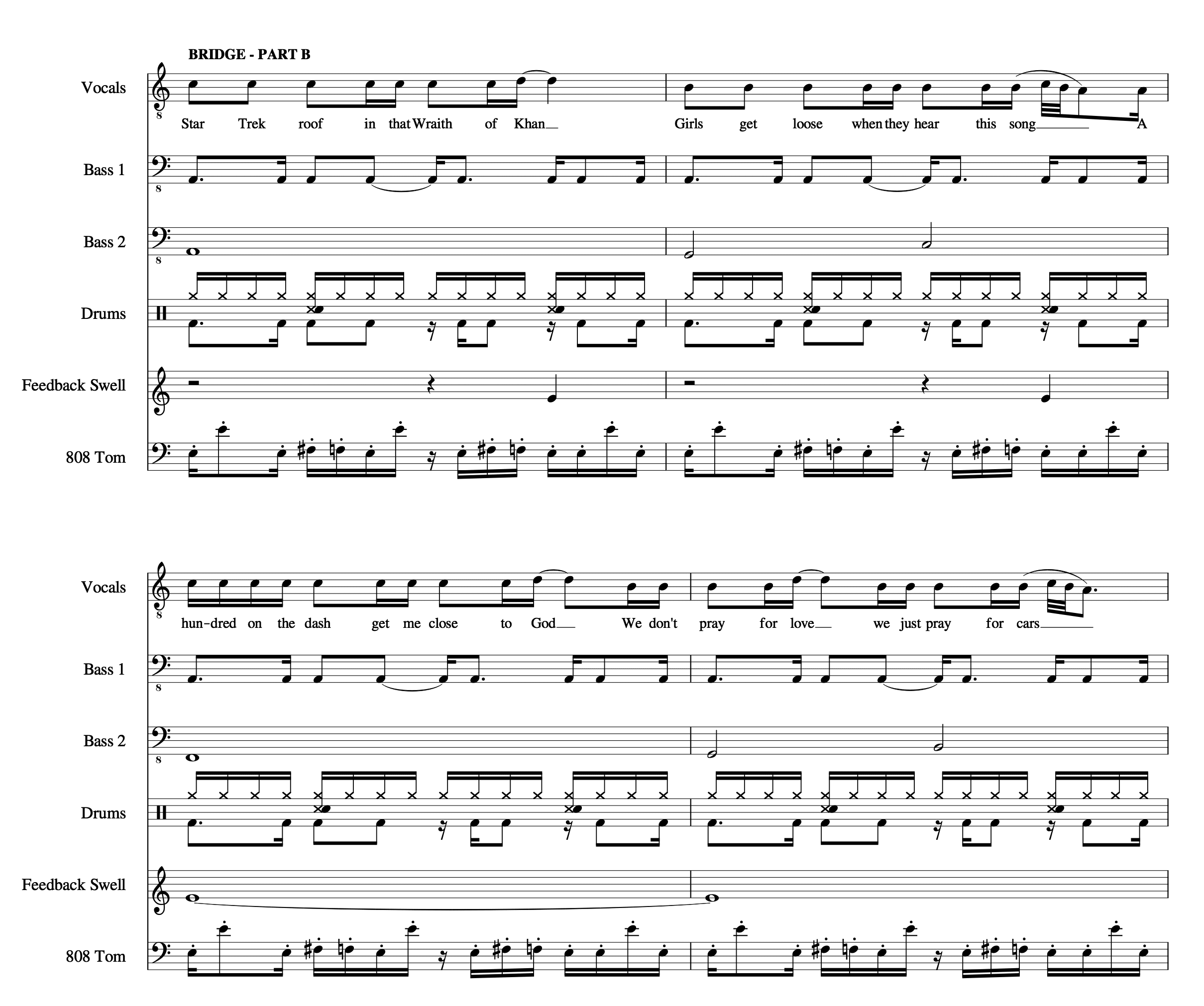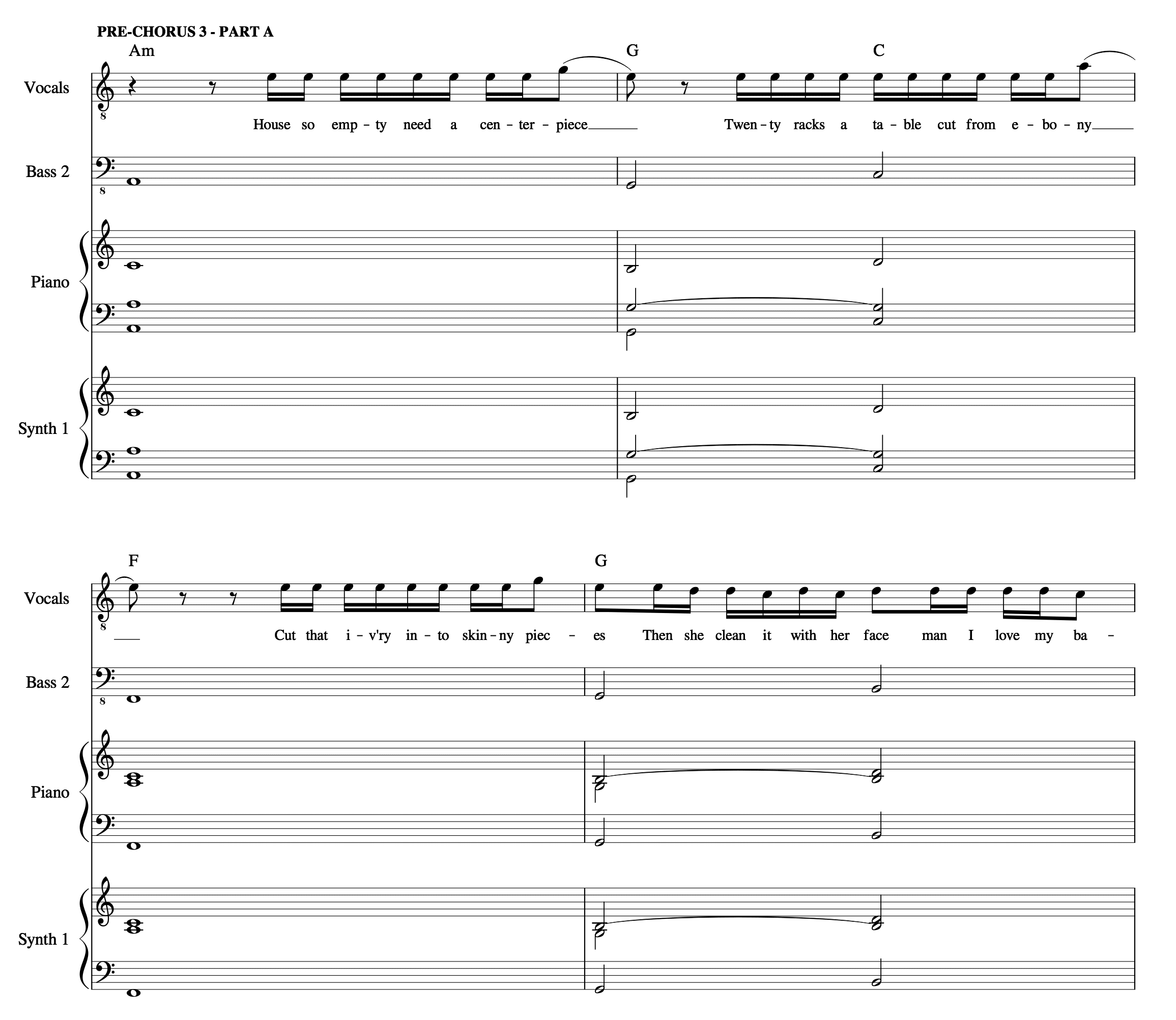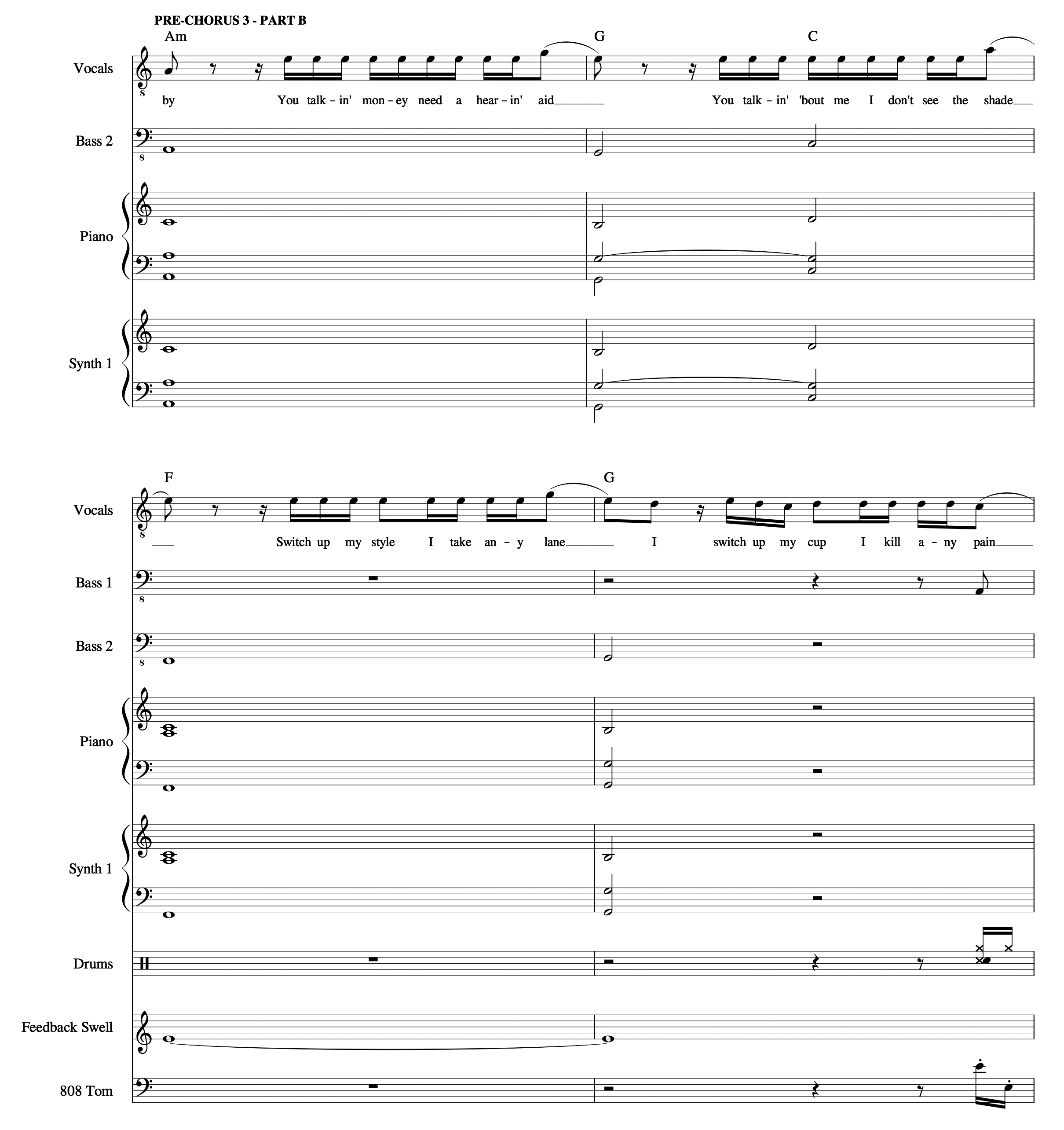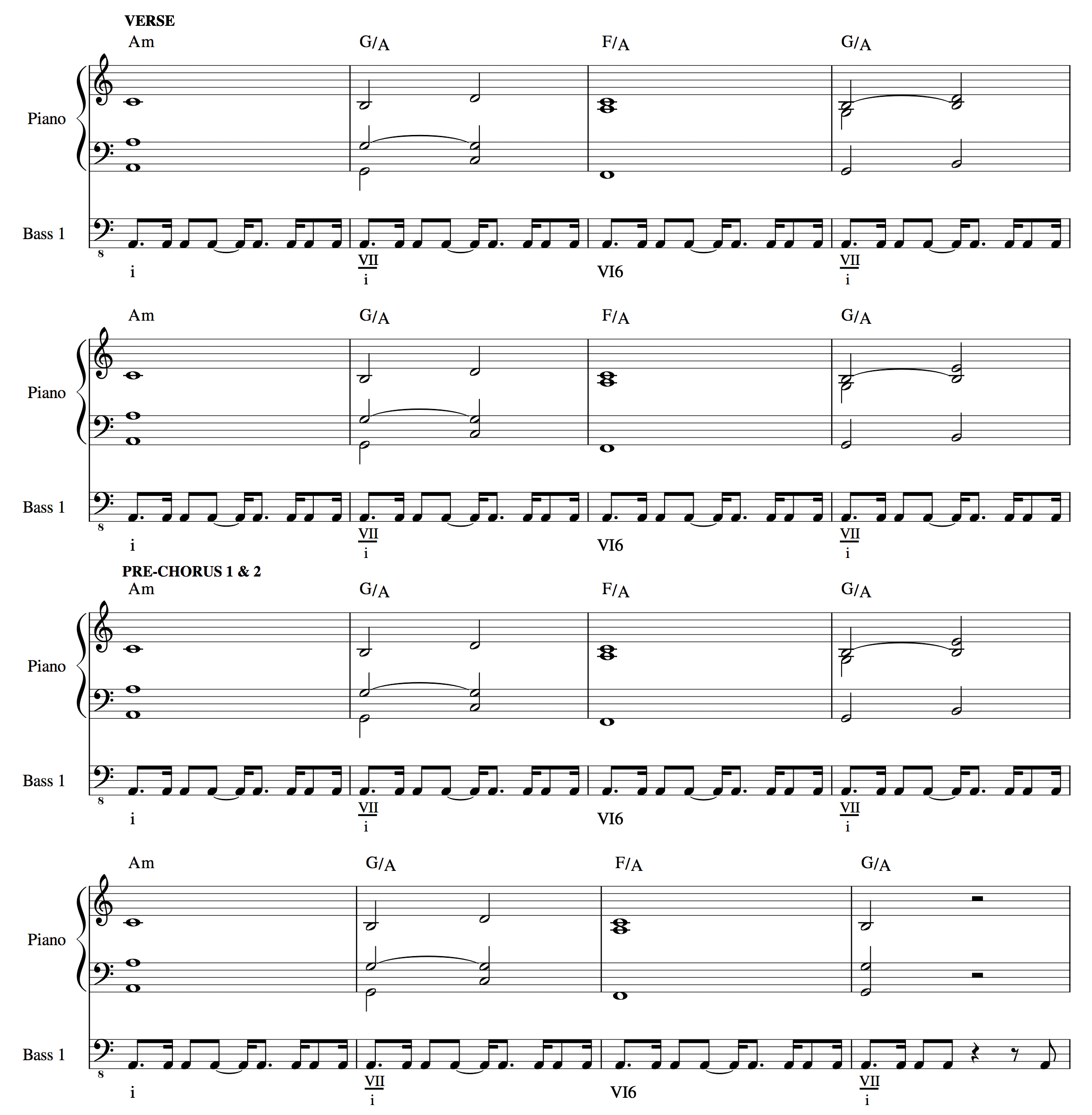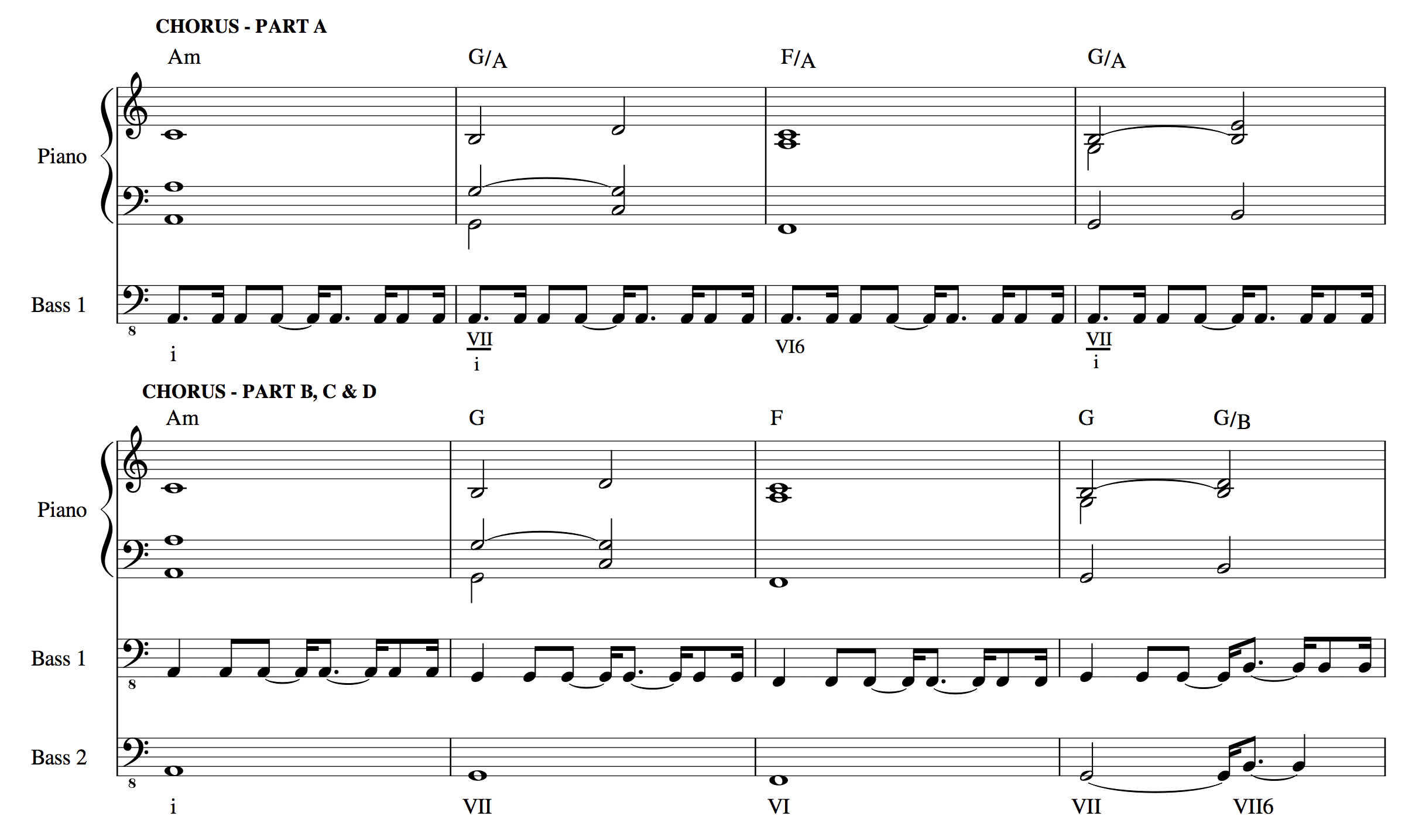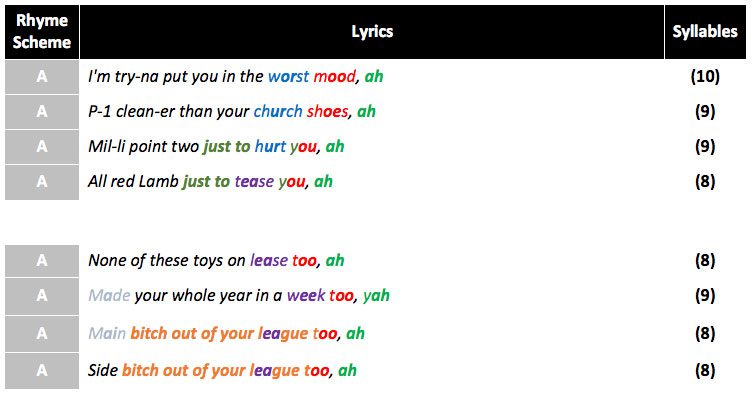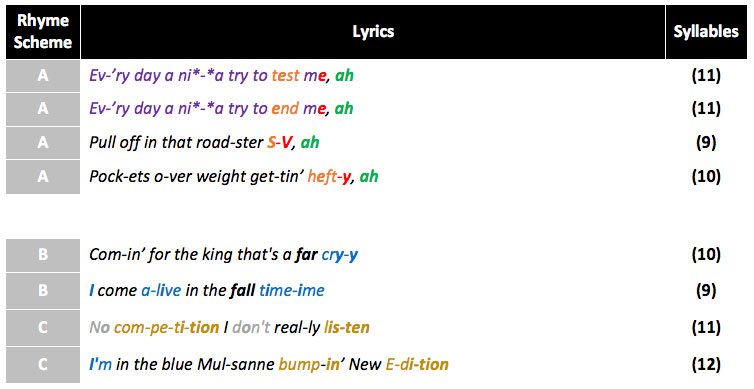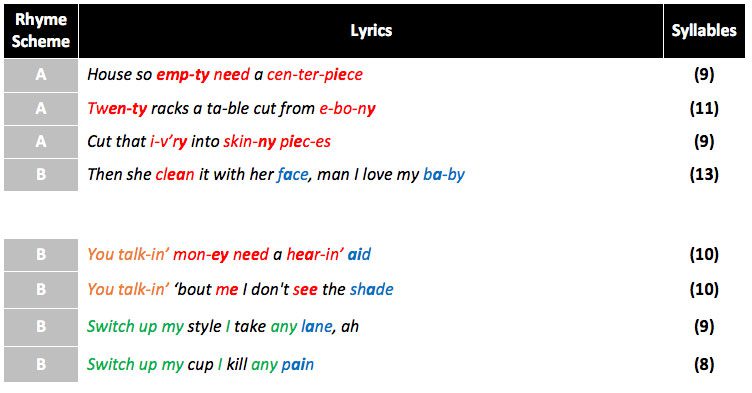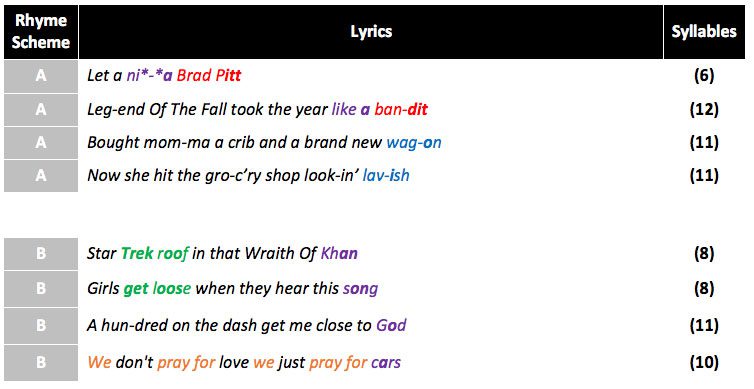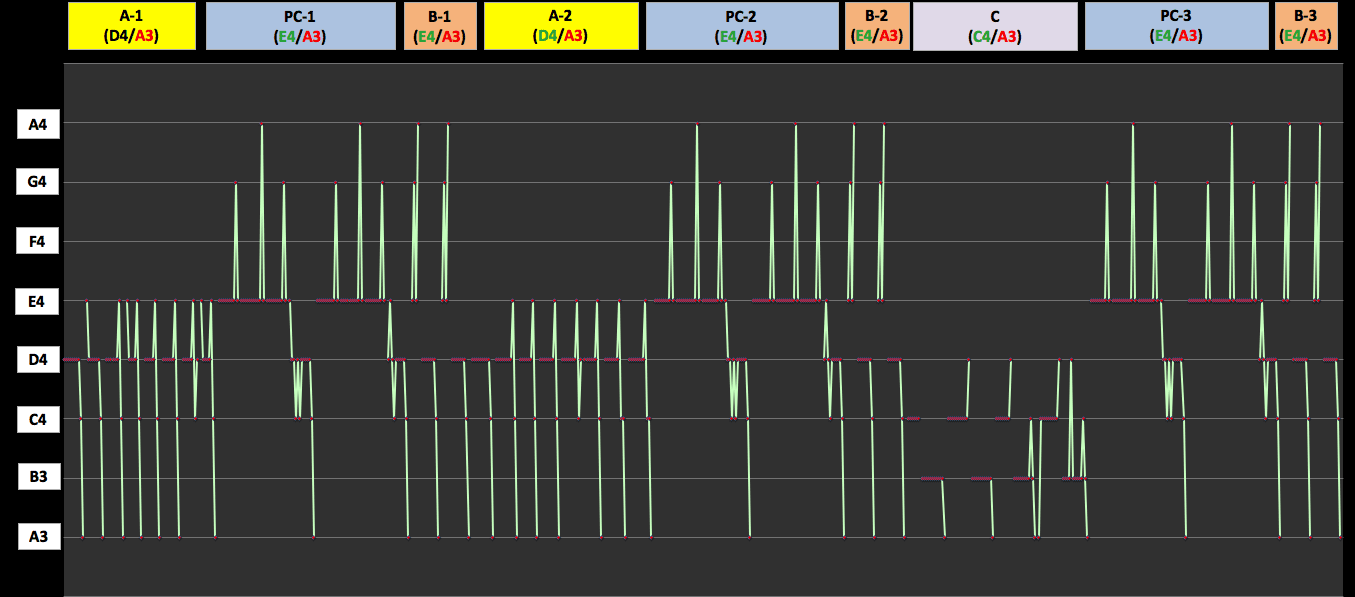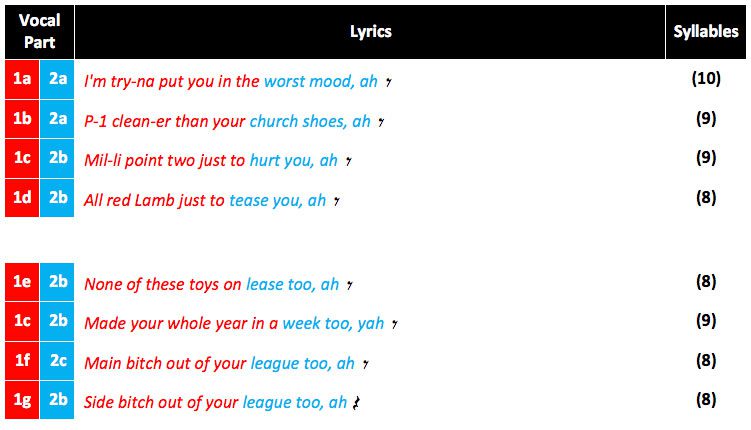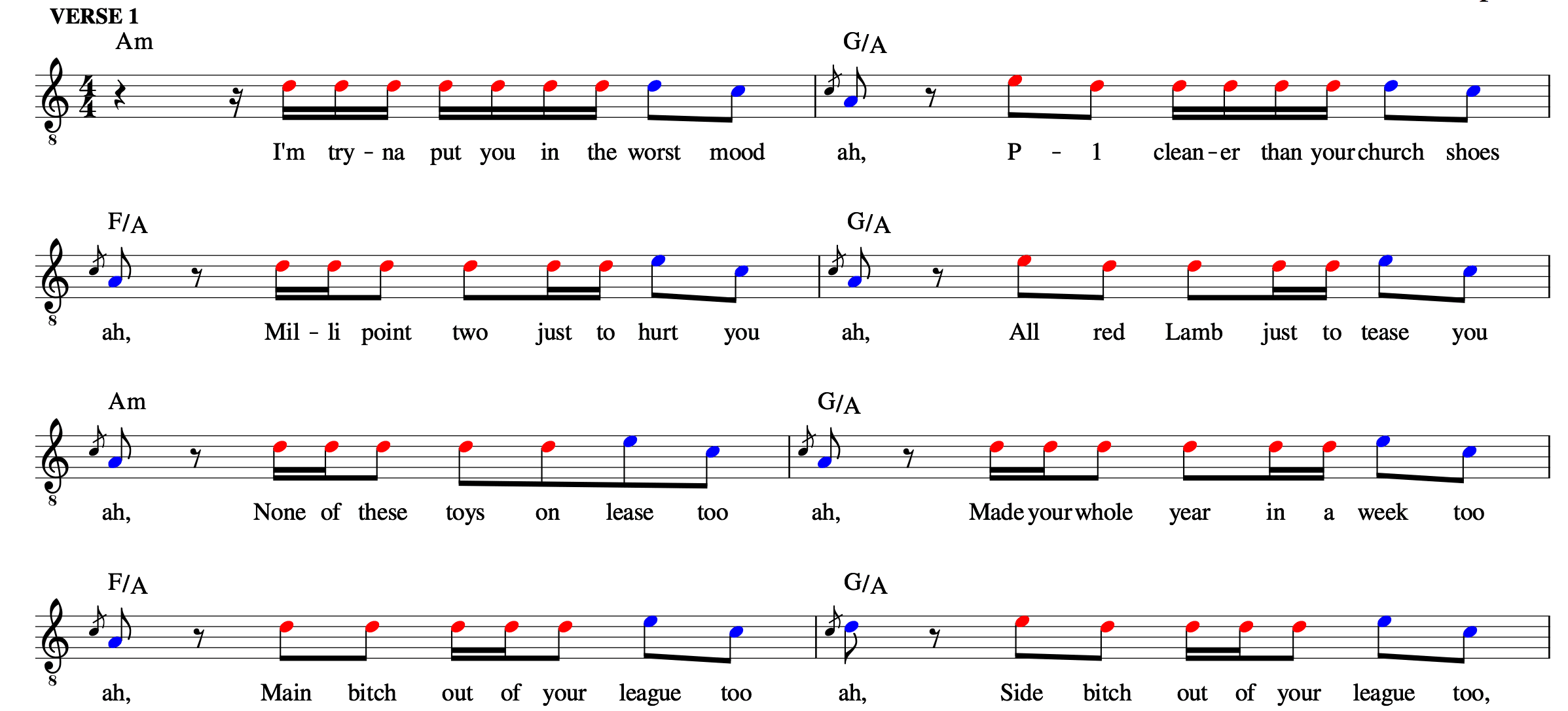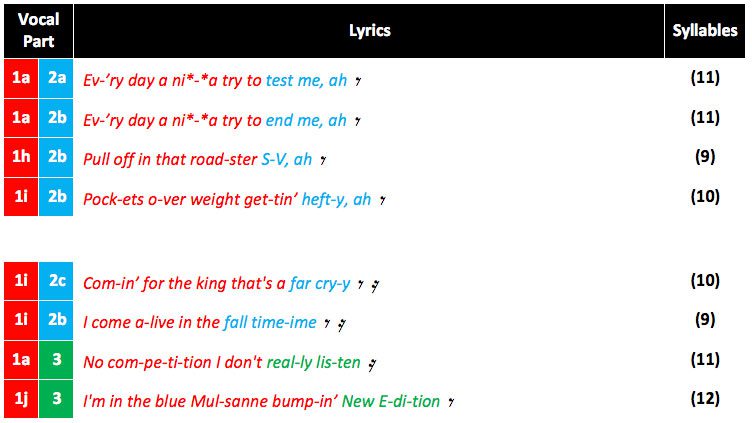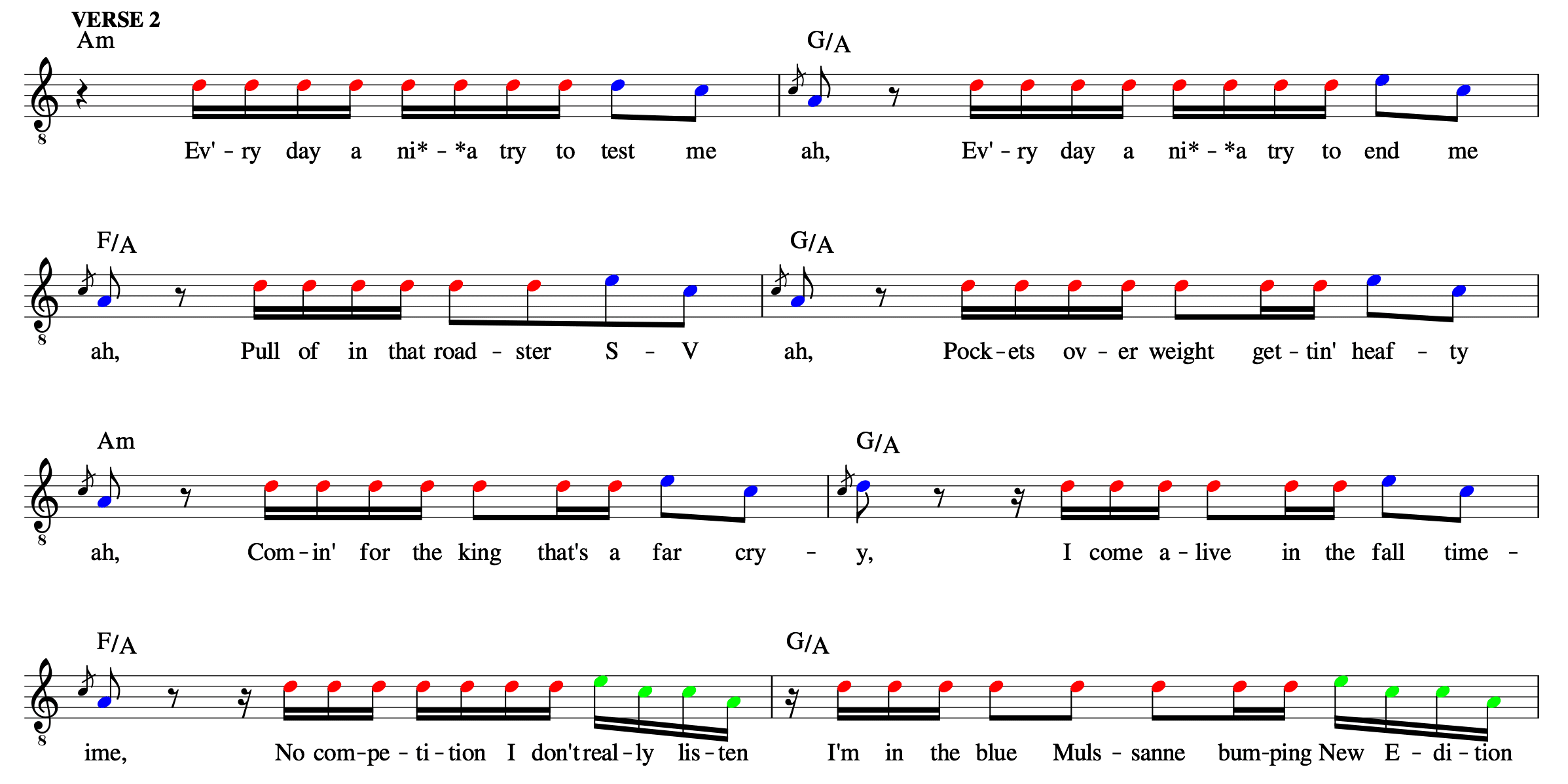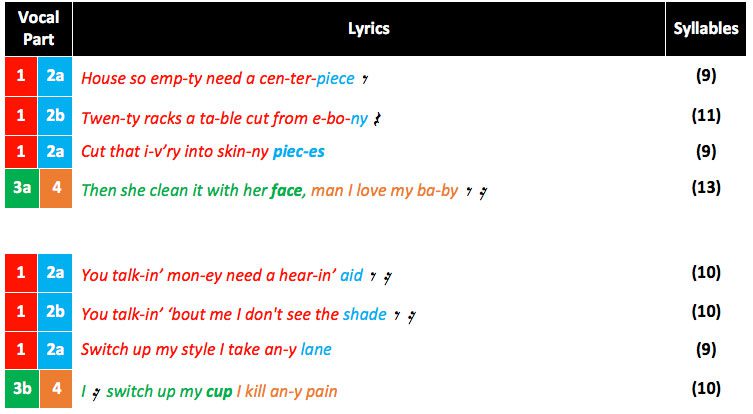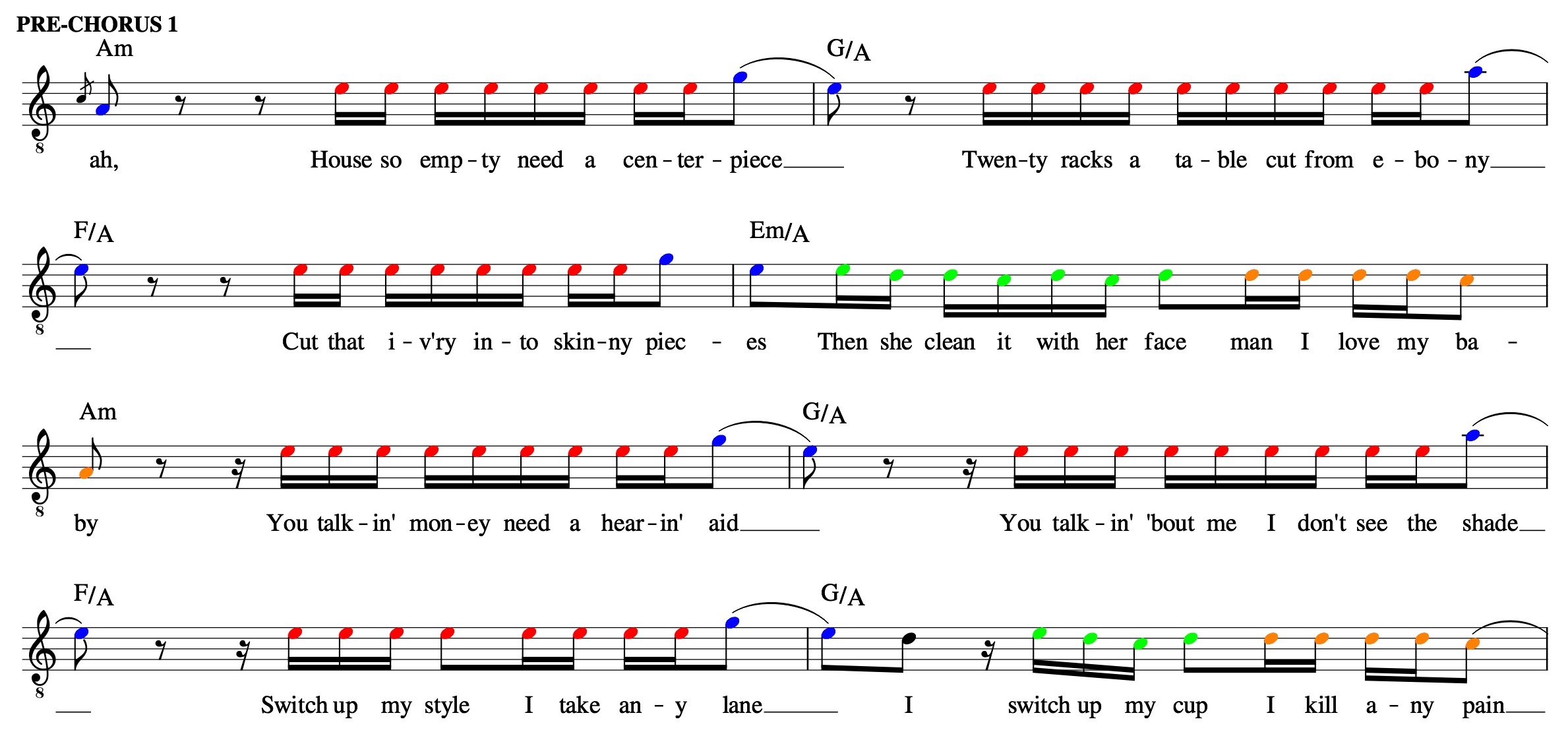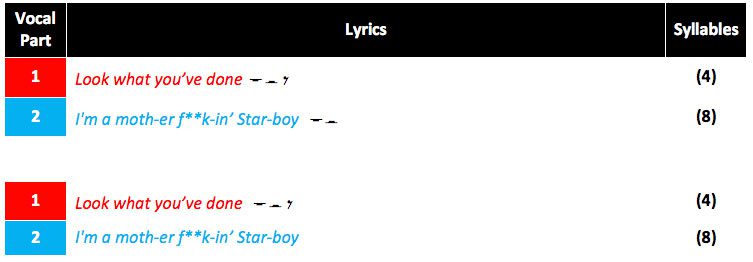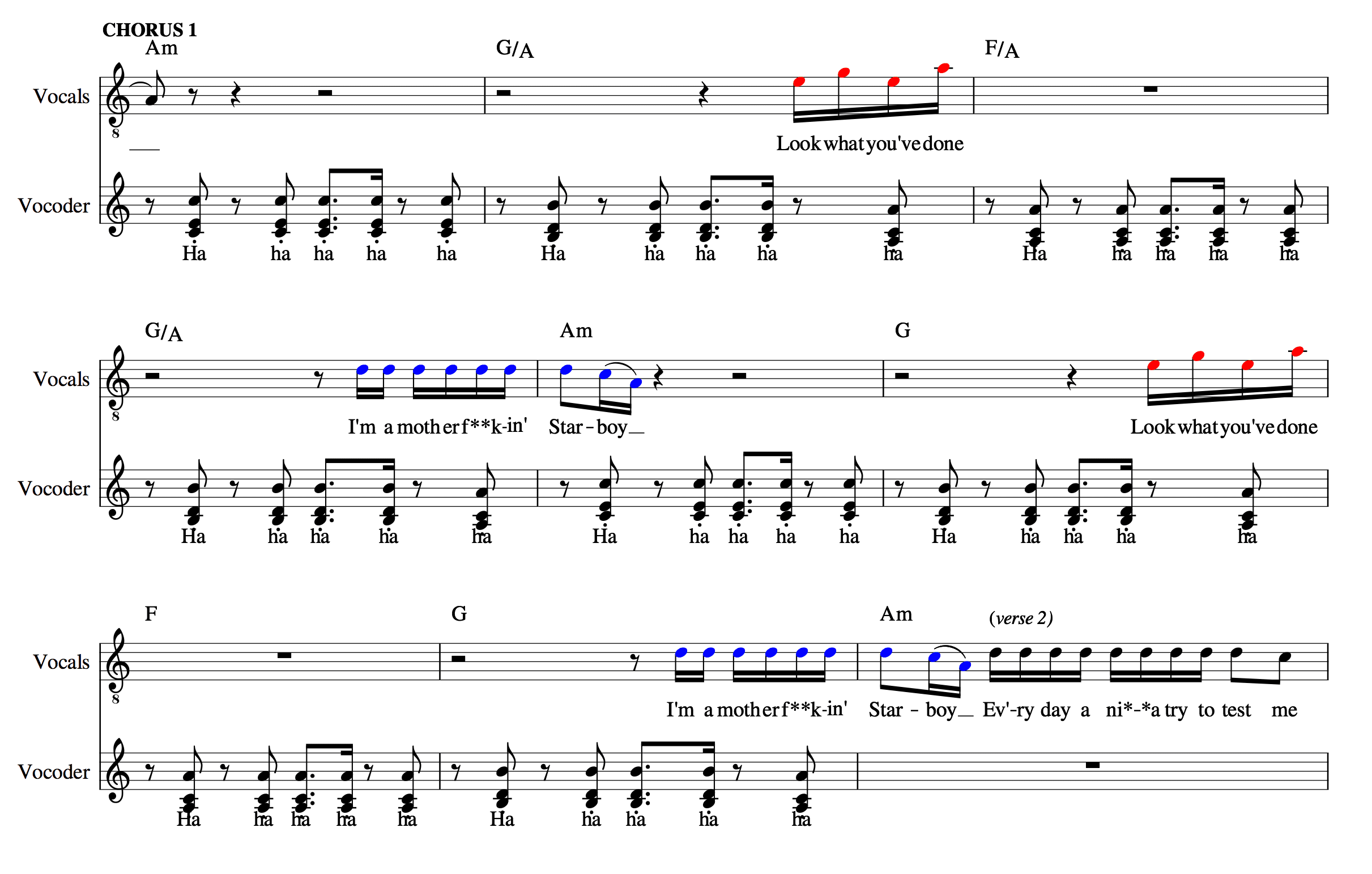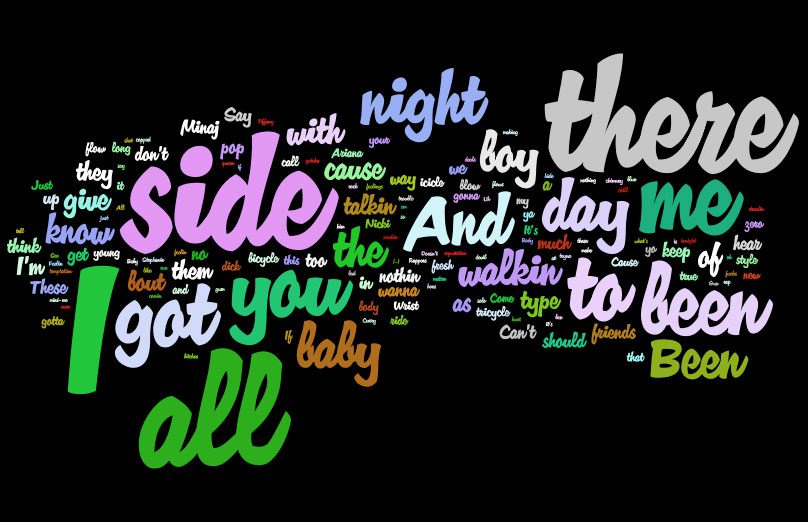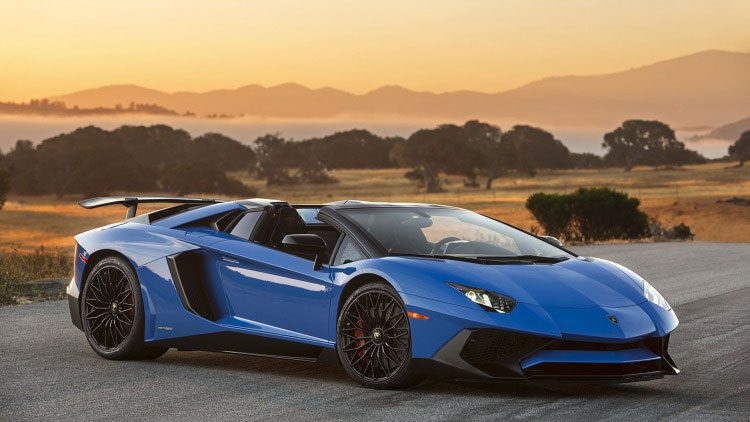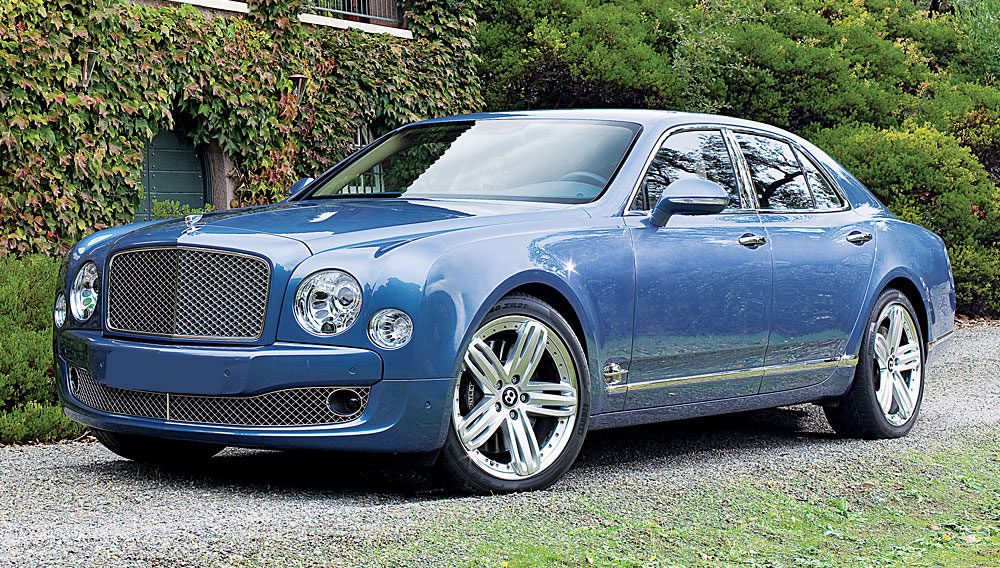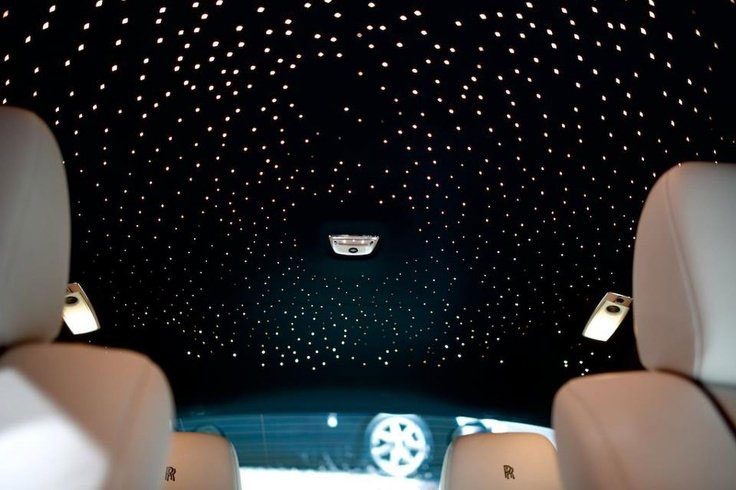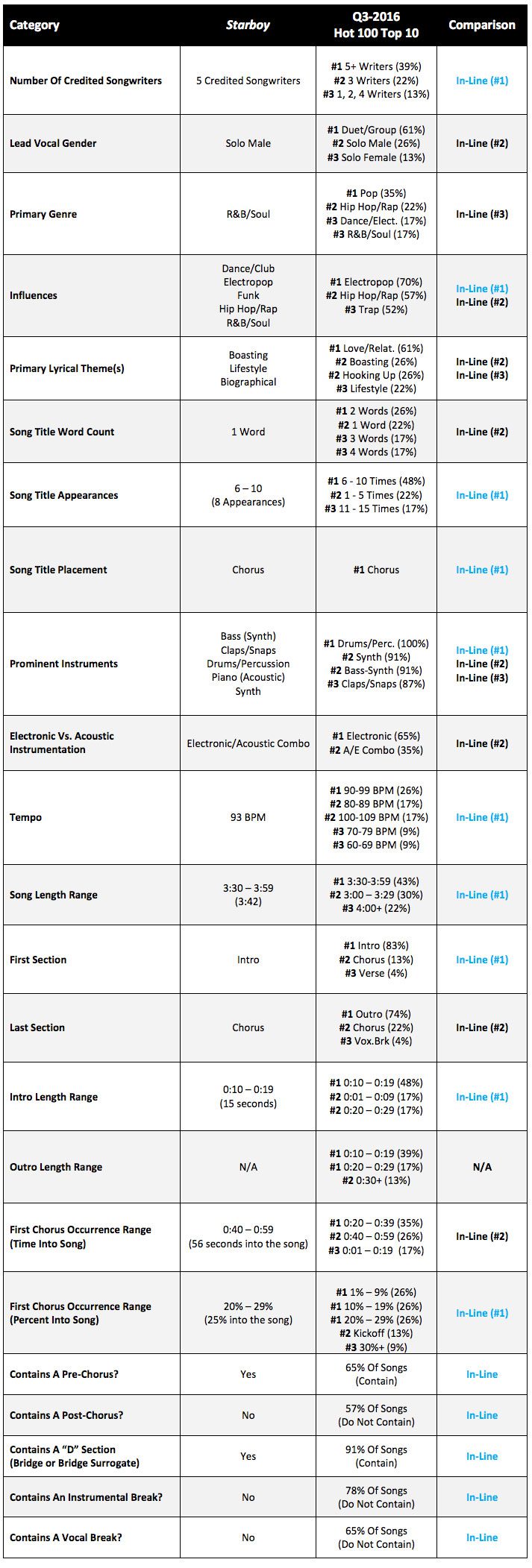To read this report, please log in.
Log inStarboy was the first single released from The Weeknd’s 2016 album of the same name. A collaboration with EDM superstars Daft Punk, this dark, moody, cocky song struck a chord with listeners, landing in the Top 10 on over 40 charts throughout the world, and peaking at #1 on over 20.
Among the many standout characteristics that contributed to the song’s success are its potent biographical lyrics chock full of boasts, disses, and clever wordplay, an infectious drum/bass groove that locks the listener in and doesn’t let go, and a meticulously well-crafted chorus that lingers in the listener’s head long after the song has come to a conclusion.
Starboy Deconstructed takes a deep dive into the compositional and production characteristics that made the song so infectious, engaging and memorable, catapulting it into a global hit.
At a Glance
Artist/Group: The Weeknd featuring Daft Punk
Song: Starboy
Songwriters: Cirkut (Henry Walter), Martin McKinney, Guy-Manuel de Homem-Christo, The Weeknd (Abel Tesfaye), Thomas Bangalter, DaHeala (Jason Quennville)
Producers: The Weeknd, Doc McKinney, Cirkut
Record Label: Republic
Primary Genre: R&B/Soul
Influences: Dance/Club, Electropop, Funk, Hip Hop/Rap, R&B/Soul
Length: 3:42
Full Form: I-A-PC-B-A-PC-B-C-PC-B
Key: Am
Tempo: 93 BPM
First Chorus: 0:56 / 25% of the way into the song
Intro Length: 0:15
Electronic vs. Acoustic: Electronic/Acoustic Combo
Prominent instruments: Bass (Synth), Claps/Snaps, Drums/Perc, Piano (Acoustic), Synth
Primary Lyrical Theme(s): Biographical, Boasting, Lifestyle
Title Appearances: Starboy appears 8 times in the song
Lyrical P.O.V: 1st , 2nd, 3rd
Section Abbreviation Key
I=Intro
A=Verse
PC=Pre-Chorus
B=Chorus
C=Bridge
IB=Instrumental Break
VB=Vocal Break
T=Turnaround
O=Outro
As is typically the case with Top 10-charting hits (with the primary exception being some EDM-influenced songs), the chorus functions as Starboy’s primary sectional payoff. Key aspects that make the section so infectious, engaging and memorable include:
Engaging Call & Response Lead Vocals
The chorus is composed of only two lead vocal lines – “Look what you’ve done” and “I’m a moth-er f**k-in’ Star-boy.” The former is melodically vibrant, functioning to engage and create anticipation via a prolonged rest for the monotone/descending assured, cocky, matter-of-fact melodic payoff that follows in the latter:
The interaction between the two provides the section with a highly engaging call and response type characteristic, while accentuating the impact of the lyrical payoff, “I’m a moth-er f**k-in’ Star-boy,” in the process.
Signature Background Vocals
During the lengthy rest that separates each lead vocal line, as well underneath each lead vocal line, are the vocoder-processed “ha-ha” vocals that remain in effect throughout the section. Their inclusion in the section achieves the following:
- They function as an additional infectious element, providing the section with a heightened degree of color and texture.
- The “ha-ha’s” lyrically jibe with and accentuate the overall connotation of the section, essentially providing the taunting behind the lead vocal, “look what you’ve done…I’m a moth-er f**k-in’ Star-boy.”
- The vocoder effect is a signature of Daft Punk (the featured group), and puts their unique mark on the song accordingly.
Prolonged Sectional Exposure
The third and final chorus in the song is double the length of the others, lasting for 40 seconds / 17 bars. As a result, the listener is kept in what is arguably the most infectious, engaging and memorable part of the song for the longest sustained period of time.
Form: I / A – PC – B / A – PC – B / C – PC – B
Starboy kicks off with the intro and is directly followed by a 2x repeat of a verse – pre-chorus – chorus sectional progression. Following the second chorus, a bridge – pre-chorus – chorus sectional progression ensues, which brings the song to a conclusion.
In addition to the 2x repeat of the A – PC – B sectional progression, notice that the PC – B progression repeats three times throughout the course of the song – near the beginning, in the middle, and at the end. Even though there are some differences between each occurrence (pre-chorus 3 in particular), the sectional progression repetition helps to reinforce the song as a whole in the listener’s head.
I / A – PC – B / A – PC – B / C – PC – B
Section Length: With the exception of the intro and chorus 3 (the first and last sections in the song), each full section in Starboy is ~20 seconds / 8 bars in length. The intro is the shortest section in the song, landing at 15 seconds / 5 bars. The last chorus is the longest, landing at 40 seconds / 17 bars.
Sectional Time Allocation: The majority of time within Starboy is allocated to the chorus, which comprises 37% of its total composition. Interestingly, it is the pre-chorus, not the verse, as one would typically expect, that accounts for the second most amount of time – 28%. This is due to there being three pre-chorus sections compared to two verse sections, which comprise 19%. The bridge accounts for 9%, and the intro, as one would expect, accounts for the least amount of time at 7%.
First Chorus Appearance: Starboy’s first chorus occurs 56 seconds / 25% of the way into the song. The listener’s engagement is maintained up until this point by the intro, verse, and pre-chorus that precede it.
Starboy’s intro is the shortest section in the song, landing at 15 seconds / 5 bars. It is entirely instrumental and possesses an engaging two-part structure. Together, part A and part B as detailed below do a great job of instantly capturing the listener’s attention (part A), locking them in (part B), and keeping them engaged until the first verse takes over.
Part A: 5 seconds / 1 bar
The first five seconds of Starboy consists of a swelling, distorted feedback type effect and static noise. It functions as a strong, engaging opener due to its unique quality compared to most other songs in today’s mainstream, which enables Starboy to instantly stand out and grab the listener’s attention – especially in an airplay environment. As soon as one hears this segment of the intro, there is no mistaking the song for something else.
Part B: 10 seconds / 4 bars
Part B establishes the infectious synth bass/drum pattern, which serves as the backbone throughout the majority of the song. The timbre and pattern of the synth bass puts the song’s bouncy, Funky vibe into effect, and the 808-sounding electronic snare, claps and kick provide a retro yet current underlying Hip Hop influenced beat.
Together these elements not only form an infectious groove, but also create a self-assured, driving, unwavering type vibe that jibes with and accentuates the impact of The Weeknd’s boasting lyrics.
Starboy progresses through four MTI/Energy level “waves.” Each wave begins with an energy level lull and progresses to an energy level peak:
- Wave 1: Intro (I) – Chorus 1 (B-1)
- Wave 2: Verse 2 (A-2) – Chorus 2 (B-2)
- Wave 3: Bridge Breakdown (C-Brkdwn) – Bridge Full (C-Full)
- Wave 4: Pre-Chorus 3 (PC-3) – Chorus 3 (B-3)
Each chorus is preceded by a thinning out of the accompaniment in the last two beats of the pre-chorus. The instrumental and energy level contrast achieved enables each chorus to hit with increased perceived impact and further stand out against the sections that precede it. This is especially important considering the cross-section accompaniment similarities found throughout the song.
Changeups in the last two bars of pre-chorus sections:
- Pre-Chorus 1 into Chorus 1: The full accompaniment is pulled out from under The Weeknd’s vocals.
- Pre-Chorus 2 into Chorus 2: The full accompaniment is pulled out from under The Weeknd’s vocals.
- Pre-Chorus 3 into Chorus 3: The full accompaniment is pulled except for the feedback/static effect.
The most pronounced energy level shifts in the song occur in the “D” (departure) sections – the bridge and pre-chorus 3.
The majority of the song features relatively high sectional energy levels, which are primarily put into effect by the characteristics of The Weeknd’s vocals and the driving bass/drum interaction. In order to accentuate the song’s engagement value, pronounced energy level shifts are instituted around two-thirds of the way in, starting in the bridge and continuing through the third pre-chorus:
- Following the energy level peak at the end of the second chorus, the level drops off substantially in the first two bars of the bridge due to the shift into breakdown/sparse mode. All of the accompaniment elements have been pulled from the mix save for the droning synth bass and the feedback/static effect.
- The level is kicked back up in bar 3 of the bridge due to the reinstatement of the grooving drum/bass pattern.
- The energy level substantially drops off once again in the third pre-chorus as the song heads back into breakdown/sparse mode. Note that this is the longest energy level lull in the scope of the song.
- The level is kicked back up again in the chorus that follows due to the reinstatement of the full accompaniment.
Starboy is composed of five main influences – Electropop, Dance/Club, Funk, Hip Hop/Rap, and R&B/Soul – all of which are very popular in today’s mainstream music scene, with the exception of Funk. These influences are in effect throughout the majority of the song and are present in the characteristics of the vocals, accompaniment, or both.
However, what really defines Starboy is its vibe. Put into effect by a combination of the timbre and progressions of instruments, the lead and background vocals, and the boasting/dissing lyrical content, Starboy’s dark, melancholic, self-assured, driving, grooving, unwavering vibe enables it to stand out among its current mainstream contemporaries.
Key
-: No influence
X: Influence is in effect
|: Divides the first half of the section from the second
Starboy is a lifestyle and boasting themed song that revolves around specifics relating to The Weeknd’s wealth, possessions, women, and stature. It contains an effective blend of boasting, action, imagery, emotion/state and place/time themed lyrics, which accentuate its engagement value and impact:
The graph above shows the percentage of total lines in the song that contain a particular lyrical characteristic. Note that lines can contain two or more lyrical characteristics.
What follows are key highlights and takeaways regarding Starboy’s narrative:
Certain lines in the verse and pre-chorus sections feature cross-line repetition, ranging from just a few lyrics to almost full lines. The repetition provides familiarity which makes these sections resonate stronger, and also lightens the songwriter’s workload in the process. Sometimes just changing up a single lyric can communicate a great deal without the need to add a lot more content. This technique was also utilized in The Weeknd’s previous mega hit, Can’t Feel My Face.
Verse 1:
Line 3: Milli point two just to hurt you, ah
Line 4: All red Lamb just to tease you, ah
Line 7: Main bitch out of your league too, ah
Line 8: Side bitch out of your league too, ah
Verse 2:
Line 1: Ev’ry day a ni**a try to test me, ah
Line 2: Ev’ry day a ni**a try to end me, ah
Pre-Chorus
Line 5: You talkin’ money need a hearin’ aid
Line 6: You talkin’ ‘bout me I don’t see the shade
Line 7: Switch up my style I take any lane
Line 8: I, switch up my cup I kill any pain
There are a few instances of clever word play and cryptic meanings that accentuate the impact of the narrative.
- Bridge – line 5: “Star Trek roof in that Wraith Of Khan”
This line cleverly references the Rolls Royce Wraith customized by Khan (which features starry lights on the ceiling) as well as the 1982 Star Trek movie, Wrath Of Khan.
- Verse 2 – line 5: “Comin’ for the king that’s a far cry”
- Verse 2 – line 6: “I come alive in the fall time”
These two consecutive lines cleverly reference The Weeknd’s 2014 song and tour of the same name, King of the Fall, and possibly relate to Starboy’s release date – September 22, 2016 – which also happens to be the first day of fall. As a result, this is when The Weeknd “came alive” to support the single.
- Pre-Chorus – line 2: “Twenty racks a table cut from ebony”
- Pre-Chorus – line 3: “Cut that iv’ry into skinny pieces”
These two consecutive lines cleverly feature an “ebony” / “ivory” reference, which is subject to interpretation by the listener (e.g. the Paul McCartney/Stevie Wonder song of the same name, etc.).
There are eight different topics that The Weeknd boasts about throughout the song. The change in topics from section to section helps to keep the narrative engaging while the overall boasting theme remains in effect.
- Verse 1: Cars, wealth and women
- Verse 2: Cars, wealth and status
- Pre-Chorus: Furniture, wealth
- Chorus: Self, success
- Bridge: Good deeds (i.e. the car for “mama”), tour promotion and implied success, cars, wealth, and women.
The prevailing topic that the protagonist boasts about throughout the song is his cars. Six different types of cars are mentioned in the verse and bridge sections, all of which cost hundreds of thousands of dollars or more, with the exception possibly being the wagon, as no specific model is mentioned.
- McLaren P1 ($1 million +)
- Red Lamborghini
- Roadster SV
- Blue Bentley Mulsanne
- Rolls Royce Wraith (customized by Khan)
- Wagon (unspecified model – for “mama”)
The hallmark of many mainstream hits is that they are conveyed in a universal manner, with the subject matter being applicable to the listener’s own life circumstances (i.e. most people can connect with a love lost scenario or overcoming adversity). Even if specific references are mentioned, such as Boulder, CO and the Rover featured in The Chainsmoker’s Closer, the overall jist of the narrative still connects with their target audience.
However, this is generally NOT the case in Starboy. Instead, the song relates exclusively to The Weeknd’s possessions, lifestyle and wealth, most of which are out of the reach of the typical listener. However, the narrative still connects with his target demographic because it provides insight into his life, which may be intriguing to them.
Starboy appears eight times throughout the song. It is featured exclusively in the chorus sections and is the last lyric in each stanza.
Line 1/5: (Ha-ha…)
Line 2/6: Look what you’ve done
Line 3/7: (Ha-ha…)
Line 4/8: I’m a mother f**kin’ Starboy
Starboy features a few different vocal characteristics that take its impact to a heightened level. They include sung and a sung/rapped hybrid lead, vocoder-processed background, doubled and harmonized lead, pitch-processed lead, and varying degrees of reverb and delay.
Key
S: Sung
-/-: First Stanza/Second Stanza
The lead vocal melody in Starboy spans an octave – A3 to A4. Much of it is rooted in monotone runs, which provides for a sung/rapped hybrid quality. The K.I.S.S. ME (Keep It Simple, Singable, and Memorable) principle is adhered to throughout, with an effective blend of repetition and contrast ensuring that the melody gets ingrained in the listener’s head while remaining fresh and engaging.
Verse 1
Verse 2
Pre-Chorus
Chorus
Bridge
Sections in Starboy feature two to four melodic parts. The verse and pre-chorus sections feature two melodic parts per line, while the chorus and bridge feature one melodic part per line, with the sole exception being the last line in the bridge.
What follows is a breakdown of the melodic structure for each section in the song. Each part number in its respective section represents a line or phrase that possesses the same or close to the same melody. The corresponding letters indicate a variation.
Key
(/): Divides each line in the section
(|): Divides parts/stanzas in the section
Note: The part numbers in each section pertain only to the section at hand (e.g. part 1 in the verse is not necessarily related to part 1 in the pre-chorus).
Verse 1: 1-2 / 1-2 / 1-2 / 1-2 | 1-2 / 1-2 / 1-2 / 1-2
Verse 2: 1-2 / 1-2 / 1-2 / 1-2 | 1-2 / 1-2 / 1-3 / 1-3
Pre-Chorus: 1-2 / 1-2 / 1-2 / 3-4 | 1-2 / 1-2 / 1-2 / 3-4
Chorus: 1 / 2 | 1 / 2
Bridge: 1 / 2 / 1 / 2 | 1 / 2 / 1 / 1-2
Starboy features a combination of in-line, cross-line, and cross-stanza rhyme schemes, as well as repetitive lyrics. Together, they do a great job of bolstering the song’s memorability factor and engagement value.
Sectional Rhyme Structure (Stanza 1 / Stanza 2)
- Verse 1: AAAA / AAAA
- Verse 2: AAAA / BBCC
- Pre-Chorus: AAAB / BBBB
- Chorus: ABAC / ABAC
- Bridge: AAAA / BBBB
Starboy features five primary instrument types in the mix that shape its sound and vibe – bass (synth), drums/percussion (electronic), piano (acoustic), and an assortment of synths.
Bass: Two types are synth bass are featured in Starboy – staccato and legato.
Effects: Distorted feedback swell coupled with static noise.
Piano: Acoustic piano.
Drums/Percussion: Starboy features solely electronic drums/percussion in the mix, including kick, snare, clap, slap, shaker and hi hat.
Synths: An assortment of synths are featured throughout Starboy. They include soft pad, saw pad, modulated (flange) pad, and two types of leads.
Certain sections in the song feature a slight changeup in the accompaniment between parts/stanzas, which accentuates the engagement value of the section as a whole. Examples include:
- The addition of the flange effected synth in the second half (part B) of verse 1.
- The addition of the woodwind synth melody and more prominent claps in the second half (part B) of chorus 1.
- The omission of the flange effected synth from the first half of the second pre-chorus (part A), and reinstatement in the second half (part B).
The listener remains locked in the infectious drum/bass groove throughout the majority of the song.
The only sections that DO NOT feature the groove are the song’s breakdown “D” (departure) sections – the first two bars of the bridge and the third pre-chorus. Note that the groove is also briefly pulled at the transition point into the first and second chorus sections (see chorus impact accentuators in the Energy/Dynamics Section of the report).
Starboy employs one of three variations of the same chord progression, Am – G – F – G, in every section of the song except for the intro and bridge, which do not have chord progressions:
- Variation 1: Am – G/A – F/A – G/A (Verse 1 & 2, Pre-Chorus 1 & 2, Chorus Part A)
- Variation 2: Am – G – F – G – G/B (Chorus Parts B, C, D)
- Variation 3: Am – G – C5add9 – F – G – G/B (Pre-Chorus 3)
Starboy contains 10 sections in its framework:
- One intro
- Two verse sections
- Three pre-chorus sections
- Three chorus sections
- One bridge
What Starboy DOESN’T contain is an instrumental break, vocal break, or outro.
The aforementioned sections are arranged into the following form:
I / A – PC – B / A – PC – B / C – PC – B
Starboy kicks off with the intro and is directly followed by a 2x repeat of a verse – pre-chorus – chorus sectional progression. Following the second chorus, a bridge – pre-chorus – chorus sectional progression ensues, which brings the song to a conclusion.
In addition to the 2x repeat of the A – PC – B sectional progression, notice that the PC – B progression repeats three times throughout the course of the song – near the beginning, in the middle, and at the end. Even though there are some differences between each occurrence (pre-chorus 3 in particular), the sectional progression repetition helps to reinforce the song as a whole in the listener’s head.
I / A – PC – B / A – PC – B / C – PC – B
With the exception of the intro and chorus 3 (the first and last sections in the song), each full section in Starboy is ~20 seconds / 8 bars in length. The intro is the shortest section in the song, landing at 15 seconds / 5 bars. The last chorus is the longest, landing at 40 seconds / 17 bars.
The majority of time within Starboy is allocated to the chorus, which comprises 37% of its total composition. Interestingly, it is the pre-chorus, not the verse as one would typically expect, that accounts for the second most amount of time – 28%. This is due to there being three pre-chorus sections compared to two verse sections, which comprise 19%. The bridge accounts for 9%, and the intro, as one would expect, accounts for the least amount of time at 7%.
Starboy progresses through four energy level “waves.” Each wave begins with an energy level lull and progresses to an energy level peak:
- Wave 1: Intro (I) – Chorus 1 (B-1)
- Wave 2: Verse 2 (A-2) – Chorus 2 (B-2)
- Wave 3: Bridge Breakdown (C-Brkdwn) – Bridge Full (C-Full)
- Wave 4: Pre-Chorus 3 (PC-3) – Chorus 3 (B-3)
Each chorus is preceded by a thinning out of the accompaniment in the last two beats of the pre-chorus. The instrumental and energy level contrast achieved enables each chorus to hit with increased perceived impact and further stand out against the sections that precede it. This is especially important considering the cross-section accompaniment similarities found throughout the song.
Changeups in the last two bars of pre-chorus sections:
- Pre-Chorus 1 into Chorus 1: The full accompaniment is pulled out from under The Weeknd’s vocals.
- Pre-Chorus 2 into Chorus 2: The full accompaniment is pulled out from under The Weeknd’s vocals.
- Pre-Chorus 3 into Chorus 3: The full accompaniment is pulled except for the feedback/static effect.
The most pronounced energy level shifts in the song occur in the “D” (departure) sections – the bridge and pre-chorus 3.
The majority of the song features relatively high sectional energy levels, which are primarily put into effect by the characteristics of The Weeknd’s vocals and the driving bass/drum interaction. In order to accentuate the song’s engagement value, pronounced energy level shifts are instituted around two-thirds of the way in, starting in the bridge and continuing through the third pre-chorus:
- Following the energy level peak at the end of the second chorus, the level drops off substantially in the first two bars of the bridge due to the shift into breakdown/sparse mode. All of the accompaniment elements have been pulled from the mix save for the droning synth bass and the feedback/static effect.
- The level is kicked back up in bar 3 of the bridge due to the reinstatement of the grooving drum/bass pattern.
- The energy level substantially drops off once again in the third pre-chorus as the song heads back into breakdown/sparse mode. Note that this is the longest energy level lull in the scope of the song.
- The level is kicked back up again in the chorus that follows due to the reinstatement of the full accompaniment.
Starboy’s intro features an engaging two-part structure. The energy level increases from low to moderate in part A as the feedback/static effect increases in volume. The level is kicked up in part B due to the abrupt changeover to the driving synth/bass groove, which puts the song into motion and effectively carries the listener into the verse that follows.
With the groove established in part B of the intro remaining in effect, the energy level is kicked up a notch in the first verse due to the addition of acoustic piano and The Weeknd’s vocals into the mix. The rhythmic characteristics of his vocal delivery in particular provide the section with a greater degree of momentum (reference the vocal melody section of the report for details).
The level increases slightly in the second half of the section, part B, due to the addition of the saw pad and modulated (flange) pad. The flange in particular provides a heightened degree of unease, tension, and underlying intensity.
The energy level in the pre-chorus is a tad above that of the preceding verse primarily due to the changeup in The Weeknd’s vocal delivery (the accompaniment remains essentially the same as the verse). It features a faster overall rhythm (i.e. a greater concentration of sixteenth notes), and melodic leaps that occur at the end of the first three lines of each stanza.
The energy level in the first half of the chorus, part A, is essentially on par with that of the preceding pre-chorus. While the lead vocal delivery is sparser and not as consistently fast as the pre-chorus, the addition of the vocoder “ha” background vocals and additional synth provide a heighted degree of tension.
The level is kicked up a notch in the second half of the section, part B, due to the addition of the dark, droning legato synth bass, bigger claps that pierce through the mix, and the melodic woodwind-esque synth. Together they provide part B with an additional degree of intensity compared to part A, with the level reaching an apex at the end of the section due to the bass and synth swell.
Following the energy level peak at the end of the chorus, the level is brought back down a notch in the second verse due to the sparser overall arrangement. However, the momentum remains relatively constant particularly due to the drum/bass groove remaining in effect.
In contrast to the first pre-chorus, which features a slightly heightened energy level compared to the preceding verse, the first half (part A) of the second pre-chorus is relatively on par with that of the verse that precedes it. This is because of the omission of the modulated flange synth pad, which results in a slightly lower degree of intensity and tension. Its reinstatement in the second half of the section, part B, increases the energy level essentially back to where it was in the first pre-chorus section.
The energy level in the second chorus is a notch above that of the preceding pre-chorus. Note that the cross-section energy level flow is the same as it was the first time around between pre-chorus 1 and chorus 1.
Following the energy level peak at the end of the second chorus, the level drops off substantially in the first two bars of the bridge due to the shift into breakdown/sparse mode.
All of the accompaniment elements have been pulled from the mix save for the droning synth bass and the feedback/static effect. The level is kicked back up in bar 3 due to the reinstatement of the grooving drum/bass pattern.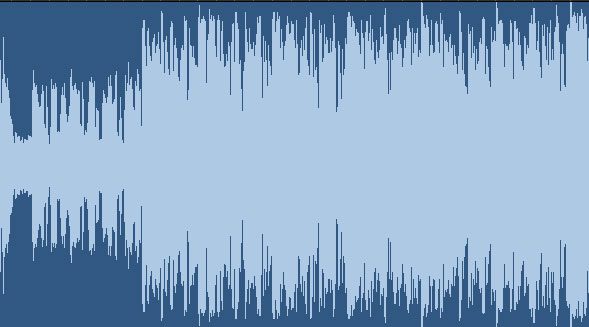

The energy level substantially drops off once again in the third pre-chorus as the song heads back into breakdown/sparse mode. However, the synth bass/acoustic piano accompaniment provides a dark/melancholic undercurrent as the song heads toward the third and final chorus. The tension increases in the last measure due to the implementation of the swelling feedback/static effect.
The third and last chorus is double the length of choruses 1 and 2, consisting of four parts as opposed to two (parts A, B, C and D). Parts A and B feature an energy level slightly above that of their chorus 1 and chorus 2 counterparts primarily due to the higher overall level of elements in the mix, in particular the saw synth.
The level increases slightly in parts C and D due in part to the delay effect featured on the Weeknd’s vocals and the swelling synths and feedback/static effect, both of which help take the intensity and excitement factor of the song to its apex in the last couple of measures of the section. The level abruptly drops off at the end of the song due to the accompaniment being pulled out from under The Weeknd’s “starboy” vocal, which is processed with a delay effect that gradually fades to nil.
Many of today’s hits feature a fusion of different genres, sub-genres and influences that helps to achieve the following:
- Provide the song with a unique nature that enables it to stand out from its mainstream contemporaries via interesting and, at times, unconventional pairings.
- Increase the fan base and sales potential of the artist and song by traversing multiple genres.
Starboy is composed of five main influences – Electropop, Dance/Club, Funk, Hip Hop/Rap, and R&B/Soul – all of which are very popular in today’s mainstream music scene, with the exception of Funk. These influences are in effect throughout the majority of the song and are present in the characteristics of the vocals, accompaniment, or both.
However, what really defines Starboy is its vibe. Put into effect by a combination of the timbre and progressions of instruments, the lead and background vocals, and the boasting/dissing lyrical content, Starboy’s dark, melancholic, self-assured, driving, grooving, unwavering vibe enables it to stand out among its current mainstream contemporaries.
Key
-: No influence
|: Divides the first half of the section from the second



The entire song features an Electropop influence, which is put into effect by the predominantly electronic instrumentation featured in the mix – including both the 808-sounding drums/percussion and assortment of synths. The influence is diminished somewhat in the third pre-chorus primarily due to the omission of the electronic drums, but is kept in effect by the droning synth bass.
The entire song, save for the feedback swell portion of the intro, the first two bars of the bridge, and the third pre-chorus features an underlying Dance/Club vibe. This is put into effect by the combined characteristics the drums/percussion and synth bass, which lock the listener into an infectious groove. Reference the Music/Instrumentation Section of the report for details.
The same sections that feature the aforementioned Dance/Club influence also feature an underlying Funk influence. It is primarily put into effect by the interaction of the synth bass and drums/percussion, which provide a bouncy, Funky type vibe, as well as some of the synth pads featured throughout the song. The influence is heightened in the chorus sections due to the use of the vocoder effect on the “ha” background vocals.
The entire song, save for the intro, features Hop Hop/Rap and R&B/Soul influences. These influences are put into effect by the monotone-esque sung/rapped hybrid delivery of The Weeknd’s vocals and the characteristics of the beat and 808-sounding instrumentation.
Starboy features four primary instrument types in the mix that shape its sound and vibe – bass (synth), drums/percussion (electronic), piano (acoustic), and an assortment of synths.
Acoustic piano is utilized in every section of the song save for the intro and bridge.
Two types are synth bass are featured in Starboy – staccato and legato.
This synth bass plays staccato notes on A in conjunction rhythmically with the kick. It possesses a gritty, analog texture with a moderately long release, and a bouncy, funky quality. It is in effect for the majority of the song, appearing in the following sections:
- Intro (Part B)
- Verse 1 & 2 (Full Sections)
- Pre-Chorus 1 & 2 (Full Sections)
- Chorus 1, 2 & 3 (Full Sections)
This synth bass possesses an analog timbre with moderate bite, playing legato whole and half notes following the chord progression. It possesses a dark, droning quality, and is featured in the following sections:
- Chorus 1 & 2 (Part B)
- Bridge (Full Section)
- Pre-Chorus 3 (Full Section)
- Chorus 4 (Parts B, C & D)
A host of synths are featured throughout Starboy:
This is a soft pad that is layered in the with the acoustic piano in the sections in which it appears. It is hardly audible but does provide the piano with subtly increased ambiance and texture.
This pad possesses a synth strings timbre when the low pass filter is mostly closed, and a brighter, brassier saw tooth wave timbre when the filter opens. It is present as a background element for much of the song, coming to prominence in the third chorus:
- Verse 1 & 2 (Part B)
- Pre-Chorus 1 (Full Section)
- Pre-Chorus 2 (Part B)
- Chorus 1, 2 & 3 (Full Sections)
This heavily modulated pad effected with flange provides a heightened degree of color and contrast in the following sections:
- Verse 1 & 2 (Part B)
- Pre-Chorus 1 (Full Section)
- Pre-Chorus 2 (Part B)
- Chorus 1, 2 & 3 (Full Sections)
This is a subtle, soft, lead synth patch that plays a whole note melody in the following sections:
- Chorus 1, 2 (Full Section)
- Chorus 3 (Parts A & B)
Synth lead 2 possesses a light, serene, woodwind-type quality. It delivers the more uplifting countermelody that provides engaging contrast against the otherwise dark, somber and intense characteristics of the chorus.
- Chorus 1 & 2 (Part B)
- Chorus 3 (Parts B, C & D)
Starboy features solely electronic drums/percussion in the mix, including kick, snare, clap, slap, shaker and hi hat. Every section of the song features drums/percussion EXCEPT for the intro part A, the first two bars of the bridge, and the entire pre-chorus 3 section.
A deep, punchy electronic kick is utilized in the following sections:
- Intro (Part B)
- Verse 1 & 2 (Full Sections)
- Pre-Chorus 1 & 2 (Full Sections)
- Chorus 1, 2 & 3 (Full Sections)
An electronic 808-sounding clap sounds on beats two and four in the following sections:
- Intro (Part B)
- Verse 1 & 2 (Full Sections)
- Pre-Chorus 1 & 2 (Full Sections)
- Chorus 1, 2 & 3 (Full Sections)
This is a bigger sounding clap than the one utilized elsewhere in the song, and is featured only in choruses 1 & 2 part B and chorus 3 part B, C & D. The decay grows progressively longer over the course of each two-bar phrase.
An electronic 808-sounding snare sounds on beats two and four in the following sections:
- Intro (Part B)
- Verse 1 & 2 (Full Sections)
- Pre-Chorus 1 & 2 (Full Sections)
- Chorus 1, 2 & 3 (Full Sections)
In each measure in which it appears it is more prominent and punchy on beat four than on beat two.
An electronic 808-sounding hi hat plays steady sixteenth notes in the following sections:
- Intro (Part B)
- Verse 1 & 2 (Full Sections)
- Pre-Chorus 1 & 2 (Full Sections)
- Chorus 1, 2 & 3 (Full Sections)
An electronic 808-sounding tom plays a syncopated sixteenth note pattern in the following sections:
- Intro (Part B)
- Verse 1 & 2 (Full Sections)
- Pre-Chorus 1 & 2 (Full Sections)
- Chorus 1, 2 & 3 (Full Sections)
This distorted, noisy feedback swell is featured prominently at the beginning of the song, and appears in choruses 1 & 3 and the bridge.
Music & Instruments: Section By Section
- Feedback Swell: (Feedback/static sound effect – Level: Low to mid) Primary Placement in the Mix: 12:00, but present wide in the stereo image from 9:00-3:00.
Everything in Part A with the following additions:
- **Bass 1: (Staccato synth bass, only plays A2 – Level: Mid) Primary Placement in the Mix: 12:00.
- **Kick: (Electronic – Level: Mid) Primary Placement in the Mix: 12:00.
- **Clap 1: (Electronic – Level: Mid) Primary Placement in the Mix: 12:00, but present wide in the stereo image from 9:00-3:00.
- **Snare: (Electronic – Level: Mid) Primary Placement in the Mix: 12:00.
- **Hi Hat: (Electronic – Level: Mid-low) Primary Placement in the Mix: 12:00.
- **Tom: (Electronic – Level: Mid-low) Primary Placement in the Mix: 12:00.
Starboy’s intro is the shortest section in the song, landing at 15 seconds / 5 bars. It is entirely instrumental and possesses an engaging multifaceted two-part structure.
Part A: 5 seconds / 1 bar
The first five seconds of Starboy consists of a swelling, distorted feedback type effect and static noise. It functions as a strong, engaging opener due to its unique quality compared to most other songs in today’s mainstream, which enables Starboy to instantly stand out and grab the listener’s attention – especially in an airplay environment. As soon as one hears this segment of the intro, there is no mistaking the song for something else.
Part B: 10 seconds / 4 bars
After swelling to a peak at the end of part A, the feedback/static effect drops down to near nil in part B and remains in effect for the duration of the section providing low-level color and texture.
The focal point of part B is the infectious synth bass/drum pattern, which serves as the backbone throughout the majority of the song. Note the following:
- The timbre and pattern of the synth bass puts the song’s bouncy, Funky vibe into effect.
- The 808-sounding electronic snare, claps and kick provide a retro yet current underlying Hip Hop influenced beat.
- The sixteenth note electronic hats provide the section with a heightened degree of momentum.
- The syncopated 808 tom also provides a heightened degree of momentum, in addition to color and texture.
Together these elements not only form an infectious groove, but also create a self-assured, driving, unwavering type vibe that jibes with and accentuates the impact of The Weeknd’s boasting lyrics.
Part A + Part B
Part A and part B do a great job of instantly capturing the listener’s attention (part A), locking them in (part B), and keeping them engaged until the first verse takes over.
Transition Point (Intro to Verse 1): The Weeknd signals the transition point into the first verse with a single “ah” vocal. Instrumentally, the intro transitions seamlessly into the first verse.
- Bass 1: (Staccato synth bass, only plays A2 – Level: Mid) Primary Placement in the Mix: 12:00.
- **Piano: (Acoustic piano chords – Level: Mid) Primary Placement in the Mix: 12:00, but present wide in the stereo image from 9:00-3:00.
- **Synth 1: (Soft pad; doubles piano – Level: Low) Primary Placement in the Mix: 12:00, but present wide in the stereo image from 9:00-3:00.
- Kick: (Electronic – Level: Mid) Primary Placement in the Mix: 12:00.
- Clap 1: (Electronic – Level: Mid) Primary Placement in the Mix: 12:00, but present wide in the stereo image from 9:00-3:00.
- Snare: (Electronic – Level: Mid) Primary Placement in the Mix: 12:00.
- Hi Hat: (Electronic – Level: Mid-low) Primary Placement in the Mix: 12:00.
- Tom: (Electronic – Level: Mid-low) Primary Placement in the Mix: 12:00.
Everything in Part A with the following additions:
- **Synth 2: (Saw pad; low-pass filtered – Level: Low) Primary Placement in the Mix: 12:00, but present wide in the stereo image from 9:00-3:00.
- **Synth 3: (Flange-effected, single pitch – Level: Mid-low) Primary Placement in the Mix: 12:00, but present wide in the stereo image from 9:00-3:00.
*Indicates a new or significantly changed up instrument in the mix compared to the preceding section
**Indicates the first appearance of an instrument in the mix
Verse 1 is 20 seconds / 8 bars in length, consisting of two 10 second / 4 bar parts/stanzas – denoted as parts A and B. The commonality between the two is the core drum/bass accompaniment that was first established in part B of the intro, which keeps the listener locked in the infectious groove throughout the section.
What follows are the accompaniment changeups that occur both within the section and relative to the preceding intro:
Part A
Part A introduces acoustic piano into the mix, which provides the section with a dark, melancholic vibe. Notice that it jibes with and accentuates the impact of the opening lyrics, “I’m gonna put you in the worst mood, ah.”
Part B
Part B introduces two additional synth elements into the mix – saw pad and modulated pad. The saw pad features a synth string timbre and provides the section with additional subtle color and texture – albeit quite low in the mix. The modulated pad is featured more prominently and possesses a flange-type quality. In addition to color and texture, this synth provides the section with a vibe of dark uneasiness.
Transition Point (Verse 1 into Pre-Chorus 1): The verse flows seamlessly into the pre-chorus.
- Bass 1: (Staccato synth bass, only plays A2 – Level: Mid) Primary Placement in the Mix: 12:00.
- Piano: (Acoustic piano chords – Level: Mid) Primary Placement in the Mix: 12:00, but present wide in the stereo image from 9:00-3:00.
- Synth 1: (Soft pad; doubles piano – Level: Low) Primary Placement in the Mix: 12:00, but present wide in the stereo image from 9:00-3:00.
- Synth 2: (Saw pad; low-pass filtered – Level: Low) Primary Placement in the Mix: 12:00, but present wide in the stereo image from 9:00-3:00.
- Synth 3: (Flange-effected, single pitch – Level: Mid-low) Primary Placement in the Mix: 12:00, but present wide in the stereo image from 9:00-3:00.
- Kick: (Electronic – Level: Mid) Primary Placement in the Mix: 12:00.
- Clap 1: (Electronic – Level: Mid) Primary Placement in the Mix: 12:00, but present wide in the stereo image from 9:00-3:00.
- Snare: (Electronic – Level: Mid) Primary Placement in the Mix: 12:00.
- Hi Hat: (Electronic – Level: Mid-low) Primary Placement in the Mix: 12:00.
- Tom: (Electronic – Level: Mid-low) Primary Placement in the Mix: 12:00.
Same as Part A
*Indicates a new or significantly changed up instrument in the mix compared to the preceding section
**Indicates the first appearance of an instrument in the mix
Pre-chorus 1 is 20 seconds / 8 bars in length, consisting of two 10 second / 4 bar parts/stanzas – part A and part B. The accompaniment throughout the section is essentially the same as part B of the preceding verse, with the only difference being that the saw synth pad become subtly more prominent in the mix as part A progresses, then resets to a lower volume and rises subtly again throughout part B.
As a result, the dark, melancholy vibe is maintained while the listener is kept locked in the song’s infectious drum/bass groove.
Transition Point (Pre-Chorus 1 into Chorus 2): The full accompaniment is abruptly pulled at the end of beat 2 in the last measure of the pre-chorus and remains absent for beat three and half of beat four. The accompaniment is reinstituted on the last half beat, ushering in the chorus that follows. Although brief, the accompaniment pull effectively provides cross-sectional separation from the chorus that follows, enabling it to hit with increased perceived impact. This is especially important considering the accompaniment similarities between sections.
- Bass 1: (Staccato synth bass, only plays A2 – Level: Mid) Primary Placement in the Mix: 12:00.
- Piano: (Acoustic piano chords – Level: Mid) Primary Placement in the Mix: 12:00, but present wide in the stereo image from 9:00-3:00.
- Synth 1: (Soft pad; doubles piano – Level: Low) Primary Placement in the Mix: 12:00, but present wide in the stereo image from 9:00-3:00.
- Synth 2: (Saw pad; low-pass filtered, filter opens slightly at end of section – Level: Low) Primary Placement in the Mix: 12:00, but present wide in the stereo image from 9:00-3:00.
- Synth 3: (Flange-effected, single pitch – Level: Mid-low) Primary Placement in the Mix: 12:00, but present wide in the stereo image from 9:00-3:00.
- **Synth 4: (Whole note melody – Level: Low) Primary Placement in the Mix: 12:00.
- Kick: (Electronic – Level: Mid) Primary Placement in the Mix: 12:00.
- Clap 1: (Electronic – Level: Mid) Primary Placement in the Mix: 12:00, but present wide in the stereo image from 9:00-3:00.
- Snare: (Electronic – Level: Mid) Primary Placement in the Mix: 12:00.
- Hi Hat: (Electronic – Level: Mid-low) Primary Placement in the Mix: 12:00.
- Tom: (Electronic – Level: Mid-low) Primary Placement in the Mix: 12:00.
Everything in Part A with the following additions/modifications:
- *Bass 1: (Staccato synth bass, follows chord progression – Level: Mid) Primary Placement in the Mix: 12:00.
- **Bass 2: (Legato synth bass – Level: Mid) Primary Placement in the Mix: 12:00.
- **Synth 5: (Woodwind-like lead – Level: Mid) Primary Placement in the Mix: 12:00.
- **Clap 2: (Electronic, bigger than clap 1, automated decay – Level: Mid) Primary Placement in the Mix: 12:00, but present wide in the stereo image from 9:00-3:00.
*Indicates a new or significantly changed up instrument in the mix compared to the preceding section
**Indicates the first appearance of an instrument in the mix
Chorus 1 is 20 seconds / 8 bars in length, consisting of two 10 second / 4 bar parts/stanzas – part A and part B. Similar to the verse, both parts feature similar and contrasting accompaniment characteristics. The primary commonality between the two is that they both feature the core drum/bass accompaniment that has been in effect since part B of the intro, coupled with the saw and modulated (flange) synth pads. As a result, the vibe is maintained, and the listener remains locked in the groove.
What follows are the new elements that have been added into the mix:
Part A
The first half of the chorus features the same accompaniment as the pre-chorus plus the addition of synth 4. It plays whole notes and provides the section with more melodic interest compared to the pre-chorus
There are a few new elements that enter during the second half of the section, part B, which provide engaging cross-stanza contrast:
- Legato synth bass: This bass features a dark, droning quality, providing the section with additional texture and underlying intensity.
- Claps 2: In contrast to clap 1, which has been sounding on beats 2 and 4 since part B of the intro, clap 2, which also sounds on beats 2 and 4, is significantly bigger in nature. Varying between long and short decays, these claps punch through the mix at a heightened level and provide additional texture and intensity.
- Lead synth: This synth possesses a woodwind-like timbre, playing an infectious, repetitive melody throughout part B. Its timbre and melody provide the section with a lighter, serene counter to the darkness and melancholy that that has defined the accompaniment up until this point.
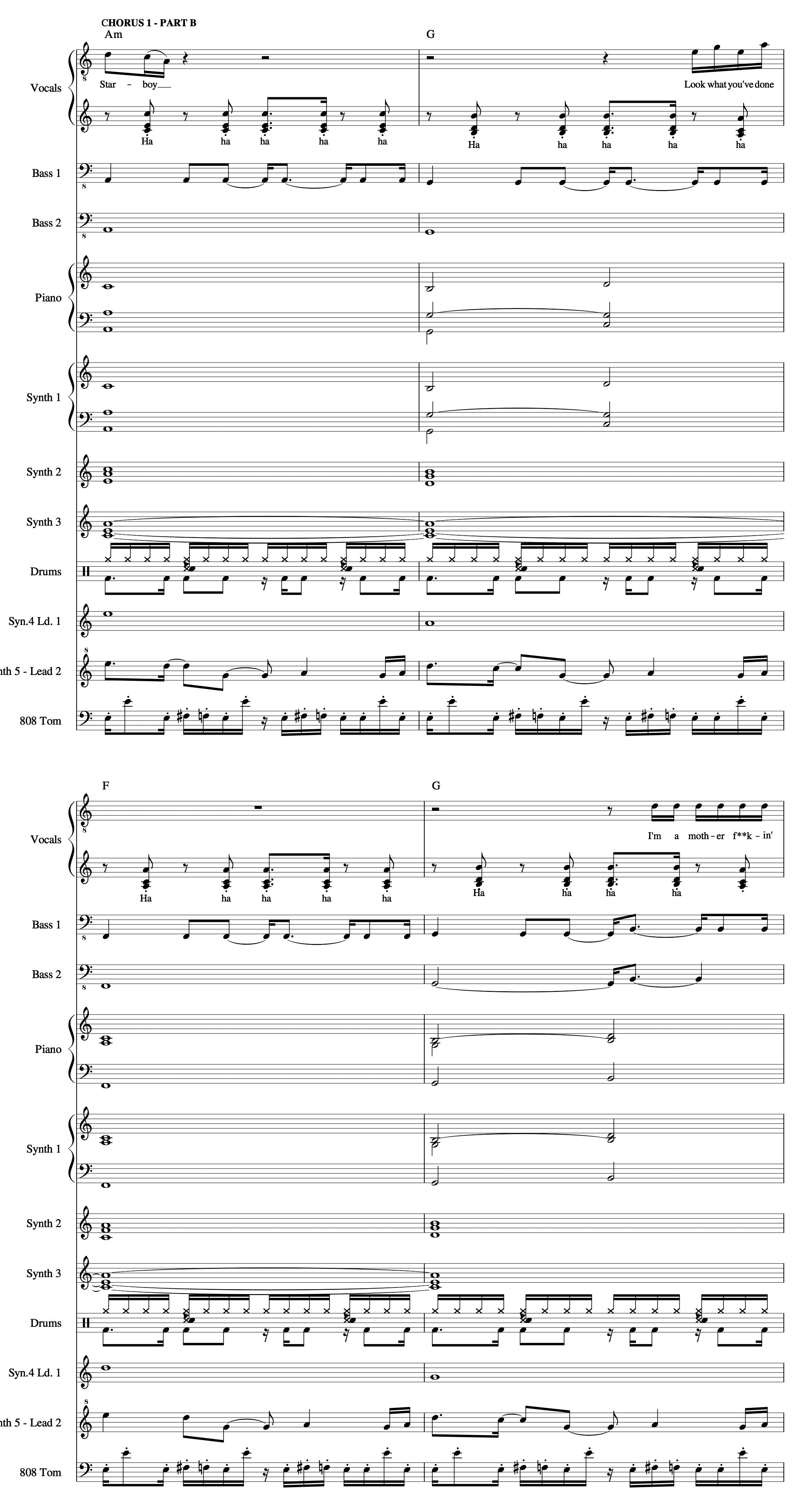

Transition Point (Chorus 1 into Verse 2): Elements of the accompaniment – in particular the legato bass and saw synth pad – begin to swell in the last measure of the section. This both provides an engaging intensity level peak at the end of the section, and a heightened degree of cross-sectional contrast compared to the sparser verse that follows. The core drum/bass accompaniment remains in effect, seamlessly leading the listener into the second verse.
- *Bass 1: (Staccato synth bass, only plays A2 – Level: Mid) Primary Placement in the Mix: 12:00.
- Piano: (Acoustic piano chords – Level: Mid) Primary Placement in the Mix: 12:00, but present wide in the stereo image from 9:00-3:00.
- Synth 1: (Soft pad; doubles piano – Level: Low) Primary Placement in the Mix: 12:00, but present wide in the stereo image from 9:00-3:00.
- Kick: (Electronic – Level: Mid) Primary Placement in the Mix: 12:00.
- Clap 1: (Electronic – Level: Mid) Primary Placement in the Mix: 12:00, but present wide in the stereo image from 9:00-3:00.
- Snare: (Electronic – Level: Mid) Primary Placement in the Mix: 12:00.
- Hi Hat: (Electronic – Level: Mid-low) Primary Placement in the Mix: 12:00.
- Tom: (Electronic – Level: Mid-low) Primary Placement in the Mix: 12:00.
Everything in Part A with the following additions:
- Synth 2: (Saw pad; low-pass filtered – Level: Low) Primary Placement in the Mix: 12:00, but present wide in the stereo image from 9:00-3:00.
- Synth 3: (Flange-effected, single pitch – Level: Mid-low) Primary Placement in the Mix: 12:00, but present wide in the stereo image from 9:00-3:00.
*Indicates a new or significantly changed up instrument in the mix compared to the preceding section
Verse 2 features essentially the same accompaniment characteristics as verse 1. Notice that the sparser arrangement compared to part B of the chorus that precedes it provides subtle yet engaging cross-section contrast, while the listener is kept locked into the infectious drum/bass groove.
Transition Point (Verse 2 into Pre-Chorus 2): The core accompaniment of the second verse transitions seamlessly into the second pre-chorus.
- Bass 1: (Staccato synth bass, only plays A2 – Level: Mid) Primary Placement in the Mix: 12:00.
- Piano: (Acoustic piano chords – Level: Mid) Primary Placement in the Mix: 12:00, but present wide in the stereo image from 9:00-3:00.
- Synth 1: (Soft pad; doubles piano – Level: Low) Primary Placement in the Mix: 12:00, but present wide in the stereo image from 9:00-3:00.
- Kick: (Electronic – Level: Mid) Primary Placement in the Mix: 12:00.
- Clap 1: (Electronic – Level: Mid) Primary Placement in the Mix: 12:00, but present wide in the stereo image from 9:00-3:00.
- Snare: (Electronic – Level: Mid) Primary Placement in the Mix: 12:00.
- Hi Hat: (Electronic – Level: Mid-low) Primary Placement in the Mix: 12:00.
- Tom: (Electronic – Level: Mid-low) Primary Placement in the Mix: 12:00.
Everything in Part A with the following additions:
- Synth 2: (Saw pad; low-pass filtered, slightly more open than verse 2 – Level: Low) Primary Placement in the Mix: 12:00, but present wide in the stereo image from 9:00-3:00.
- Synth 3: (Flange-effected, single pitch – Level: Mid-low) Primary Placement in the Mix: 12:00, but present wide in the stereo image from 9:00-3:00.
*Indicates a new or significantly changed up instrument in the mix compared to the preceding section
Pre-chorus 2 features characteristics that are both in line and different from its pre-chorus 1 counterpart. The primary difference between these two “like sections” transpires in the first half of the section, part A. While pre-chorus 1 features the same accompaniment as verse 1, which includes the saw and modulated flange synths, these two elements are noticeably omitted from part A of pre-chorus 2. Their omission results in the following:
- It provides a subtle degree of cross-section contrast. This is important considering the similar cross-section accompaniment characteristics found throughout the song.
- It institutes a subtle changeup in vibe. The uneasiness that the modulated flange synth puts into effect is omitted, and the dark, melancholic vibe put into effect by the acoustic piano shines front and center in an unadulterated manner.
Transition Point (Pre-Chorus 2 into Chorus 2): Same brief accompaniment pull transition as pre-chorus 1 into chorus 1.
- Bass 1: (Staccato synth bass, only plays A2 – Level: Mid) Primary Placement in the Mix: 12:00.
- Piano: (Acoustic piano chords – Level: Mid) Primary Placement in the Mix: 12:00, but present wide in the stereo image from 9:00-3:00.
- Synth 1: (Soft pad; doubles piano – Level: Low) Primary Placement in the Mix: 12:00, but present wide in the stereo image from 9:00-3:00.
- Synth 2: (Saw pad; low-pass filtered, filter opens at end of section – Level: Low) Primary Placement in the Mix: 12:00, but present wide in the stereo image from 9:00-3:00.
- Synth 3: (Flange-effected, single pitch – Level: Mid-low) Primary Placement in the Mix: 12:00, but present wide in the stereo image from 9:00-3:00.
- *Synth 4: (Whole note melody – Level: Low) Primary Placement in the Mix: 12:00.
- Kick: (Electronic – Level: Mid) Primary Placement in the Mix: 12:00.
- Clap 1: (Electronic – Level: Mid) Primary Placement in the Mix: 12:00.
- Snare: (Electronic – Level: Mid) Primary Placement in the Mix: 12:00.
- Hi Hat: (Electronic – Level: Mid-low) Primary Placement in the Mix: 12:00.
- Tom: (Electronic – Level: Mid-low) Primary Placement in the Mix: 12:00.
Everything in Part A with the following additions:
- *Bass 1: (Staccato synth bass, follows chord progression – Level: Mid) Primary Placement in the Mix: 12:00.
- *Bass 2: (Legato synth bass – Level: Mid) Primary Placement in the Mix: 12:00.
- *Synth 5: (Woodwind-like lead – Level: Mid) Primary Placement in the Mix: 12:00.
- *Clap 2: (Electronic, bigger than clap 1, automated decay – Level: Mid) Primary Placement in the Mix: 12:00, but present wide in the stereo image from 9:00-3:00.
*Indicates a new or significantly changed up instrument/vocal in the mix compared to the preceding section
Chorus 2 features essentially the same accompaniment characteristics as chorus 1.
Transition Point (Chorus 2 to the Bridge): The full accompaniment save for the droning, legato synth bass is abruptly pulled out from under The Weeknd’s “starboy” vocal at the tail end of the chorus. This both provides the signal that cross-sectional change is afoot, coupled with enabling the song title lyrics, “starboy,” to further stand out and connect in an unadulterated manner.
- Bass 1: (Staccato synth bass, only plays A2 – Level: Mid) Primary Placement in the Mix: 12:00.
- Bass 2: (Legato synth bass – Level: Mid) Primary Placement in the Mix: 12:00.
- Kick: (Electronic – Level: Mid) Primary Placement in the Mix: 12:00.
- Clap 1: (Electronic – Level: Mid) Primary Placement in the Mix: 12:00, but present wide in the stereo image from 9:00-3:00.
- Snare: (Electronic – Level: Mid) Primary Placement in the Mix: 12:00.
- Hi Hat: (Electronic – Level: Mid-low) Primary Placement in the Mix: 12:00.
- Tom: (Electronic – Level: Mid-low) Primary Placement in the Mix: 12:00.
- *Feedback Swell: (Feedback/static sound effect sounding on beat 4 of each measure until sustained swell in last bar of section – Level: Low to mid) Primary Placement in the Mix: 12:00, but present wide in the stereo image from 9:00-3:00.
*Indicates a new or significantly changed up instrument/vocal in the mix compared to the preceding section
The bridge is 20 seconds / 8 bars in length, and consists of two distinct segments:
Segment 1 (Part A – bars 1 and 2)
The first segment is 2 bars in length and provides the most pronounced accompaniment departure thus far in the song. It features a breakdown/sparse characteristic, consisting of solely of droning, dark legato synth bass and bursts of feedback/static that sound on beat 4 of each measure. Note that this is the first time this effect is heard prominently since part A of the intro. Together, these elements provide a dark, foreboding, stark accompaniment to The Weeknd’s low pitch-shifted vocals, which are also only in effect for two bars.
The pronounced accompaniment contrast compared to the preceding sections – in particular the lack of the drum/staccato bass groove – serves to engage the listener at a heightened level in the song.
Segment 2 (Parts A and B – bars 3 – 8)
With the feedback/static effect and droning synth remaining in effect, the infectious drum/bass pattern that defines the preceding sections of the song is reinstated in bar 3. This locks the listener is back into the song’s infectious groove, while the aforementioned contrast keeps the cross-sectional engagement value at a high.
Transition Point (Bridge to Pre-Chorus 3): The feedback/static effect that has been sounding on beat 4 throughout the bridge swells to a crescendo at the tail end of the section just as it did in the chorus. This helps to provide a heightened degree of engaging cross-section contrast compared to the sparse/breakdown pre-chorus 3 section that follows. The onset of pre-chorus 3 is marked by the bridge accompaniment coming to an abrupt end, followed by the return of the acoustic piano progression on beat 1 and the legato bass drone entering on beat 2.
- Bass 2: (Legato synth bass – Level: Mid) Primary Placement in the Mix: 12:00.
- *Piano: (Acoustic piano chords – Level: Mid) Primary Placement in the Mix: 12:00, but present wide in the stereo image from 9:00-3:00.
- *Synth 1: (Soft pad; doubles piano – Level: Low) Primary Placement in the Mix: 12:00, but present wide in the stereo image from 9:00-3:00.
Everything in Part A with the following additions:
- Feedback Swell: (Feedback/static sound effect at end of section – Level: Low to mid) Primary Placement in the Mix: 12:00, but present wide in the stereo image from 9:00-3:00.
*Indicates a new or significantly changed up instrument in the mix compared to the preceding section
**Indicates the first appearance of an instrument in the mix
Pre-chorus 3 is unique in relation to the other sections in the song – including pre-choruses 1 and 2 – in that it is the only section that remains in breakdown/sparse mode for the duration of the ENTIRE section. The bridge also features a breakdown segment, but only for the first two bars.
The two instruments featured in the mix are the legato synth bass drone and acoustic piano, which makes a return since being pulled in the bridge. The pronounced cross section and “like section” contrast imparted provides the song with a heightened degree of engagement value – both sonically and dynamically.
Transition Point (Pre-Chorus 3 into Chorus 3): The accompaniment thins out during the last two beats of the pre-chorus, with only the feedback/static effect remaining in effect. This enables the chorus to hit with increased perceived impact once the bass, drums and synths reenter at the transition point.
- *Bass 1: (Staccato synth bass, only plays A2 – Level: Mid) Primary Placement in the Mix: 12:00.
- Piano: (Acoustic piano chords – Level: Mid) Primary Placement in the Mix: 12:00, but present wide in the stereo image from 9:00-3:00.
- Synth 1: (Soft pad; doubles piano – Level: Low) Primary Placement in the Mix: 12:00, but present wide in the stereo image from 9:00-3:00.
- *Synth 2: (Saw pad; more filter movement and more open and brassy than in previous sections – Level: Low-mid) Primary Placement in the Mix: 12:00, but present wide in the stereo image from 9:00-3:00.
- *Synth 3: (Flange-effected, single pitch – Level: Mid-low) Primary Placement in the Mix: 12:00, but present wide in the stereo image from 9:00-3:00.
- *Synth 4: (Whole note melody, parts A & B only – Level: Low) Primary Placement in the Mix: 12:00.
- *Kick: (Electronic – Level: Mid) Primary Placement in the Mix: 12:00.
- *Clap 1: (Electronic – Level: Mid) Primary Placement in the Mix: 12:00, but present wide in the stereo image from 9:00-3:00.
- *Snare: (Electronic – Level: Mid) Primary Placement in the Mix: 12:00.
- *Hi Hat: (Electronic – Level: Mid-low) Primary Placement in the Mix: 12:00.
- *Tom: (Electronic – Level: Mid-low) Primary Placement in the Mix: 12:00.
- *Clap 2: (Single hit at onset of section – Level: Mid) Primary Placement in the Mix: 12:00, but present wide in the stereo image from 9:00-3:00.
- *Bass 1: (Staccato synth bass, follows chord progression – Level: Mid) Primary Placement in the Mix: 12:00.
- *Bass 2: (Legato synth bass – Level: Mid) Primary Placement in the Mix: 12:00.
- *Synth 5: (Woodwind-like lead – Level: Mid) Primary Placement in the Mix: 12:00.
- *Clap 2: (Claps on beats 2 & 4 throughout – Level: Mid) Primary Placement in the Mix: 12:00, but present wide in the stereo image from 9:00-3:00.
- Feedback Swell: (Feedback/static sound effect at end of section – Level: Low to mid) Primary Placement in the Mix: 12:00.
*Indicates a new or significantly changed up instrument/vocal in the mix compared to the preceding section
The third and final chorus is unique compared to the other choruses in that it’s double the length, consisting of four parts as opposed to two (parts A, B, C and D).
Parts A and B
Parts A and B feature the same general accompaniment characteristics as their chorus 1 and chorus 2 counterparts. The primary difference is that the levels are running a bit hotter – in particular the saw synth. This provides the section with a higher degree of respective intensity.
Parts C and D
Parts C and D both feature the core accompaniment characteristics that define part B – in particular the pronounced claps, which are not featured in part A. As a result, the energy level of the section, and the song, continues on at a heightened level.
In bar 2 of part D, the intensity and excitement factor increases due to the opening of the saw synth’s low pass filter, making it more prominent in the mix. The level increases even further in bar 3 due to the addition of the swelling feedback/static effect. Both elements reach their apex at the end of the song, helping to bring the intensity and excitement to a grand climax.
The accompaniment is then abruptly pulled during The Weeknd’s final “starboy” vocal, which rings out with a delay effect as the song comes to its conclusion.
Harmonic Progressions
Starboy employs one of three variations of the same chord progression, Am – G – F – G, in every section of the song except for the intro and bridge, which do not have chord progressions.
Both verses, the first two pre-choruses, and chorus part A all feature a pedal A in Bass 1, creating inverted chords. In A minor, the resulting chord progression is Am – G/A – F/A – G/A, which can be displayed as:
Having a constant pedal A in the bass creates a sense of tension that consistently builds until the release in each chorus.
Part A of each chorus features the same harmonic progression as the verses and first two pre-choruses. The tension is finally released when the bass begins to move in parts B, C & D, putting the chords in root position. This creates the progression Am – G – F – G – G/B, which can be displayed as i – VII – VI – VII – VII6. There is one inversion, G/B used at the end of the progression that helps to create more momentum heading into the tonic Am chord that follows.
The low end of the piano and bass 2 work together in the third pre-chorus to create more harmonic movement than in any other section of the song. While the chord progression is still based on the Am – F – G – F progression, it introduces more passing chords, C5add9 and G/B. The C5add9 functions as a weak secondary dominant of the chord it proceeds, F. It is weak because it doesn’t include the 3rd or 7th of the full C9 chord (E and Bb), the defining chord tones of any dominant chord, but helps to emphasize the F major chord nonetheless. It is worth noting the piano utilizes this chord throughout the song but its harmonic value is low until it is joined by the bass in pre-chorus 3. The other passing chord is G/B, is utilized in the fourth bar of the section. This subtle change creates greater harmonic interest and more momentum to the tonic Am chord in bar five. The chord progression, Am – G – C5add9 – F – G – G/B can be displayed as i – VII – Vadd9/VI – VI – VII – VII6.
Each line in the first stanza is connected by the “ou” / “ah” two-lyric/syllable commonality at the end:
- Line 1: “mood, ah”
- Line 2: “shoes, ah”
- Line 3: “too, ah”
- Line 4: “too, ah”
The connection of lines 1, 2 and 3 is further heightened by the assonance of each third to last lyric, which features the “uhr”-sounding commonality:
- Line 1: “worst mood, ah”
- Line 2: “church shoes, ah”
- Line 3: “hurt too, ah”
Line 4 is the oddball in the stanza in that it features both commonalities and differences with the preceding three, as well as the second stanza that follows:
- It features a strong connection to line 3 that precedes it due to the “just to, ah” commonality.
- It differs from lines 1 – 3 due to the third to last lyric, “tease,” which breaks from the aforementioned “uhr” sounding commonality. However, note that the lyric, “tease,” is the first instance of the “ee” assonance that defines the third to last lyric in each line of the second stanza that follows. Essentially, line 4 functions as a cross-stanza bridge line due to the dual connection.
The second stanza features a very similar structure to that of the first stanza. Each line is connected by the “ou” / “ah” two-lyric/syllable commonality at the end, which it has in common with the first stanza. Each line concludes with the lyrics “too, ah,” except for line 2, which concludes with “too, yah.”
As mentioned above, the third to last lyric/syllable on each line features an “ee” sounding commonality, which further strengthens the connection value:
- Line 1: “lease too, ah”
- Line 2: “week too, yah”
- Line 3: “league too, ah”
- Line 4: “league too, ah”
Notice that lines 3 and 4 are identical save for the first lyric, “main” and “side”:
- Line 3: “Main bitch out of your league too, ah”
- Line 4: “Side bitch out of your league too, ah”
Additionally, notice that lines 2 and 3 are connected by the “made” / “main” sounding commonality at the BEGINNING of each, which is unique in the scope of the section.
The first stanza of verse 2 features similar structural characteristics to that of the second stanza of verse 1. Here, the order of the three-syllable connection has been partially changed up, as well as one of the rhyme connections:
- Verse 1: “ee” / “ou” / “ah”
- Verse 2: “eh” / “ee” / “ah”
Each line in the first stanza is connected by the “eh” / “ee” / “ah” three lyric/syllable commonality at the end:
- Line 1: “test me, ah”
- Line 2: “end me, ah”
- Line 3: “S-V, ah” (ehs-vee)
- Line 4: “heft-y, ah”
Lines 1 and 2 are further connected by the fact that they contain the same lyrics except for the third to last on each, “test” and “end.” Note that this is similar to the last two lines in stanza 2 of the first verse, except for the fact that the changed up lyric occurs at the beginning:
- Line 1: “Ev-’ry day a ni*-*a try to test me, ah”
- Line 2: “Ev-’ry day a ni*-*a try to end me, ah”
The second stanza features a pronounced departure from that of the first stanza, as well as verse 1.
Lines 5 & 6
Lines 5 & 6 feature a BB scheme, with the rhyme occurring on the last three lyrics/syllables of each. This is the only similarity that these lines share with the other lines in the section, as well as the first verse:
- Line 5: “far cry-y”
- Line 6: “fall time-ime”
Notice that the connection value between the two is heightened by the last lyrics, “cry-y” and “time-ime,” which both possess a melismatic delivery.
Additionally, notice that line 6 contains two other instances of the “eye” sounding commonality, which further heightens the connection factor:
- “I come a-live in the fall time-ime”
Lines 7 & 8
The last two lines in the section feature a CC scheme, with the connection occurring on the last syllable on each. Note that this is the only point in both verse sections where the last three lyrics/syllables DO NOT feature a rhyme commonality:
- Line 7: “lis-ten”
- Line 8: “E-di-tion”
The connection value of line 7, “No com-pe-ti-tion I don’t real-ly lis-ten,” is heightened due to the following in-line and cross-line commonalities:
- In-line: “no” and “don’t”
- In-line and cross-line: “com-pe-ti-tion”
- Cross-line: “I” (the “eye” sounding commonality that it shares with the other lines in the section.
Line 8, “I’m in the blue Mul-sanne bump-in’ New E-di-tion,” also features the “eye” sounding commonality in the lyric “I’m” at the beginning, and the “in” commonality in the lyric “bump-in’.”
Additionally, notice that the connection value of each line is accentuated by the words/syllables that directly precede the main “i-tion” / “i-sten” rhyme in each:
- “com-pe-ti-tion”
- “real-ly lis-ten”
- “New E-di-tion”
Lines 1, 2 and 3 in the first stanza are connected by the “ee” sounding commonality. It appears at the end of each line as well additional times prior:
- Line 1: “emp-ty,” “need,” “cen-ter-piece”
- Line 2: “Twen-ty,” “e-bo-ny”
- Line 3: “i-v’ry,” “skin-ny,” “piec-es”
Notice that the connection is strengthened by the “eh” commonality in the following lyrics:
- “emp-ty”
- “Twen-ty”
- “e-bo-ny”
Line 4 is the oddball in the section, and plays a similar cross-stanza “bridge” role as line 4 does in the first verse. It features a connection with lines 1 – 3 that precede it, as well as the second stanza that follows.
- It is connected with lines 1 – 3 due to the “ee” sounding commonality in the lyric “clean,” which occurs near the beginning of the line.
- It breaks from the primary “ee” rhyme that defines lines 1 – 3 by the implementation of the “ay” rhyme that appears at the end of both phrases. This is the primary rhyme featured in the second stanza.
The second stanza features both commonalities and differences with the first stanza.
Lines 5 – 8
Lines 5 – 8 are connected by the “ay” sounding rhyme at the end (with the exception of the “ah” at the end of line 7), which was initially established on line 4 in the first stanza. Note that each rhyming lyric consists of one syllable:
- Line 5: “aid”
- Line 6: “shade”
- Line 7: “lane”
- Line 8: “pain”
Also notice that lines 5 and 6 are further connected by the “aid” sounding commonality, and lines 7 and 8 are further connected by the differentiated “ain” sounding commonality. As a result, the full stanza features a primary connection, while the aforementioned line groups reinforce the connection as well.
Lines 5 & 6
The first two lines in the second stanza are further connected to each other as well as the first stanza by the “ee” commonality in the following lyrics:
- Line 6: “money,” “need,” “hear-in’”
- Line 7: “me,” see”
They also begin with the same lyrics, “you talk-in’.”
Line 7 & 8
The last two lines in the second stanza also begin with the same lyrics, “switch up my.” The connection is heightened by the additional lyrical commonalities in both lines, “I” and “any.”
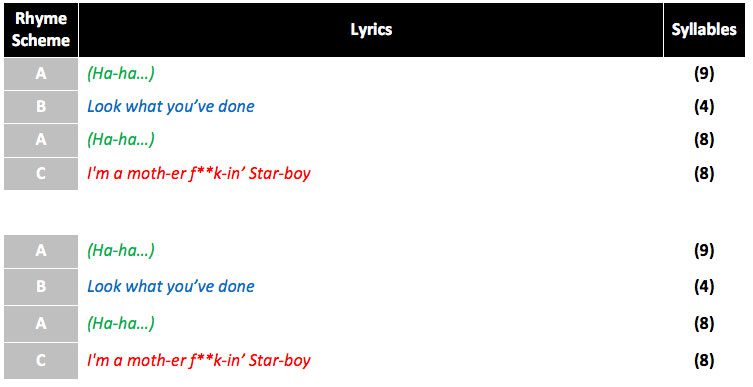

Both stanzas in the chorus contain the same lyrical content. The odd numbered lines in the full section (1, 3, 5, 7) feature the repetition of the vocoder effected “ha-ha” vocals. The even numbered lines (2, 4, 6, 8) alternate between the “look what you’ve done” and “I’m a mother f**kn’ starboy” lyrics.
Lines 1 and 2 in the first stanza are connected by the “it” sounding commonality at the end in the lyrics “Pitt” and “band-it”, respectively. The connection value is heightened by the commonality across the last four syllables in both lines:
- Line 1: “ni*-*a Brad Pitt”
- Line 2: “like a ban-dit”
The last two lines in the first stanza – lines 3 and 4 – are connected by the “ih” sounding commonality at the end in the lyrics “wag-on” and “lav-ish”, respectively. Note that the “o” in “wagon” is pronounced “i.”
Each line in the second stanza is connected by the “ah” sounding commonality at the end in the following single-syllable lyrics:
- Line 1: “Kahn”
- Line 2: “song” (pronounced “sahng”)
- Line 3: “God”
- Line 4: “cars”
Lines 1 and 2 are further connected by the following two commonalities:
- The “n” in “Kahn” and “song.”
- The second and third lyrics on each line: “Trek roof” and “get loose”, respectively.
Both phrases on line 4 are connected by the “we” and “pray for” lyrical commonalities.
Vocals
Starboy features a few different vocal characteristics that take its impact to a heightened level. They include sung and a sung/rapped hybrid lead, vocoder-processed background, doubled and harmonized lead, pitch-shifted lead, and varying degrees of reverb and delay.
Key
S: Sung R: Rapped SP: Spoken SH: Shout -/-: First Stanza/Second Stanza
- Solo Lead 1: The Weeknd – processed with reverb and minimal delay – primary panning around 12:00. The vocals are sung throughout the song and possess a distinct Hip Hop/Rap influence, which is especially apparent on the monotone-based lines.
- Double 1: The Weeknd – same pitch as the lead.
- Harmony 1: The Weeknd – multi-pitch harmony. Pronounced in the bridge due to the pitch-shift effect employed.
- Independent Background 1: Processed with a Daft Punk vocoder effect – ample reverb.
Bold lyrics: Indicate an additional voice doubling the lead vocal. Harmony details are included at the top of each section in which they appear. Details appear in each section in which doubling occurs.
Single Line Underlined lyrics: Indicate the presence of vocal harmonies in addition to the lead vocal. Harmony details are included at the top of each section in which vocal harmonies appear.
(Lyrics in parentheses): Indicate independent background vocals. Details are included at the top of each section in which independent backgrounds appear.
Vocals featured in the mix:
- Lead 1: The Weeknd
Line 1: I’m try-na put you in the worst mood, ah
Line 2: P-1 clean-er than your church shoes, ah
Line 3: Mil-li point two just to hurt you, ah
Line 4: All red Lamb just to tease you, ah
Line 5: None of these toys on lease too, ah
Line 6: Made your whole year in a week too, yah
Line 7: Main bitch out of your league too, ah
Line 8: Side bitch out of your league too, ah
Both stanzas in the first verse feature The Weeknd’s sung lead vocal. It is processed with reverb and minimal delay.
Vocals featured in the mix:
- Lead 1: The Weeknd
- Double 1: The Weeknd
Line 1: House so emp-ty need a cen-ter-piece
Line 2: Twen-ty racks a ta-ble cut from e-bo-ny
Line 3: Cut that i-v’ry into skin-ny piec-es
Line 4: Then she clean it with her face, man I love my ba-by
Line 5: You talk-in’ mon-ey need a hear-in’ aid
Line 6: You talk-in’ ‘bout me I don’t see the shade
Line 7: Switch up my style I take any lane
Line 8: I, switch up my cup I kill any pain
Both stanzas in the first pre-chorus feature The Weeknd’s sung lead vocal. However, there is additional vocal layering and effect processing in play, which provide the section with a heightened degree of color, texture and engagement value:
Pronounced Delay & Vocal Processing
- Line 1: “cen-ter-piece” (prominent delay / heavy reverb – “piece”)
- Line 2: “e-bo-ny” (prominent delay / heavy reverb – “ny”)
- Line 4: “my ba-by” (prominent delay / pronounced pitch processing-Autotune – “my ba-by”)
- Line 5: “aid” (prominent delay / heavy reverb)
- Line 6: “shade” (prominent delay / heavy reverb)
Vocal Layering
The last line in the first stanza, line 4, features a doubled lead vocal from The Weeknd. This provides subtle emphasis compared to the other lines in the section.
Vocals featured in the mix:
- Lead 1: The Weeknd
- Independent Background 1: Daft Punk (vocoder effect)
Line 1: (Ha-ha…)
Line 2: Look what you’ve done
Line 3: (Ha-ha…)
Line 4: I’m a moth-er f**k-in’ Star-boy
Line 5: (Ha-ha…)
Line 6: Look what you’ve done
Line 7: (Ha-ha…)
Line 8: I’m a moth-er f**k-in’ Star-boy
From a vocal standpoint, the main difference between the first chorus and the sections that precede it is that it features Daft Punk-style vocoder-effected background vocals. Appearing both independently of and underneath The Weeknd’s lead, the “ha-ha” vocals provide the section with an additional infectious element. Note the following:
- The vocoder effect is a signature of Daft Punk, and puts their unique mark on the song accordingly.
- The pronounced contrast between the background and lead vocal qualities provides the chorus with a heightened degree of engagement value and impact, furthering its ability to stand out and resonate in the scope of the song.
Also noteworthy in the chorus is the vibrato on The Weeknd’s voice on the lyric “done.” This provides the line as a whole with a subtly heightened degree of excitement.
Vocals featured in the mix:
- Lead 1: The Weeknd
Line 1: Ev-’ry day a ni*-*a try to test me, ah
Line 2: Ev-’ry day a ni*-*a try to end me, ah
Line 3: Pull off in that road-ster S-V, ah
Line 4: Pock-ets o-ver weight get-tin’ heft-y, ah
Line 5: Com-in’ for the king that’s a far cry-y
Line 6: I come a-live in the fall time-ime
Line 7: No com-pe-ti-tion I don’t real-ly lis-ten
Line 8: I’m in the blue Mul-sanne bump-in’ New E-di-tion
Verse 2 features essentially the same vocal production characteristics as the first verse, with the addition of subtle stereo delay throughout.
Vocals featured in the mix:
- Lead 1: The Weeknd
- Double 1: The Weeknd
Line 1: House so emp-ty need a cen-ter-piece
Line 2: Twen-ty racks a ta-ble cut from e-bo-ny
Line 3: Cut that i-v’ry into skin-ny piec-es
Line 4: Then she clean it with her face, man I love my ba-by
Line 5: You talk-in’ mon-ey need a hear-in’ aid
Line 6: You talk-in’ ‘bout me I don’t see the shade
Line 7: Switch up my style I take any lane
Line 8: I, switch up my cup I kill any pain
Pre-chorus 2 features essentially the same core vocal characteristics as pre-chorus 1.
Vocals featured in the mix:
- Lead 1: The Weeknd
- Independent Background 1: Daft Punk (vocoder effect)
Line 1: (Ha-ha…)
Line 2: Look what you’ve done
Line 3: (Ha-ha…)
Line 4: I’m a moth-er f**k-in’ Star-boy
Line 5: (Ha-ha…)
Line 6: Look what you’ve done
Line 7: (Ha-ha…)
Line 8: I’m a moth-er f**k-in’ Star-boy
Chorus 2 features essentially the same vocal characteristics as chorus 1.
Vocals featured in the mix:
- Lead 1: The Weeknd
- Double 1: The Weeknd
Line 1: Let a ni*-*a Brad Pitt
Line 2: Leg-end Of The Fall took the year like a ban-dit
Line 3: Bought mom-ma a crib and a brand new wag-on
Line 4: Now she hit the gro-cer-y shop look-in’ lav-ish
Line 5: Star Trek roof in that Wraith Of Khan
Line 6: Girls get loose when they hear this song
Line 7: A hun-dred on the dash get me close to God
Line 8: We don’t pray for love we just pray for cars
The bridge possesses the most differentiated lead vocal production characteristics compared to the other sections in the song. It features the Weeknd’s sung/rapped hybrid lead vocal plus other embellishments that are put into effect as the section progresses:
- The Weeknd’s lead features much less reverb than other sections in the song. This provides it with a more upfront, intimate quality.
- Lines 1 and 2 feature a pronounced low pitch-shift effect. This provides stringent contrast compared to the other vocals in the section, as well as the song as a whole. Its impact is heightened due to the breakdown/sparse arrangement, which enables his vocal to stand out on a more pronounced level.
- The other lines in the section also feature a harmonized pitch-shift effect, but the low end is much less pronounced. As a result The Weeknd’s “true” voice is featured more prominently, while the pitch-shift effect provides a heightened degree of texture and weight.
- The last lyric on lines 6 and 8 – “song” and “cars” – feature moderate, albeit brief, reverb processing and a doubled lead vocal. This both provides engaging contrast in the scope of the section as well as heightening the connection value due the processing commonality in addition to the “ah” rhyme (the lyrics are sung “sahng” and “cahrs”.
Vocals featured in the mix:
- Lead 1: The Weeknd
- Double 1: The Weeknd
Line 1: House so emp-ty need a cen-ter-piece
Line 2: Twen-ty racks a ta-ble cut from e-bo-ny
Line 3: Cut that i-v’ry into skin-ny piec-es
Line 4: Then she clean it with her face, man I love my ba-by
Line 5: You talk-in’ mon-ey need a hear-in’ aid
Line 6: You talk-in’ ‘bout me I don’t see the shade
Line 7: Switch up my style I take any lane
Line 8: I, switch up my cup I kill any pain
Pre-chorus 3 features essentially the same vocal production characteristics as pre-choruses 1 and 2.
Vocals featured in the mix:
- Lead 1: The Weeknd
- Double 1: The Weeknd
- Independent Background 1: Daft Punk (vocoder effect)
Line 1: (Ha-ha…)
Line 2: Look what you’ve done
Line 3: (Ha-ha…)
Line 4: I’m a moth-er f**k-in’ Star-boy
Line 5: (Ha-ha…)
Line 6: Look what you’ve done
Line 7: (Ha-ha…)
Line 8: I’m a moth-er f**k-in’ Star-boy
Line 1: (Ha-ha…)
Line 2: Look what you’ve done
Line 3: (Ha-ha…)
Line 4: I’m a moth-er f**k-in’ Star-boy
Line 5: (Ha-ha…)
Line 6: Look what you’ve done
Line 7: (Ha-ha…)
Line 8: I’m a moth-er f**k-in’ Star-boy
The third and last chorus in the song is double the length of choruses 1 and 2, consisting of four stanzas as opposed to two. The first two stanzas (parts A and B) feature essentially the same vocal production characteristics as choruses 1 and 2, with the primary difference being the delay effect imparted on the last lyric, “starboy.” The last two stanzas feature a couple of other subtle differences compared to choruses 1 and 2:
- The overall vocal level is higher than the preceding two stanzas as well as choruses 1 and 2 due to the lead vocal doubling. This subtly increases the intensity factor of the song as it heads toward its conclusion.
- Delay is featured on the last lyric of each lead vocal line – “done” and “starboy.”
- The last lyric in the song, “starboy,” features a lengthy delay tail coupled with a high to low pitch-shift effect which brings the song to its conclusion.
Begins on D4 and ends a perfect fourth lower on A3.
Begins a perfect fifth higher on E4 and ends a perfect fifth lower on A3.
Same as pre-chorus 1.
Begins a perfect fourth higher on D4 and ends a perfect fourth lower on A3.
Begins a perfect fifth higher on E4 and ends a perfect fifth lower on A3.
Same as pre-chorus 2.
Begins on a minor third higher on C4 and ends a minor third lower on A3.
Begins a perfect fifth higher on E4 and ends a perfect fifth lower on A3.
Same as pre-chorus 3.
Verse 1
Line 1: I’m try-na put you in the worst mood, ah
Line 2: P-1 clean-er than your church shoes, ah
Line 3: Mil-li point two just to hurt you, ah
Line 4: All red lamb just to tease you, ah
Line 5: None of these toys on lease too, ah
Line 6: Made your whole year in a week too, yah
Line 7: Main bitch out of your league too, ah
Line 8: Side bitch out of your league too, ah
High: E4
Low: A3
The first verse is firmly rooted in the K.I.S.S. ME principle (Keep It Simple, Singable, and Memorable), consisting primarily of monotone progressions followed by melodic descents down to the tonic to conclude.
Each line is composed of two distinct melodic parts, denoted as parts 1 and 2. There are seven variations of the part 1 melody, and three variations of the part 2 melody. Each part features the same core melodic and/or rhythmic structure, which heightens the memorability factor, while the slight melodic and rhythmic variations help to keep the section as a whole engaging and prevent cookie-cutter monotony from occurring.
Both verses are centered around monotone runs on D, the fourth scale degree in the song’s key, A minor. This provides the verses with a good deal of tension as D is only a chord tone during the G/A chord which occurs in the 3rd bar of each phrase.
Verse 1 Melodic Direction: At-a-Glance
Verse 1 Melodic Part Structure: At-a-Glance
Lines in the first verse are very close in their syllable count, ranging from 8 to 10. Note that the line-to-line syllable count structure of the first stanza is NOT identical to that of the second stanza. However, they are quite close.
In-Line Segmentation:
None. Each line runs straight through without a pause.
Cross-Line Segmentation:
Each line in the section is segmented from one another by an eighth rest. While the duration of the rest is not particularly long, it does provide ample time for each line to connect and resonate with the listener.
Line 1: I’m try-na put you in the worst mood, ah
Line 2: P-1 clean-er than your church shoes, ah
Part 1a / Part 2a: “I’m try-na put you in the / worst mood, ah”
Line 1 is composed of two melodic parts – part 1a and part 2a. The bulk of the line, part 1a, features a straight monotone D sixteenth note progression. The last three syllables, denoted as part 2a, shift gears with a slower eighth note descent down to the tonic via D – C – A, which brings the line to its conclusion. The three-note descent achieves the following:
- It provides engaging melodic and rhythmic contrast against the monotone sixteenth notes that precede it.
- It puts into effect the first instance of the primary motive that appears throughout the section, and the song. It serves as a familiar element in light of the melodic and rhythmic changeups that precede it, and accentuates the song’s memorability factor as a result.
Part 1b / Part 2a: “P-1 clean-er than your / church shoes, ah”
Line 2 is composed of two melodic parts – part 1b and 2a. Part 1b is essentially the same as part 1a in line 1, with the exception of the first two notes:
- Line 2 begins on E, which is a step higher than line 1.
- The first two notes in line 2 are eighth notes, as opposed to the sixteenths on line 1.
While these two differences are relatively subtle, they help to accentuate the engagement factor due to the contrast imparted.
The balance of part 1b, as well as part 2a that follows, feature the same melodic progression and rhythm as line 1.
Line 3: Mil-li point two just to hurt you, ah
Line 4: All red Lamb just to tease you, ah
Part 1a / Part 2a: “Mil-li point two just to / hurt you, ah”
Line 3 is composed of two melodic parts – part 1c and part 2b. Part 1c begins with a monotone D note progression, which it has in common with line 1. However, the rhythm is changed up, as it contains two eighth notes right in the middle as opposed to a succession of straight sixteenth notes.
The last three lyrics/syllables – denoted as part 2b – feature the same eighth note rhythm as part 2a, but begin a step higher on E, followed by a descent down to the tonic via C – A.
These changes, though relatively subtle, help to keep the line both fresh and familiar in the scope of the section.
Part 1d / Part 2b: “All red Lamb just to / tease you, ah”
Line 4 is composed of two melodic parts – part 1d and part 2b. Part 1d is very similar to part 1b, which represents the beginning of line 2. The sole difference is that the third note in is an eighth note as opposed to a sixteenth. The line concludes in the same manner as line 3 with part 2b.
Line 5: None of these toys on lease too, ah
Line 6: Made your whole year in a week too, yah
Part 1e / Part 2b: “None of these toys on / lease too, ah”
Line 5 is composed of two melodic parts – part 1e and part 2b. With part 2b remaining as the familiar anchor, part 1e provides a subtle rhythmic contrast relative to the other part 1’s with an additional eighth note. The monotone progression on D is the same as its line 1 and 3 counterparts.
Part 1c / Part 2b: “Made your whole year in a / week too, yah”
Line 6 is composed of two melodic parts – part 1c and part 2b. Although it’s an even numbered line in the section, all of which begin on an E note except for line 6, it is melodically and rhythmically identical to line 3 – an odd numbered line. All of the odd numbered lines in the section begin on D. So while its core commonality with line 3 creates strong familiarity, its changed up placement within the section keeps things fresh due to the break in the flow.
Line 7: Main bitch out of your league too, ah
Line 8: Side bitch out of your league too, ah
Part 1f / Part 2c: “Main bitch out of your / league too, ah”
Line 7 is composed of two melodic parts – part 1f and part 2c. This line is unique in the scope of the section in that it slightly differs from the other part 1’s and part 2’s. The primary differences are as follows:
- Part 1f begins with two eighth notes as opposed to sixteenth notes. This is a commonality that it shares with the EVEN numbered lines in the section, not the ODD numbered lines. Note that this odd/even line changeup is similar to the reversal that occurs on line 6 as previously mentioned.
- While part 2c features an all eighth note rhythm and begins with a descending E – C major third like the other part 2’s, it differs from the other part 2’s in that it concludes with an ASCENT up to D as opposed to a descent down to the tonic, A.
Part 1g / Part 2b: “Side bitch out of your / league too, ah”
Line 8 is composed of two melodic parts – part 1g and part 2b. Part 1g is similar to most of the other even number line part 1’s in that it begins with an E – D eighth note descent. It differs slightly, however, in terms of its rhythm. The line concludes with the eighth note E – C – A descent, which is the same as the other part 2b’s throughout the section.
Verse 2
Line 1: Ev-’ry day a ni*-*a try to test me, ah
Line 2: Ev-’ry day a ni*-*a try to end me, ah
Line 3: Pull off in that road-ster S-V, ah
Line 4: Pock-ets o-ver weight get-tin’ heft-y, ah
Line 5: Com-in’ for the king that’s a far cry-y
Line 6: I come a-live in the fall time-ime
Line 7: No com-pe-ti-tion I don’t real-ly lis-ten
Line 8: I’m in the blue Mul-sanne bump-in’ New E-di-tion
High: E4
Low: A3
The second verse features a very similar melodic and rhythmic structure as the first verse, which heightens the memorability factor of the song as a whole. However, there are some minor differences as well, which prevent cookie-cutter monotony from occurring.
Verse 2 Melodic Direction: At-a-Glance
Verse 1 Melodic Direction Reference: At-a-Glance
Verse 2 Melodic Part Structure: At-a-Glance
Lines in the second verse are very close in their syllable count, ranging from 9 to 12. Note that the line-to-line syllable count structure of the first stanza is NOT identical to that of the second stanza. Additionally, the syllable count structure that defines the second verse is not identical to the first verse, although the total number of syllables utilized is relatively close.
In-Line Segmentation:
None. As is the case in the first verse, each line runs straight through without a pause.
Cross-Line Segmentation:
Each line within the section is segmented from one another by an eighth rest. This is the same line-to-line segmentation method employed in the first verse.
Line 1: Ev-’ry day a ni*-*a try to test me, ah
Line 2: Ev-’ry day a ni*-*a try to end me, ah
Part 1a / Part 2a: “Ev-’ry day a ni*-*a try to / test me, ah”
Line 1 is composed of two melodic parts – part 1a and part 2a. The structure of the line is identical to its verse 1, line 1 counterpart.
Part 1a / Part 2b: “Ev-’ry day a ni*-*a try to / end me, ah”
Line 2 begins with part 1a, which is the same as line 1 that precedes it. However, it differs from its verse 1, line 2 counterpart, which begins with part 1b (i.e. an E-D eighth note descent as opposed to a monotone D sixteenth note run). The line concludes with part 2b, which features the descending E-C-A eighth note progression. This too differs from its verse 1, line 2 counterpart, which concludes with part 2a (D-C-A).
Line 3: Pull off in that road-ster S-V, ah
Line 4: Pock-ets o-ver weight get-tin’ heft-y, ah
Part 1h / Part 2b: “Pull off in that road-ster / S-V, ah”
Line 3 begins with part 1h, which is another iteration of the monotone D note progression with a slightly altered rhythm compared to the other part 1’s. The line concludes with part 2b, which is the same as the line that precedes it as well as its verse 1, line 3 counterpart.
Part 1i / Part 2b: “Pock-ets o-ver weight get-tin’ / heft-y, ah”
As is the case with line 3, line 4 also begins with a rhythmically altered part 1 iteration (part 1i), followed by another iteration of part 2b to conclude.
Line 5: Com-in’ for the king that’s a far cry-y
Line 6: I come a-live in the fall time-ime
Part 1i / Part 2c: “Com-in’ for the king that’s a / far cry-y”
Line 5 begins in the same manner as line 4, with another iteration of part 1i. It concludes differently, however, with the second iteration of part 2c (part 2c previously occurred once in the first verse on line 7). Note that the unexpected placement of part 2c in the second verse (i.e. line 5 vs line 7 in the first verse), provides both engaging “like section” contrast and familiarity.
Part 1i / Part 2b: “I come a-live in the / fall time-ime”
Line 6 is a carbon copy of the melodic and rhythmic structure that defines line 4. Note that this is the third consecutive line that begins with a part 1i iteration. Up until this point, most of the part 1’s varied from line-to-line, with the part 2’s being more of the main source of line-to-line familiarity.
Line 7: No com-pe-ti-tion I don’t real-ly lis-ten
Line 8: I’m in the blue Mul-sanne bump-in’ New E-di-tion
Part 1a / Part 3: “No com-pe-ti-tion I don’t / real-ly lis-ten”
Line 7 begins with part 1a, which is also featured at the beginning of lines 1 and 2 as well as line 1 in the first verse. However, it concludes with part 3, which is unique to the second verse (the last two lines in particular). Note that lines 7 and 8 are the points in both verse sections where a line does not conclude with a part 2 iteration.
Part 3 descends to the tonic via E-C-C-A and features an all sixteenth note delivery. While the E-C-A progression is a commonality shared with the part 2b’s, the additional C note and the all sixteenth note delivery provide part 3 with a unique distinction. As a result, the line as a whole possesses a differentiated feel compared to the others, and heightens engagement value due to the contrast imparted. However, the aforementioned E-C-A commonality creates familiarity and heightens memorability accordingly.
Part 1j / Part 3: “I’m in the blue Mul-sanne bump-in’ / New E-di-tion”
Line 8 begins with yet another iteration of part 1, denoted as part 1j. As with the other part 1’s in the second verse, it features a monotone D note progression, but possesses a differentiated rhythm. The line concludes with the second iteration of part 3.
Note that the sole difference between line 7 and line 8 is the succession of the three eighth notes in the middle of line 7.
Pre-Chorus
Line 1: House so emp-ty need a cen-ter-piece
Line 2: Twen-ty racks a ta-ble cut from e-bo-ny
Line 3: Cut that i-v’ry into skin-ny piec-es
Line 4: Then she clean it with her face, man I love my ba-by
Line 5: You talk-in’ mon-ey need a hear-in’ aid
Line 6: You talk-in’ ‘bout me I don’t see the shade
Line 7: Switch up my style I take any lane
Line 8: I, switch up my cup I kill any pain
High: A4
Low: A3
Like the verse sections, the pre-chorus is rooted in the K.I.S.S. ME principle (Keep It Simple, Singable, and Memorable). Also like the verse sections, the majority of the pre-chorus (in particular the first three lines in each stanza) features a two-part structure, consisting of monotone progressions followed by a changeup at the end. However, the last line in each stanza provides an engaging shift, introducing two new melodic parts in the process.
The pre-choruses are centered around monotone runs on E, the fifth scale degree in the song’s key, A minor. This provides the pre-choruses with more anticipation than the verses due to the heightened pitch. Since the E is only a chord tone on the first chord of each phrase, A minor, it creates some sense of tension on the other chords, G/A and F/A, as a result.
Pre-Chorus Melodic Direction: At-a-Glance
Verse 1 Melodic Direction Reference: At-a-Glance
Verse 2 Melodic Direction Reference: At-a-Glance
Pre-Chorus Melodic Part Structure: At-a-Glance
Lines in the pre-chorus are relatively close in their syllable count, ranging from 9 to 13. Note that the line-to-line syllable count structure of the first stanza is NOT identical to that of the second stanza.
In-Line Segmentation:
With the exception of the brief sixteenth rest that follows the lyric “I” on line 8, each line runs straight through without a pause.
Cross-Line Segmentation:
With the exception of lines 3 and 7, each line is segmented from one another by a rest ranging from an eighth to a quarter in duration. Line 3 is subtly segmented from line 4 due to the quarter and eighth note value of the last two syllables, “piec-es,” compared to the succession of sixteenth notes that precede and follow. The same is the case at the end of line 7, plus the brief sixteenth rest that follows the lyric, “I,” at the beginning of line 8.
Line 1: House so emp-ty need a cen-ter-piece
Line 2: Twen-ty racks a ta-ble cut from e-bo-ny
Part 1 / Part 2a: “House so emp-ty need a cen-ter-/ piece”
Line 1 is composed of two melodic parts – part 1 and part 2a. The bulk of the line, part 1, features a monotone E sixteenth note progression. Part 2a, which is composed of the last two syllables, provides contrast as follows:
- It begins a minor third higher on G, and drops a minor third back down to E to conclude.
- It is composed of longer notes – two eighth notes as opposed to sixteenth notes.
This part 2a variation is the first instance of the ascent/descent motive that occurs throughout the section. Note that the contrast imparted is cleverly put into effect by stretching the lyric “piece” past its normal syllable count to “pie-iece.”
Part 1 / Part 2b: “Twen-ty racks a ta-ble cut from e-bo- / ny”
Line 2 features the same core melodic and rhythmic characteristics as line 1 with one exception – the second to last syllable in the stretched lyric in part 2b, “e-bo-ny-y,” is a step higher than part 2a at the end of line 1. While subtle, the contrast prevents cookie cutter repetition from occurring and heightens the excitement factor of the section in the process due to the ascent in pitch.
Line 3: Cut that i-v’ry into skin-ny piec-es
Line 4: Then she clean it with her face, man I love my ba-by
Part 1 / Part 2a: “Cut that i-v’ry into skin-ny / piec-es”
Line 3 is a melodic and rhythmic carbon copy of line 1.
Part 3a / Part 4: “Then she clean it with her face / man I love my ba-by”
Line 4 features the most pronounced changeup in the scope of the stanza. It is composed of two melodic parts – part 3a and part 4 – both of which make their first appearance thus far.
Part 3a features an all sixteenth note rhythm except for the eighth note at the end, which is a commonality shared with the part 1’s within the section. However, the melody is significantly different. Instead of following a monotone E note progression, it traverses 3 pitches – E-D-C – as detailed above. This melodic changeup provides engaging contrast and prevents the monotone runs that precede it from becoming overly monotonous.
With the eighth note at the end of part 3a providing a subtle segmentation effect in the manner of a comma, part 4 that follows features a monotone D sixteenth note progression up until the end, where it descends down to the tonic via slurred C-A eighth notes. Note that the melodic shape and rhythm is related to line 1 in both verse 1 and verse 2, and reinforces the memorability factor of the song as a result:
Line 5: You talk-in’ mon-ey need a hear-in’ aid
Line 6: You talk-in’ ‘bout me I don’t see the shade
Part 1 / Part 2a: “You talk-in’ mon-ey need a hear-in’ / aid”
Line 5 is a melodic and rhythmic carbon copy of lines 1 and 3 in the first stanza.
Part 1 / Part 2b: “You talk-in’ ‘bout me I don’t see the / shade”
Line 6 is a melodic and rhythmic carbon copy of its line 2 counterpart in the first stanza.
Line 7: Switch up my style I take any lane
Line 8: I switch up my cup I kill any pain
Part 1 / Part 2a: “Switch up my style I take any lane”
Line 7 is a melodic and rhythmic carbon copy of lines 1 and 3 in the first stanza, as well as line 5 in the second stanza.
Part 3b / Part 4: “I, switch up my cup / I kill any pain”
Line 8 is very similar to its line 4 counterpart in the first stanza. It begins with a differentiated version of part 3, denoted here as part 3b. While it consists of the same three pitches as part 3a in the first stanza, it features a changed up melodic progression and begins with an eighth note followed by a brief sixteenth rest resulting in syncopation that provides increased rhythmic interest. The line concludes with another iteration of part 4, which is the same as its line 4 counterpart.
Chorus
Line 1: (Ha-ha…)
Line 2: Look what you’ve done
Line 3: (Ha-ha…)
Line 4: I’m a moth-er f**k-in’ Star-boy
Line 5: (Ha-ha…)
Line 6: Look what you’ve done
Line 7: (Ha-ha…)
Line 8: I’m a moth-er f**k-in’ Star-boy
High: A4
Low: A3
The chorus, like the other sections in the song, is firmly rooted in the K.I.S.S. ME principle (Keep It Simple, Singable, and Memorable). The lead vocal is composed of two melodic parts. The first is melodically vibrant, functioning to create anticipation for the monotone/descending melodic payoff that follows in the second part (i.e. “Look what you’ve done” / “I’m a moth-er f**k-in’ Star-boy”).
The structure of part 2, the payoff segment, is similar to that found in both the verse and pre-chorus sections, so it is already familiar by the time that the listener hears it in the chorus. As a result, the memorability factor of this important line is heightened. During the lengthy rest that separates these two lines is the vocoder processed “ha-ha” background vocals, which puts Daft Punk’s mark on the section, and the song.
The payoff line, “I’m a mother f**king star boy,” is centered on D, recalling the tension and overall feel from the verse and tying it into the payoff.
Chorus Melodic Direction: At-a-Glance (Lead Vocal Only)
Verse 1 Melodic Direction Reference: At-a-Glance
Verse 2 Melodic Direction Reference: At-a-Glance
Pre-Chorus Melodic Direction Reference: At-a-Glance
Chorus Melodic Part Structure: At-a-Glance (Lead Vocal Only)
Backing vocal “ha-ha’s” are in effect throughout the entire chorus, harmonizing simple chords following the harmony of each bar. Outside of adding more color and texture to the section, they effectively fill the space between lead vocal lines and bolster the “taunting” lyrical theme of the section.
Lead vocal lines 2 and 6 each contain 4 syllables. Lead vocal lines 4 and 8 each contain 8.
In-Line Segmentation:
None. Each line flows straight through without a pause.
Cross-Line Segmentation:
Each lead vocal line is segmented from one another by a lengthy whole rest + (reference the sheet music above for details). The void is filled by the vocoder processed “ha, ha” background vocals, which is a signature of the song’s featured artist, Daft Punk.
Line 1/5: (Ha-ha…)
Line 2/6: Look what you’ve done
Line 3/7: (Ha-ha…)
Line 4/8: I’m a moth-er f**k-in’ Star-boy
Part 1: “Look what you’ve done”
Lines 2 and 6 are composed of part 1. Part 1 features an all sixteenth note E-G-E progression, with a leap up a perfect fourth to the tonic, A, to conclude.
Part 2: “I’m a moth-er f**k-in’ Star-boy”
Lines 4 and 8 are composed of part 2. Part 2 features a monotone D sixteenth note progression up until the third to last syllable, which is an eighth note. The line concludes with a sixteenth note descent down to the tonic via C-A on the stretched lyric, “boy.” Note that the eighth note duration of the song title lyrics “star” and “boy” coupled with the melodic direction changeup helps the title stand out against the monotone sixteenth note lyrics that precede it.
By the time the listener gets to the chorus, they have already heard the core of the song title payoff melody, “I’m a moth-er f**k-in’ Star-boy,” in the verse and pre-chorus sections with slight rhythmic displacement. Although the other iterations feature slightly differentiated endings, the cross-sectional familiarity makes this important line, and the song as a whole, more memorable.
Examples:
Fig. 1: Verse 1


Fig. 2: Verse 2


Fig. 3: Pre-Chorus
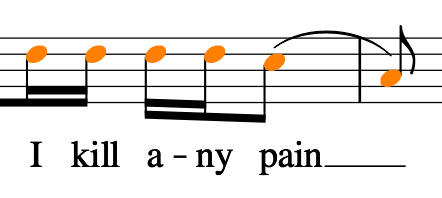

Fig. 4: Chorus


Part 1 comes across in a more vibrant, excited manner due to the “zig-zag” shape of the melody, concluding with a perfect fourth leap to the tonic. This jibes with and accentuates the lyrical content, “look what you’ve done,” due to its attention-grabbing quality, and provides a melodic question.
Part 2 soon answers the melodic question in an assured, cocky, matter-of-fact manner with its monotone delivery and drop down to the tonic to conclude.
Bridge
Line 1: Let a ni*-*a Brad Pitt
Line 2: Leg-end of the fall took the year like a ban-dit
Line 3: Bought mom-ma a crib and a brand new wag-on
Line 4: Now she hit the gro-c’ry shop look-in’ lav-ish
Line 5: Star Trek roof in that Wraith Of Khan
Line 6: Girls get loose when they hear this song
Line 7: A hun-dred on the dash get me close to God
Line 8: We don’t pray for love we just pray for cars
High: D4
Low: A3
The bridge features the most simplified melody in the scope of the song. It is composed of two melodic parts, each of which features a primarily monotone lead vocal delivery. The primary changeup occurs at the end of each line, which conclude with an alternating melodic ascent or descent. This provides the section as a whole with a very engaging flow.
The bridge is centered around monotone runs on C and B, the third and second scale degrees in the song’s key, A minor, respectively. This provides the bridge with an overall more consonant and melodic feeling as those pitches are chord tones over the bass notes on which they fall (i.e. C over A in the first bar, B over G in the second, C over F in the third, and B over G in the fourth.)
Bridge Melodic Direction: At-a-Glance
Verse 1 Melodic Direction Reference: At-a-Glance
Verse 2 Melodic Direction Reference: At-a-Glance
Pre-Chorus Melodic Direction Reference: At-a-Glance
Chorus Melodic Direction: At-a-Glance (Lead Vocal Only)
Bridge Melodic Part Structure: At-a-Glance


Lines in the bridge range from 6 to 12 syllables. Each line in the first stanza except for line 1 are very close in their respective syllable counts (11 and 12). Line 1 is around half the length of the others with 6. The first two lines in the second stanza both feature 8 syllables, and the last two are close to being in line with the first stanza with 11 and 10, respectively.
In-Line Segmentation:
None.
Cross-Line Segmentation:
Lines in the first stanza run straight through without a pause. Lines in the second stanza are subtly segmented from one another by the prolonged lyric at the end (“Khan,” “song,” “God,” “cars”).
Line 1: Let a nig-ga Brad Pitt
Line 2: Leg-end of the fall took the year like a ban-dit
Part 1a: “Let a ni*-*a Brad Pitt”
Line 1 is composed of part 1a. It features a monotone C sixteenth note progression up until the last two lyrics/syllables, which are eighth notes. Note that this is the only line in the entire section that features an entirely monotone run.
Part 2a: “Leg-end of the fall took the year like a ban-dit”
Line 2 is composed of part 2a. It begins a half step lower than line 1 on B, and follows a monotone progression right up until the last syllable, which DROPS DOWN to the tonic, A, to conclude.
The line is comprised primarily of sixteenth notes, with a couple of eighth notes interspersed that provide an engaging rhythm and emphasize the associated lyrics:
“Leg-end of the fall took the year like a ban-dit”
Line 3: Bought mom-ma a crib and a brand new wag-on
Line 4: Now she hit the gro-c’ry shop look-in’ lav-ish
Part 1b: “Bought mom-ma a crib and a brand new wag-on”
Line 3 is composed of part 1b. It returns to the pitch that housed the monotone run in line one, C, and resides there up until the last syllable, where it ASCENDS to D. Note that this is essentially the same melodic progression as line 1 save for the melodic ascent at the end.
Rhythmically it starts off the same as line 2, which accentuates the memorability factor:
The rhythm is changed up at the end, however, concluding with a succession of four eighth notes as opposed to two. This, along with the melodic direction reversal prevents cookie-cutter monotony from occurring and suits the lyrics: “brand new wag-on”.
Part 2b: “Now she hit the gro-c’ry shop look-in’ lav-ish”
Line 4 is composed of part 2b. It features the same melodic shape as line 2, with the primary difference being the concentration of eighth notes in the middle, which provide it with an altered rhythmic flow.
Line 5: Star Trek roof in that Wraith Of Khan
Line 6: Girls get loose when they hear this song
Part 1c: “Star Trek roof in that Wraith Of Khan”
Line 5 is composed of part 1c. While it features the same melodic shape as line 3/part 1b (a succession of C notes followed by a step up to D at the end), it differs rhythmically. The most pronounced difference occurs at the beginning of the line due to the implementation of three eighth notes as opposed to sixteenth notes. These longer notes provide highly noticeable contrast at the beginning of the second stanza. The balance of the line consists of sixteenth, eighth, and quarter notes, which are arranged in a differentiated pattern compared to the other lines in the section.
Part 2c: “Girls get loose when they hear this song”
Line 6 is composed of part 2c. It possesses commonalities with both line 5/part 1c, as well as parts 2a and 2b:
- Part 1c commonality: It features the same general rhythmic structure.
- Part 2a and Part 2b commonality: It features the same general melodic shape. The only difference occurs at the end, where instead of simply dropping from B to A, the melody first steps up to C followed by a B-A descent to conclude on the stretched lyric, “song.” Although subtle, this melisma provides the line with an additional dose of color.
Line 7: A hun-dred on the dash get me close to God
Line 8: We don’t pray for love we just pray for cars
Part 1d: “A hun-dred on the dash get me close to God”
Line 7 is composed of part 1d. It is essentially a fusion of the rhythmic characteristics found in parts 1b and 1c, coupled with the same melodic shape as both except for on the first lyric, which begins on the tonic, A (this is the only time that this occurs in the section).
Fig. 4: Part 1b: The rhythm of the first seven syllables.


Fig. 5: Part 1c: The core rhythm of the last three syllables.
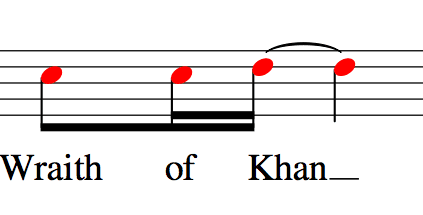

Part 1e / Part 2d: “We don’t pray for love / we just pray for cars”
Line 8 is unique in the scope of the section in that it features a two-part structure that embodies characteristics from both the part 1’s and the part 2’s:
Part 1:
- Line 8 BEGINS with the same rhythm as found at the END line 7.
- The first phrase on line 8, “we don’t pray for love,” concludes with an ascent up to D, which is the same manner in which line 7 concludes
Part 2:
- The first phrase, “we don’t pray for love,” features a monotone B progression.
- The rhythm and melody that defines the second phrase, “we just pray for cars,” is identical to the conclusion of line 6/part 2c.
Essentially, the combination of part 1 and part 2 characteristics cleverly ties the melodic and rhythmic themes of the section together on one line.
(Shows the percentage of total lines in the song that contain a particular lyrical characteristic. Note that lines can contain two or more lyrical characteristics)
The majority of Starboy is rich in detail. What follows are a couple of examples from each section. Reference the Story Flow & Meaning section of the report for a full narrative analysis.
- Milli point to just to hurt you, ah
- Main bitch out of your league too, ah
- I come alive in the fall time-ime
- Pockets overweight getting’ hefty, ah
- House so empty need a centerpiece
- Twenty racks a table cut from ebony
- I’m a mother f**kin’ Starboy
- Bought momma a crib and a brand new wagon
- Now she hit the grocery shop lookin’ lavish
- All red Lamb just to tease you, ah
- P1 cleaner than your church shoes, ah
- Pull off in that roadster SV, ah
- I’m in the blue Mulsanne bumpin’ New Edition
- House so empty need a centerpiece
- Twenty racks a table cut from ebony
- Cut that iv’ry into skinny pieces
- Then she clean it with her face, man I love my baby
- I, switch up my cup I kill any pain
- None
- Bought momma a crib and a brand new wagon
- Now she hit the grocery shop lookin’ lavish
- Star Trek roof in that Wraith Of Khan
- A hundred on the dash get me close to God
- Made your whole year in a week too, yah
- Ev’ry day a ni**a try to test me, ah
- Ev’ry day a ni**a try to end me, ah
- House so empty need a centerpiece
- None
- Legend Of The Fall took the year like a bandit
- Now she hit the grocery shop lookin’ lavish
- I’m tryna put you in the worst mood, ah
- Ev’ry day a ni**a try to test me, ah
- Ev’ry day a ni**a try to end me, ah
- Comin’ for the king that’s a far cry-y
- I come alive in the fall time-ime
- I’m in the blue Mulsanne bumpin’ New Edition
- Cut that iv’ry into skinny pieces
- Then she clean it with her face, man I love my baby
- You talkin’ money need a hearin’ aid
- Switch up my style I take any lane
- I, switch up my cup I kill any pain
- None
- Bought momma a crib and a brand new wagon
- Now she hit the grocery shop lookin’ lavish
- Girls get loose when they hear this song
- A hundred on the dash get me close to God
- I’m tryna put you in the worst mood, ah
- Milli point to just to hurt you, ah
- All red lamb just to tease you, ah
- Comin’ for the king that’s a far cry-y
- I come alive in the fall time-ime
- No competition I don’t really listen
- Then she clean it with her face, man I love my baby
- You talkin’ ‘bout me I don’t see the shade
- Switch up my style I take any lane
- I, switch up my cup I kill any pain
- I’m a mother f**kin’ Starboy
- Girls get loose when they hear this song
- A hundred on the dash get me close to God
- “ah” or “yah” (all lines)
- “ah” (lines 1 – 4)
- “Ha, ha” (background vocals
Song titles fall within one of two categories – those that are unique, clever, attention grabbing and/or possess a powerful nature (e.g. “Black Beatles”, “Broccoli,” “Heathens,” “Panda”), and those that possess more of a universal/generic characteristic (e.g. “Can’t Stop The Feeling”, “Let Me Love You,” “We Don’t Talk Anymore”).
Starboy falls into the former. Taken out of context of the song’s narrative, the prospective listener does not know what Starboy specifically relates to – does it pertain to outer space, or the stature of The Weeknd? As a result, their curiosity is piqued to check out the song and find out what it’s all about. Taken within the context of the narrative, the listener finds out that it is the latter.
Starboy appears eight times throughout the song. It is featured exclusively in the chorus sections and is the last lyric in each stanza.
Line 1/5: (Ha-ha…)
Line 2/6: Look what you’ve done
Line 3/7: (Ha-ha…)
Line 4/8: I’m a mother f**kin’ Starboy
There are a couple of characteristics that accentuate the impact of the title lyric “Starboy” in addition to its connotation relating to the narrative:
Line Affiliation
The title lyric is connected to one of, if not the most powerful line in the entire song, “I’m a mother f**kin’ Starboy.” As a result, its impact is heightened compared to other lines within the song.
Anticipation Build / Wait For It Moment
The impact of “Starboy” is structurally and lyrically accentuated by the prolonged wait for it moment that is put into effect by the rests in between the lead vocal lyrical setup (“look what you’ve done”) and payoff (“I’m a mother f**kin’ Starboy”).


Starboy is a lifestyle and boasting themed song that revolves around specifics relating to The Weeknd’s wealth, possessions, women, and stature.
Certain lines in the verse and pre-chorus sections feature cross-line repetition, ranging from just a few lyrics to almost full lines. The repetition provides familiarity which makes these sections resonate stronger, and also lightens the songwriter’s workload in the process. Sometimes just changing up a single lyric can communicate a great deal without the need to add a lot more content. This technique was also utilized in The Weeknd’s previous mega hit, Can’t Feel My Face.
Verse 1:
Line 3: Milli point two just to hurt you, ah
Line 4: All red Lamb just to tease you, ah
Line 7: Main bitch out of your league too, ah
Line 8: Side bitch out of your league too, ah
Verse 2:
Line 1: Ev’ry day a ni**a try to test me, ah
Line 2: Ev’ry day a ni**a try to end me, ah
Pre-Chorus
Line 5: You talkin’ money need a hearin’ aid
Line 6: You talkin’ ‘bout me I don’t see the shade
Line 7: Switch up my style I take any lane
Line 8: I, switch up my cup I kill any pain
There are a few instances of clever word play and cryptic meanings that accentuate the impact of the narrative.
- Bridge – line 5: “Star Trek roof in that Wraith Of Khan”
This line cleverly references the Rolls Royce Wraith customized by Khan (which features starry lights on the ceiling) as well as the 1982 Star Trek movie, Wrath Of Khan.
- Verse 2 – line 5: “Comin’ for the king that’s a far cry”
- Verse 2 – line 6: “I come alive in the fall time”
These two consecutive lines cleverly reference The Weeknd’s 2014 song and tour of the same name, King of the Fall, and possibly relate to Starboy’s release date – September 22, 2016 – which also happens to be the first day of fall. As a result, this is when The Weeknd “came alive” to support the single.
- Pre-Chorus – line 2: “Twenty racks a table cut from ebony”
- Pre-Chorus – line 3: “Cut that iv’ry into skinny pieces”
These two consecutive lines cleverly feature an “ebony” / “ivory” reference, which is subject to interpretation by the listener (e.g. the Paul McCartney/Stevie Wonder song of the same name, etc.).
There are eight different topics that The Weeknd boasts about throughout the song. The change in topics from section to section helps to keep the narrative engaging while the overall boasting theme remains in effect.
- Verse 1: Cars, wealth and women
- Verse 2: Cars, wealth and status
- Pre-Chorus: Furniture, wealth
- Chorus: Self, success
- Bridge: Good deeds (i.e. the car for “mama”), tour promotion and implied success, cars, wealth, and women.
The prevailing topic that the protagonist boasts about throughout the song is his cars. Six different types of cars are mentioned in the verse and bridge sections, all of which cost hundreds of thousands of dollars or more, with the exception possibly being the wagon, as no specific model is mentioned.
McLaren P1 ($1 million +)
Red Lamborghini
Roadster SV
Blue Bentley Mulsanne
Rolls Royce Wraith (customized by Khan with lights on the ceiling)
Who The Weeknd Is Bumpin’ to in the Wraith
The hallmark of many mainstream hits is that they are conveyed in a universal manner, with the subject matter being applicable to the listener’s own life circumstances (i.e. most people can connect with a love lost scenario or overcoming adversity). Even if specific references are mentioned, such as Boulder, CO and the Rover featured in The Chainsmoker’s Closer, the overall jist of the narrative still connects with their target audience.
However, this is generally NOT the case in Starboy. Instead, the song relates exclusively to The Weeknd’s possessions, lifestyle and wealth, most of which are out of the reach of the typical listener. However, the narrative still connects with his target demographic because it provides insight into his life, which may be intriguing to them.
Key
Green Font: Protagonist communicating to the antagonist
Red Font: Protagonist making a general statement
The first verse features a two part/stanza structure, denoted as parts A and B. The section is communicated primarily in the first and second person, with the protagonist communicating directly to the antagonist.
Line 1: I’m tryna put you in the worst mood, ah
Line 2: P1 cleaner than your church shoes, ah
Line 3: Milli point two just to hurt you, ah
Line 4: All red Lamb just to tease you, ah
Line Opener: Attention Grabber / Protagonist Objective
The first line in a song is among the most important. Why? Because it should instantly engage the listener in the narrative and pique their curiosity for what comes next. This is exactly what the first line in Starboy achieves:
“I’m tryna put you in the worst mood, ah”
In contrast to hit songs that have the objective of making the listener feel GOOD (or at least indifferent), The Weeknd goes against the grain by stating his objective is to try and put the listener, or whomever the antagonist may be, in the WORST mood. Not only is this his objective in the first verse, but the majority of the song.
The potency of the line coupled with its atypical connotation effectively gains the listener’s attention and piques their curiosity as to what Starboy is all about.
Lines 2, 3, 4: Boasting & Dissing / Car & Wealth Lifestyle Themes
The other lines in the section feature the protagonist boasting his possessions – namely his cars. However, note that in the process of boasting he is also dissing the antagonist as well, effectively trying to “put them in the worst mood” as established on line 1.
Line 5: None of these toys on lease too, ah
Line 6: Made your whole year in a week too, yah
Line 7: Main bitch out of your league too, ah
Line 8: Side bitch out of your league too, ah
Lines 5 & 6: Boasting & Dissing / Car & Wealth Lifestyle Themes (Continued)
Lines 5 is the last instalment in the first verse of the protagonist boasting and dissing about his cars and wealth as depicted in part A – specifically that his “toys” (i.e. cars) aren’t “on lease.”
Line 6 shifts gears by switching from the car theme to pure wealth. Here he once again boasts and disses concurrently by stating, “made your whole year in a week too.” Note that the switch away from the car theme was warranted in order to help prevent it from becoming overly monotonous, as it plays a role in subsequent sections as well.
Lines 7 & 8: Boasting & Dissing / Woman Lifestyle Theme
Lines 7 and 8 maintain the boasting/dissing theme that defines lines 1 – 6, with the subject matter being changed to women. This changeup helps to accentuate the engagement value of the section due to the narrative contrast imparted.
Notice that the gist of lines 7 and 8 are the same – that the protagonist’s women (communicated in a street, derogatory manner) are “out of the league” of the antagonist. The only difference between the lines is first lyric, “main” and “side,” which provides additional insight into the protagonist’s lifestyle, and further rubs it in that both his primary AND secondary (“main” and “side”) women are out of the antagonist’s league.
The pre-chorus features a two part/stanza structure, denoted as parts A and B. The section is communicated in the first, second and third person.
Line 1: House so empty need a centerpiece
Line 2: Twenty racks a table cut from ebony
Line 3: Cut that iv’ry into skinny pieces
Line 4: Then she clean it with her face, man I love my baby
Lines 1 & 2: Emptiness / Wealth
Lines 1 and 2 are unique in the scope of the song in that they are the only lines that reference the protagonist’s house and furniture. While line 1 is quite vague and subject to further interpretation by the listener (i.e. is it about aesthetics, a metaphor that the protagonist needs someone or something important in his life, etc.), line 2 is more clearly defined, where the protagonist boasts about his twenty thousand dollar (“twenty racks”) “table cut from ebony.”
Lines 3 & 4: Lifestyle / Drugs (possibly)
Lines 3 and 4 are also unique in the scope of the song in that they bring The Weeknd’s significant other into the mix via “my baby,” coupled with the implied action of her snorting drugs (“cut that iv’ry into skinny pieces / then she clean it with her face”). What isn’t known is if The Weeknd truly loves her (i.e. she being the “centerpiece” he’s looking for to fill his empty house) or if he just loves partying with her. Regardless of which interpretation the listener chooses, this development in part A of the pre-chorus provides the song with additional dimension and engagement value.
Line 5: You talkin’ money need a hearin’ aid
Line 6: You talkin’ ‘bout me I don’t see the shade
Line 7: Switch up my style I take any lane
Line 8: I, switch up my cup I kill any pain
Lines 5 & 6: Imperviousness
Lines 5 and 6 switch things up by introducing the second person P.O.V. in the section (i.e. “you”). Here the protagonist essentially conveys people talking about him don’t have any impact on him. This expounds on people trying to “test” and “end” him as depicted in the bridge.
Lines 7 & 8: Lifestyle / Doing Things His Way
Line 7 ties in with the protagonist’s “no competition I don’t really listen” declaration in the bridge. His “style” can pertain to his look, his music, his overall lifestyle, etc. He switches it up as he sees fit. The “switch” on line 8 pertains to his self-medicating.
Notice the repetition of lyrics in each line group. Lines 5 and 6 both begin with “you talkin’,” and lines 7 and 8 begin with “switch up my.” The repetition cleverly makes the section easier to remember while concurrently introducing developments in the narrative.
The chorus features a two part/stanza structure, denoted as parts A and B. Both parts/stanzas feature the same lyrical content. The section is communicated in the first and second person.
Line 1: (Ha-ha…)
Line 2: Look what you’ve done
Line 3: (Ha-ha…)
Line 4: I’m a mother f**kin’ Starboy
Line 5: (Ha-ha…)
Line 6: Look what you’ve done
Line 7: (Ha-ha…)
Line 8: I’m a mother f**kin’ Starboy
Summation of the narrative
As is the primary lyrical function of the chorus, it provides the summation of the narrative depicted in the verse, pre-chorus and bridge sections. All of the boasting about the protagonist’s wealth, possessions, and lifestyle is aimed at an undefined antagonist, who may be his audience, the music industry, and/or others.
Even numbered lines
The even numbered lines in the section feature The Weeknd’s lead vocal. Line 2, “look what you’ve done,” functions to set up the song’s primary lyrical payoff, “I’m a mother f**kin’ Starboy.” Note the following about the payoff:
- It is the only line in the song that features the song title, “Starboy.”
- It features the protagonist boasting directly about himself.
- Its impact is lyrically accentuated by the lyrics “I’m a mother f**kin’.”
Its impact is structurally accentuated by the anticipation laden, prolonged wait for it moment that is put into effect by the rests in between the lead vocal lines (i.e. “look what you’ve done” wait for it…”I’m a mother f**kin’ Starboy”).
Odd numbered lines
The odd numbered lines in the section feature the signature Daft Punk vocoder-effected “ha” background vocals. In addition to functioning as an additional infectious vocal element, they provide the section with a mocking connotation, as the protagonist is seemingly laughing at and taunting everyone who helped get him where he is – either in a positive or negative manner.
The second verse features a two part/stanza structure, denoted as parts A and B. In contrast to the first verse, the second verse is communicated in only the first and third person. The protagonist’s boasting and dissing directly to the antagonist (i.e. “you”) has been switched to non-party specific declarations.
Line 1: Ev’ry day a ni**a try to test me, ah
Line 2: Ev’ry day a ni**a try to end me, ah
Line 3: Pull off in that roadster SV, ah
Line 4: Pockets overweight getting’ hefty, ah
Lines 1 & 2: Lifestyle / Facing Adversity
Lines 1 and 2 provide an engaging development in the narrative compared to the first verse. Instead of continuing on with boasting and dissing about his extravagant lifestyle, the protagonist instead sheds light on the problems that he’s facing – specifically that people (once again communicated in a street, derogatory manner) are trying to “test” and “end” him on an everyday basis. This provides the narrative with more of a serious connotation, and engages the listener further with its potency.
Lines 3 & 4: Boasting / Car & Wealth Lifestyle Themes
The last two lines in the section switch up the narrative once again by reverting back to the protagonist boasting about his cars and wealth as initially depicted in the first verse. However, notice that the diss aspect has been omitted this time around, as the protagonist is simply stating these facts in a generalized manner.
Line 5: Comin’ for the king that’s a far cry-y
Line 6: I come alive in the fall time-ime
Line 7: No competition I don’t really listen
Line 8: I’m in the blue Mulsanne bumpin’ New Edition
Lines 5 & 6: Boasting / The Weeknd Specific Song & Tour References
Lines 5 and 6 provide an engaging shift in the narrative as they both pertain to The Weeknd’s career as an artist, and are quite clever in that they collectively reference The Weeknd’s 2014 song and tour of the same name, King of the Fall. Note the following:
- Line 5 is connected to lines 1 and 2 in part A by referencing the people that are trying to “test” and “end” him in an indirect manner. His response is that there is little chance that it will happen, communicated by “a far cry.”
- Line 6 possibly references the release date of Starboy – September 22, 2016 – which also happens to be the first day of fall. As a result, the release of the song is when The Weeknd “came alive” to support the single.
Lines 7 & 8: Boasting / Career, Car, Wealth, and Music Lifestyle Themes
Line 7 continues on in the same vein as lines 5 and 6 with another reference to his career as an artist. Here he boasts that he has “no competition” (notice the tie in with line 5), and that he does things his way (i.e. “I don’t really listen”).
Line 8 returns once again to the car theme, this time depicting his “blue Mulsanne.” What’s different this time around is that additional detail is provided – specifically that he’s “bumpin’ New Edition” (a boy band that had its heyday in the 1980s). This heightens the engagement value of the section by providing additional insight into The Weeknd’s musical taste.
The bridge features a two part/stanza structure, denoted as parts A and B. The section is communicated in the first and third person, with the protagonist communicating in non party-specific declarations.
Line 1: Let a ni**a Brad Pitt
Line 2: Legend Of The Fall took the year like a bandit
Line 3: Bought momma a crib and a brand new wagon
Line 4: Now she hit the groc’ry shop lookin’ lavish
Lines 1 & 2: Actor & Movie Reference / Vailed 2017 Tour Plug
Lines 1 and 2 provide another engaging shift in the narrative where The Weeknd states the success of the 1994 movie, Legends Of The Fall, coupled with a nod to its leading actor, Brad Pitt. This statement cleverly ties in with lines 5 and 6 in second verse which reference his 2014 King of the Fall tour, and essentially brings it to the present by plugging his 2017 Starboy: Legend of the Fall tour. What’s clever is that this is done in an indirect manner – referencing Brad Pitt as opposed to himself.
Lines 3 & 4: Boasting / Familial Kindness
Lines 3 and 4 provide yet another shift in the narrative by bringing The Weeknd’s family into the equation – namely his mother. Although he is still boasting, it is toned down in relation to other sections in the song. Here his kindness toward his mother takes center stage, which displays the protagonist in a new light and provides the narrative with additional dimension and engagement value as a result.
Line 5: Star Trek roof in that Wraith Of Khan
Line 6: Girls get loose when they hear this song
Line 7: A hundred on the dash get me close to God
Line 8: We don’t pray for love we just pray for cars
Lines 5 & 6: Boasting / Cars, Clever Star Trek Reference, and Starboy’s impact on women
Line 5 returns to boasting about cars, this time around focusing on the protagonist’s Rolls Royce Wraith, which has been customized by Kahn Design. To communicate this, there is a clever play on words so that it reads, Wraith Of Khan. This is connected to the Star Trek movie, Wrath Of Khan, with the Star Trek reference referring to the lights on his “roof.”
Line 6 changes things up once again, with the protagonist boasting about the effect that Starboy the song has on girls, specifically that it makes them “get loose” (i.e. wanting to hook up). Note that this is the first and only time that a sexual reference is featured in the song.
Lines 7 & 8: Lifestyle / Cars, Living Fast and Reckless
While lines 7 and 8 both pertain to cars, which have been a recurring theme throughout the song, here the boasting element is removed. Instead, additional insight is provided into The Weeknd’s lifestyle – namely that he is living fast and reckless, which is implied by “a hundred on the dash get me close to God.” Line 8 provides an interesting and engaging shift due to The Weeknd communicating in the first person plural, “WE don’t pray for love, WE just pray for cars.” Here he’s not only summing up what can be gathered about himself through many of the lyrics found throughout the song, but also the shallowness of society in general.
This section compares Starboy to the 23 songs that landed in the Billboard Hot 100 Top 10 during Q4-2016
“D” Section: The sum of bridge, bridge surrogate and other changed up sections that provide a pronounced departure around two-thirds of the way into a song.
Starboy shares the following compositional characteristics that were most popular among the 23 songs that charted in the Hot 100 Top 10 during Q4-2016. The commonalities make it easier for a mainstream audience to connect with the song, especially in an airplay environment due to the familiarity they impart (i.e. the song isn’t coming out of left field which would cause the listener to have to work at connecting with the song).
Starboy being in-line with the most popular (#1) characteristics of Q4-2016’s Top 10 charting hits:
- Credited Songwriter Count: 5+ category
- Influences: Electropop
- Lyrical Theme: Love/Relationships
- Song Title Appearances: 6 – 10 Range (8 appearances)
- Song Title Placement: Chorus
- Prominent Instruments: Drums/Percussion
- Tempo: 90 – 99 BPM Range (93 BPM)
- Song Length Range: 3:30 – 3:59 Range (3:42)
- First Section: Intro
- Intro Length: 0:10 – 0:19 (15 seconds)
- First Chorus Occurrence (Percent Into Song): 20% – 29% Range (25%)
- Contains a Pre-Chorus: Yes
- Contain a Post Chorus: No
- Contains a “D” Section: Yes
- Contains an Instrumental Break: No
- Contains a Vocal Break: No
Lyrics: While boasting and lifestyle lyrical themes are common in the Top 10 – especially in the Hip Hop/Rap genre – the specific references to The Weeknd’s life provides Starboy with a unique quality that sets it apart from other mainstream hits.
Vibe: Put into effect by a combination of the timbre and progressions of instruments, the lead and background vocals, and the boasting/dissing lyrical content, Starboy’s dark, melancholic, self-assured, driving, grooving, unwavering vibe enables it to stand out among the majority of its current mainstream contemporaries.





